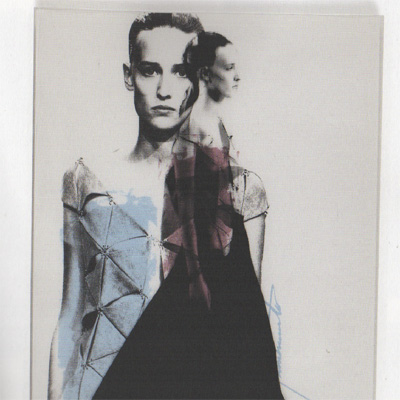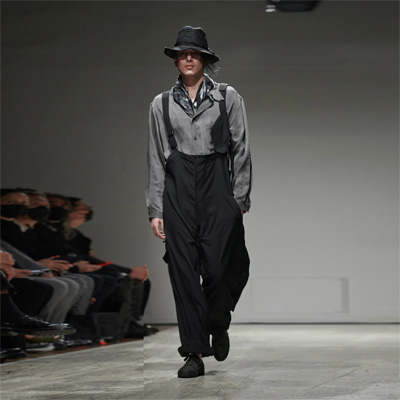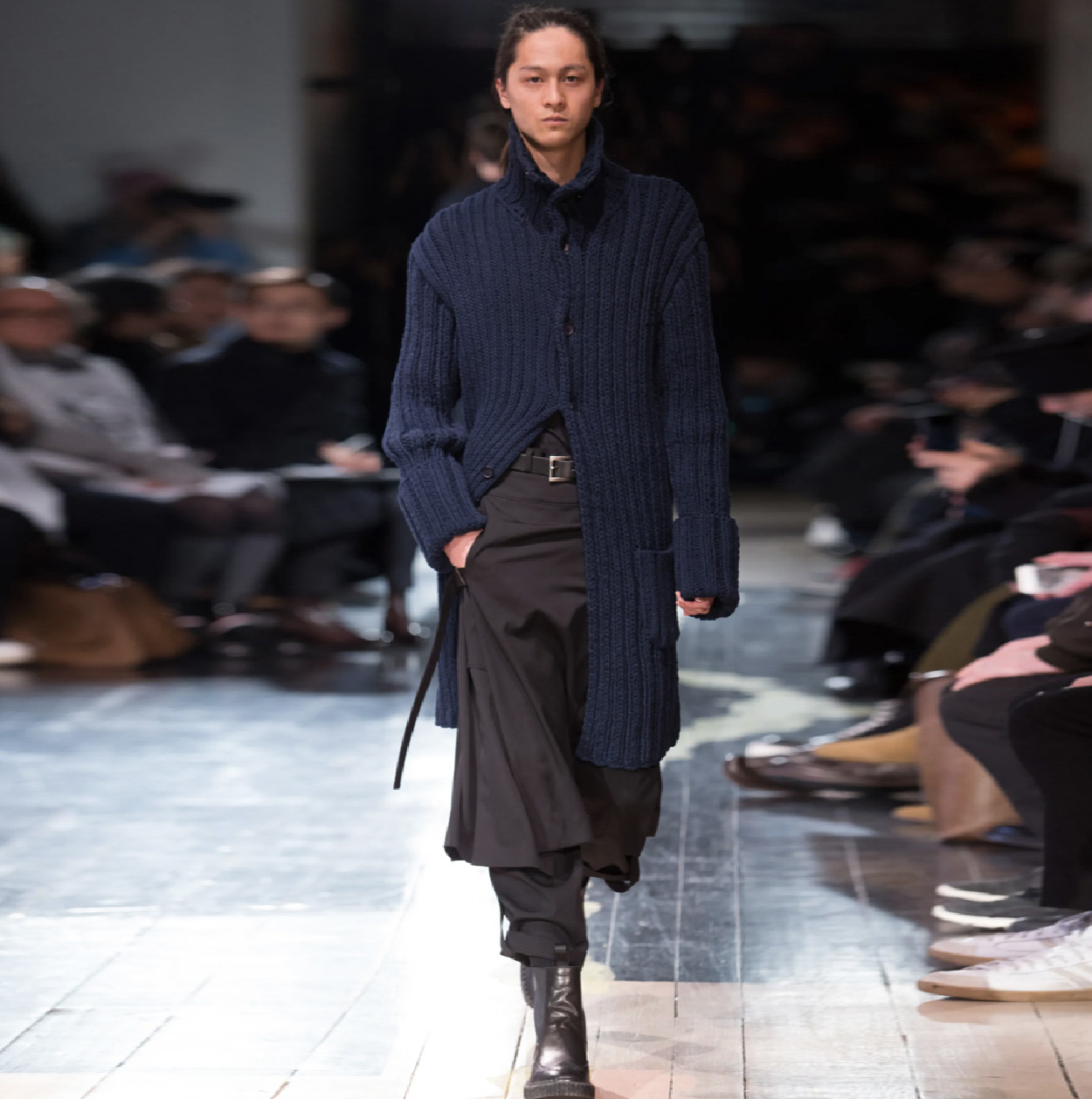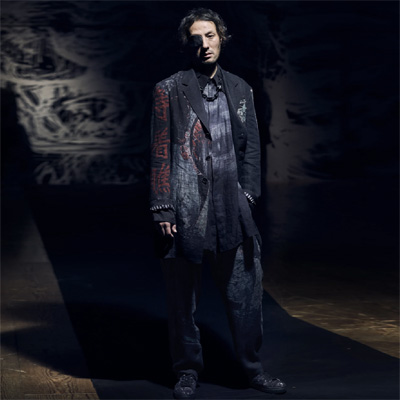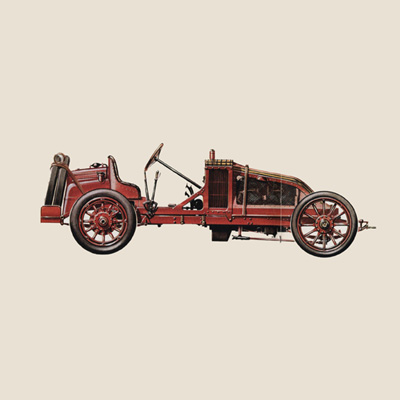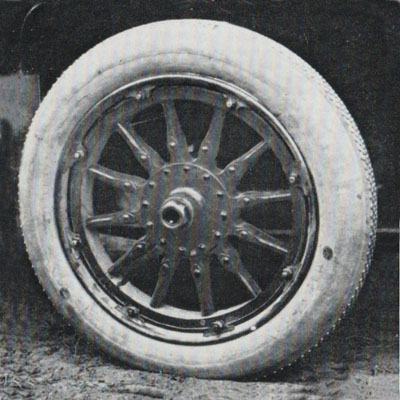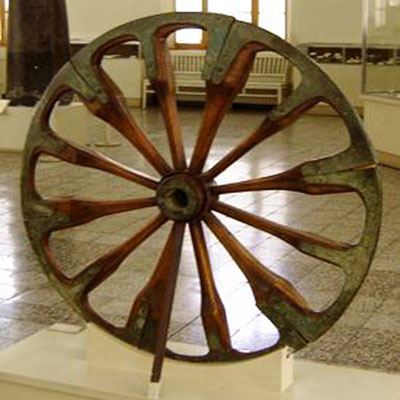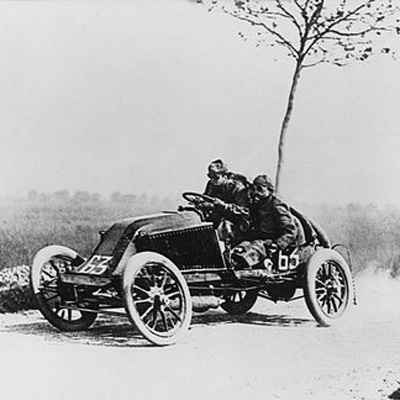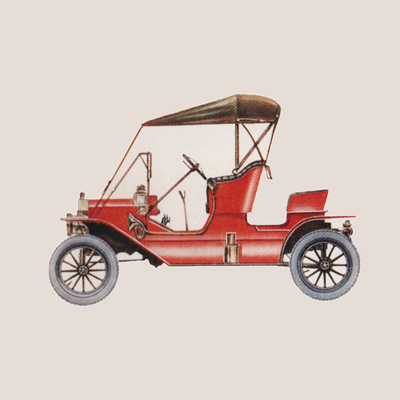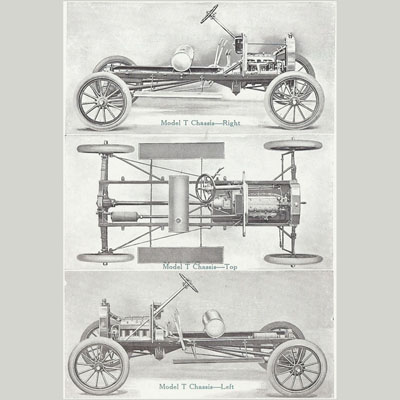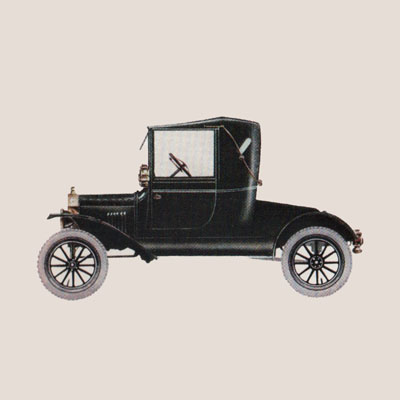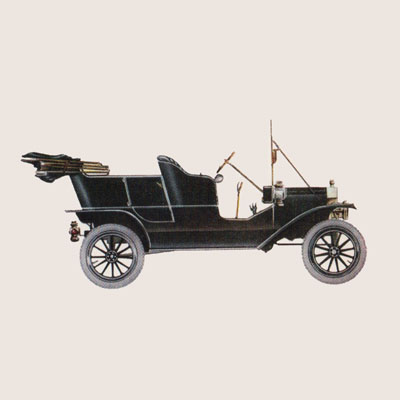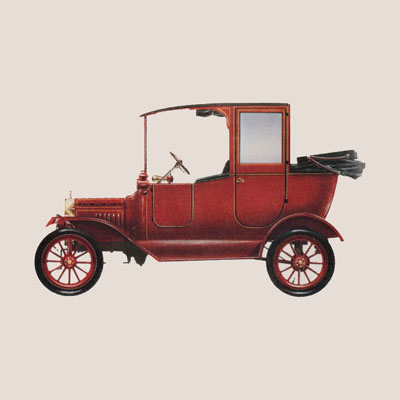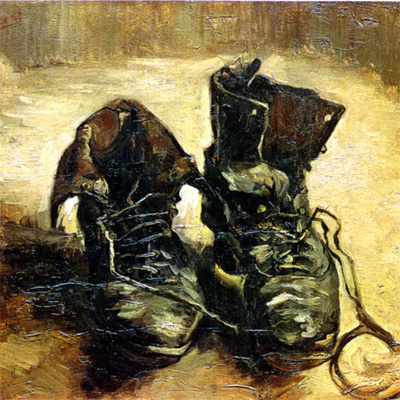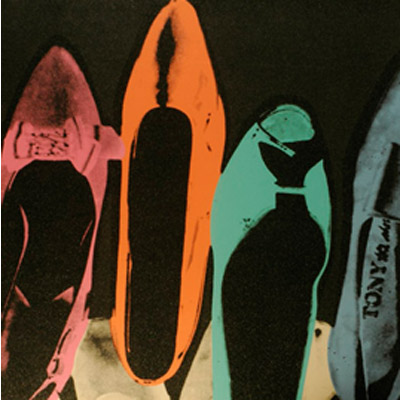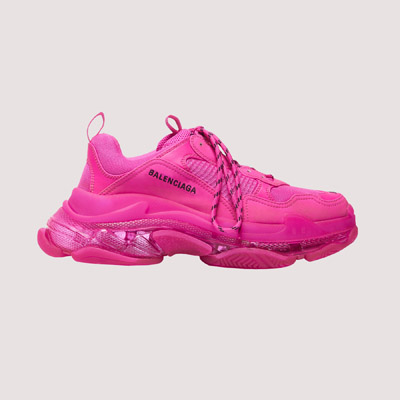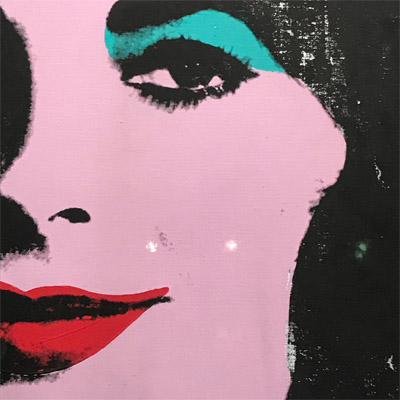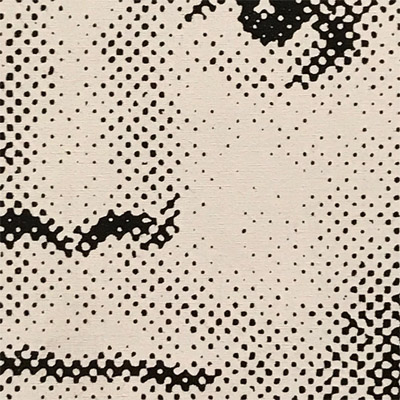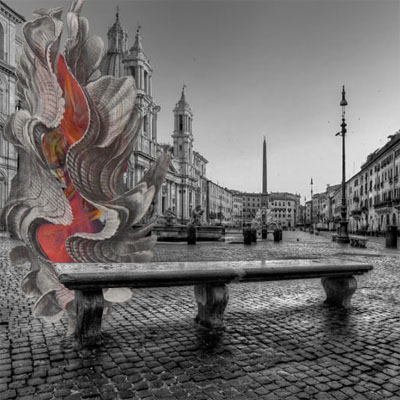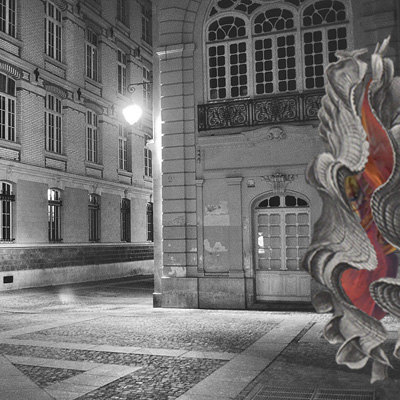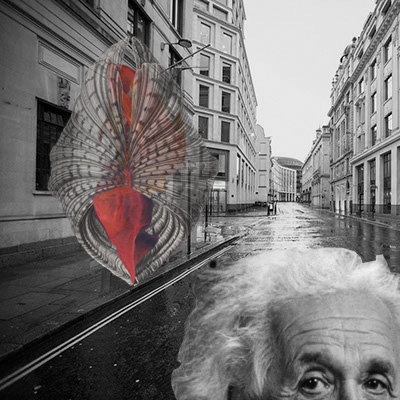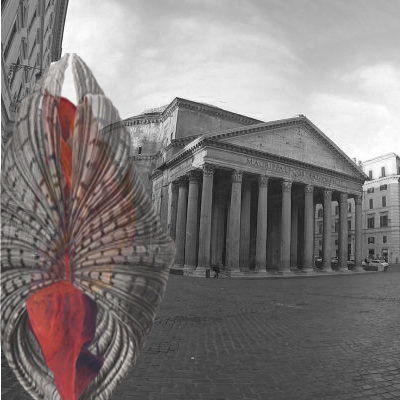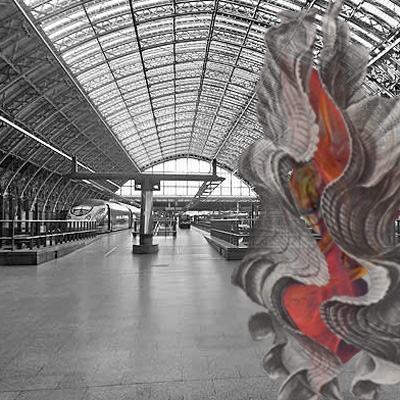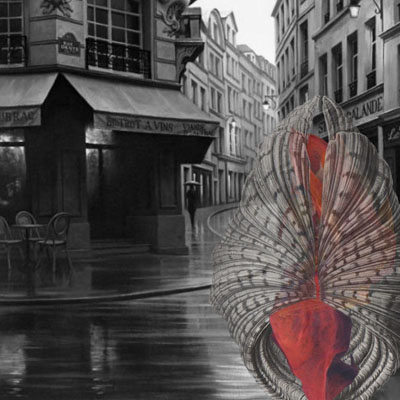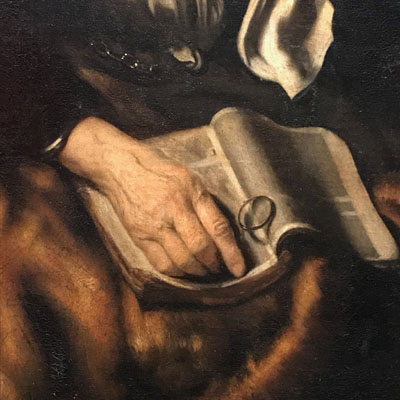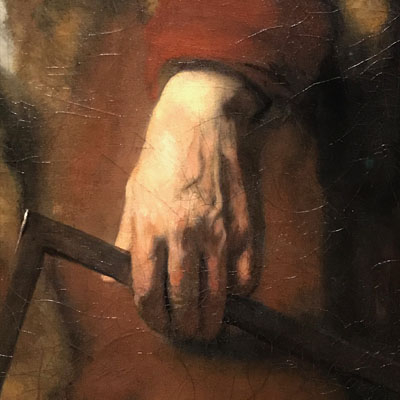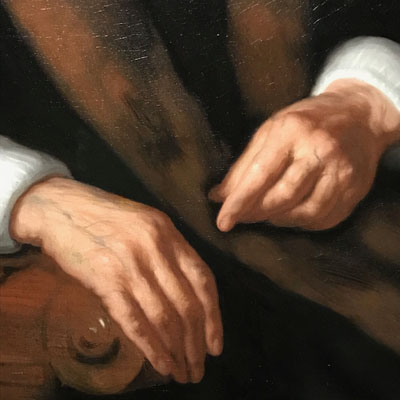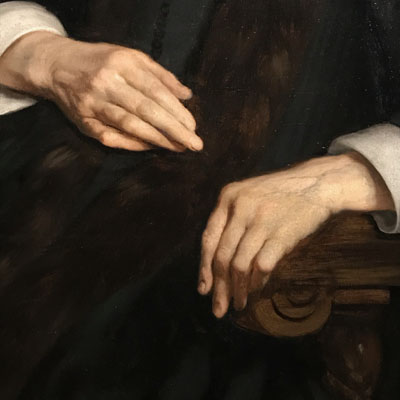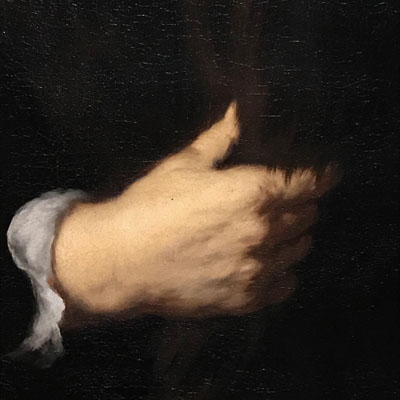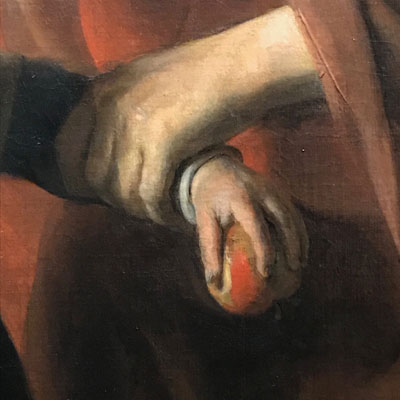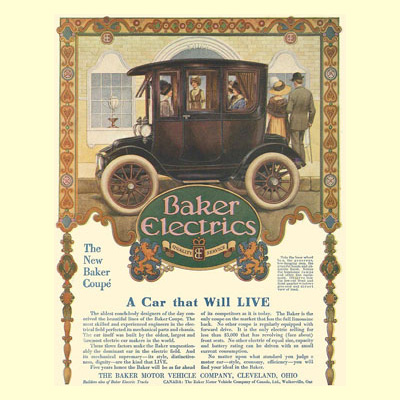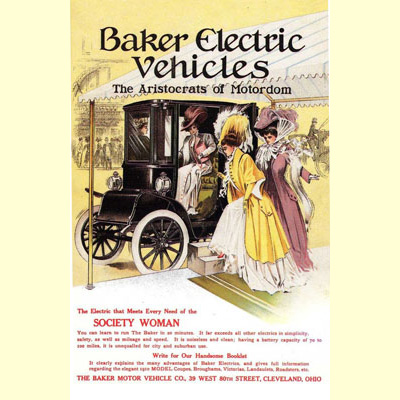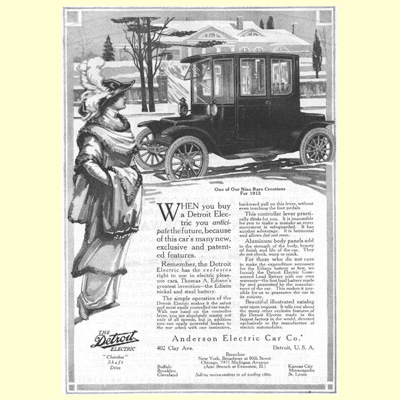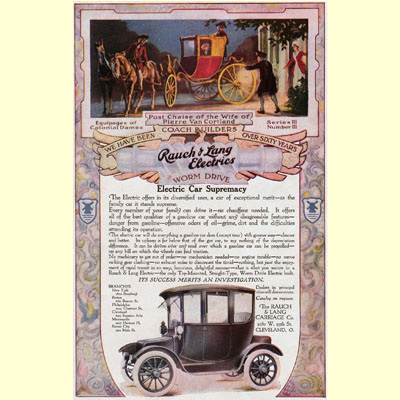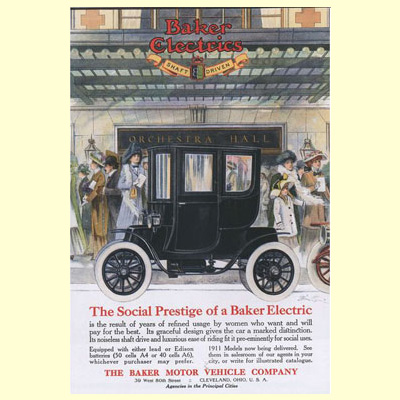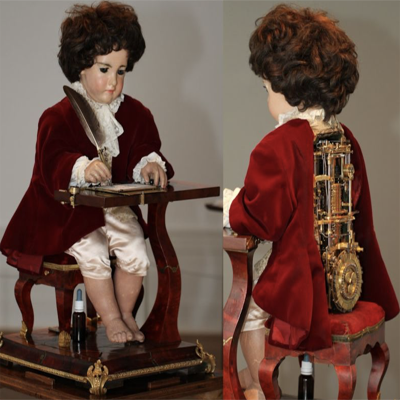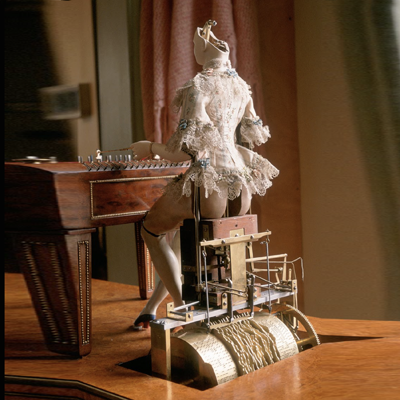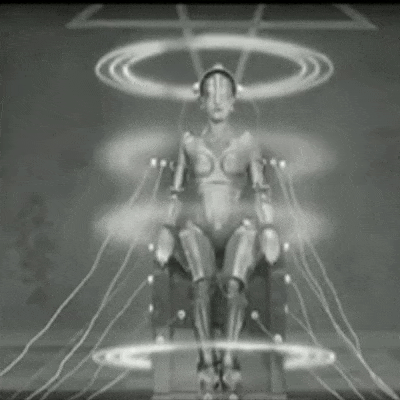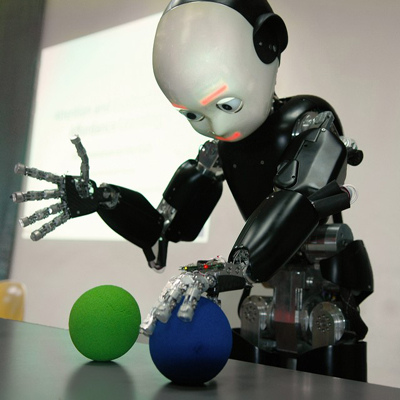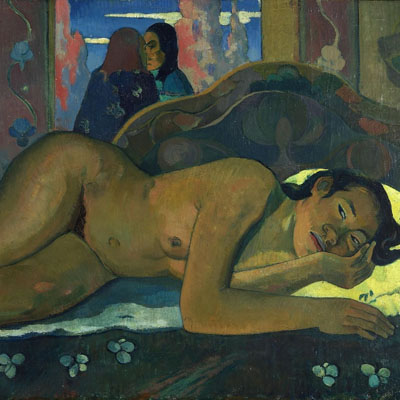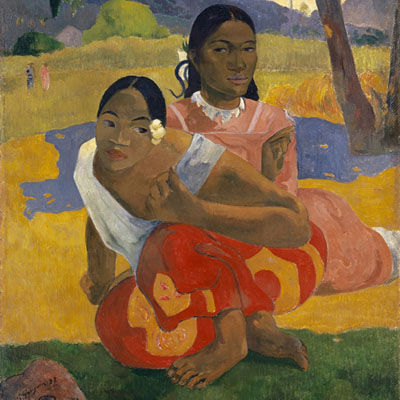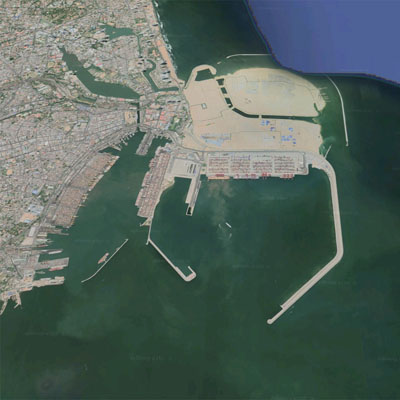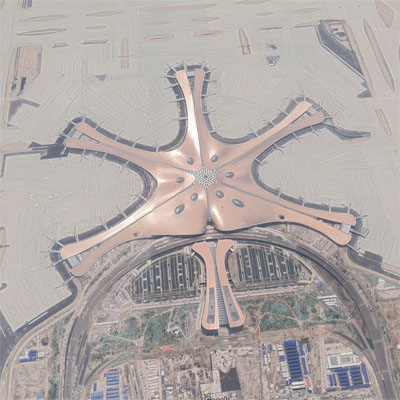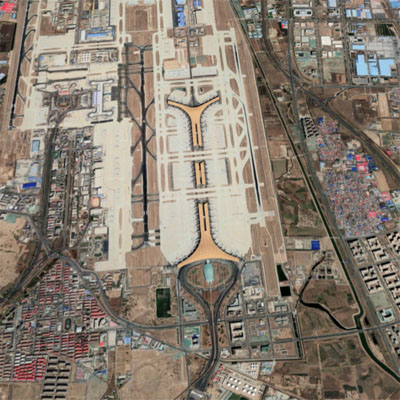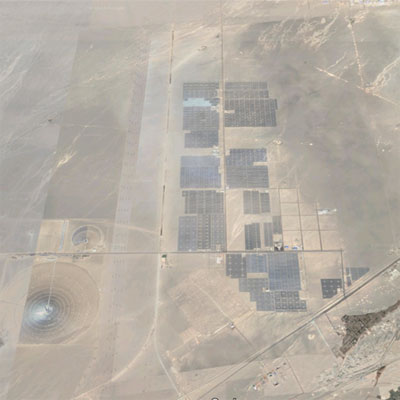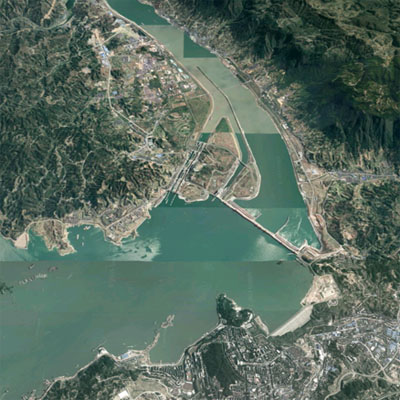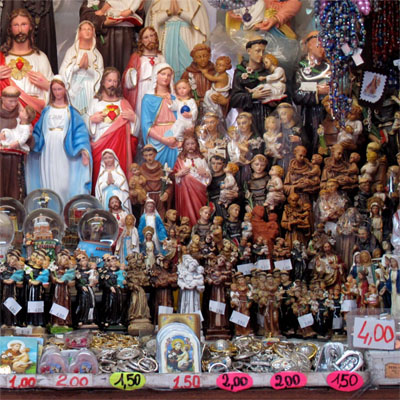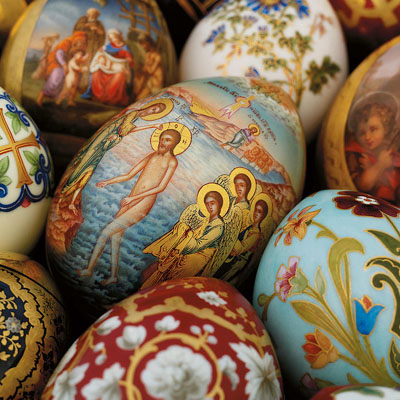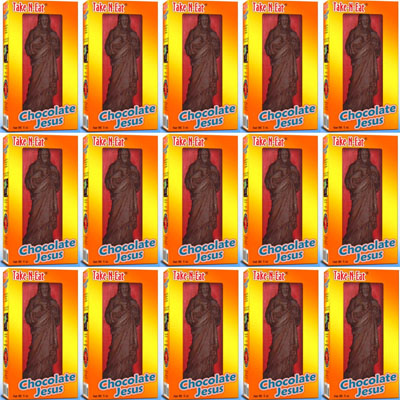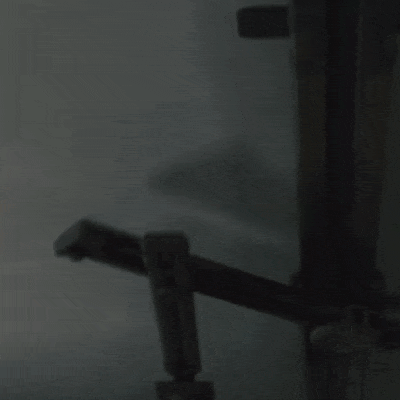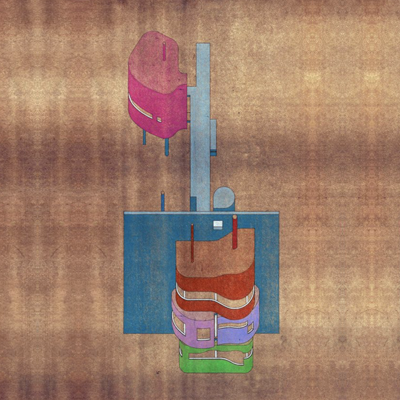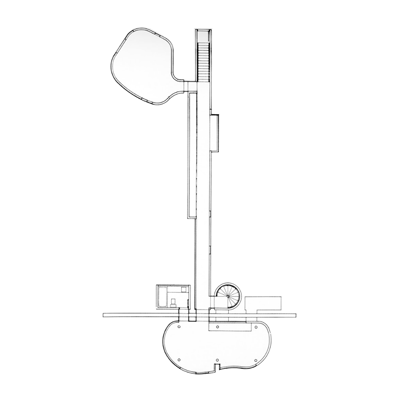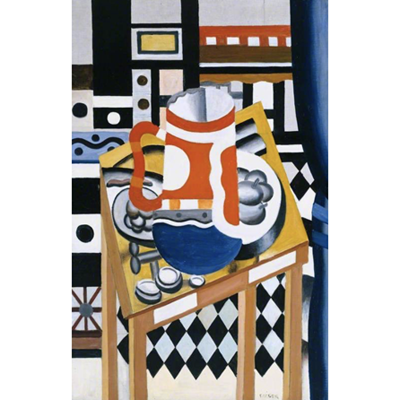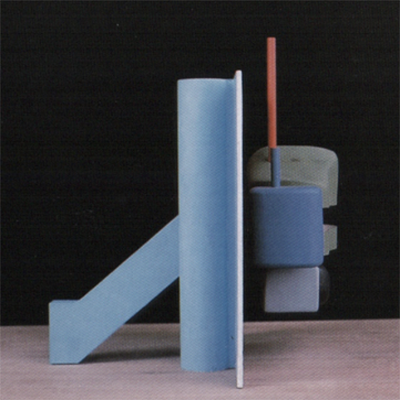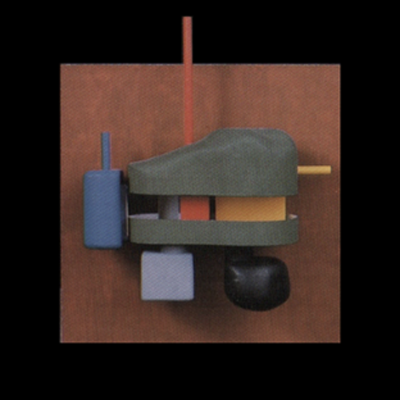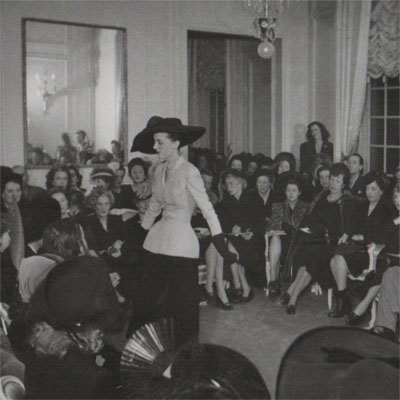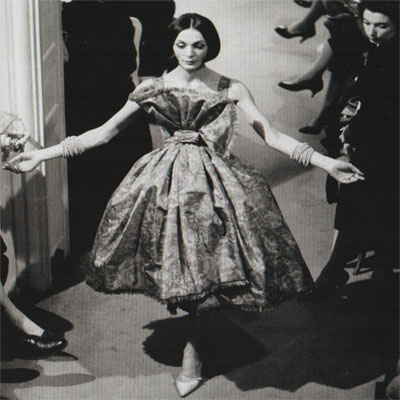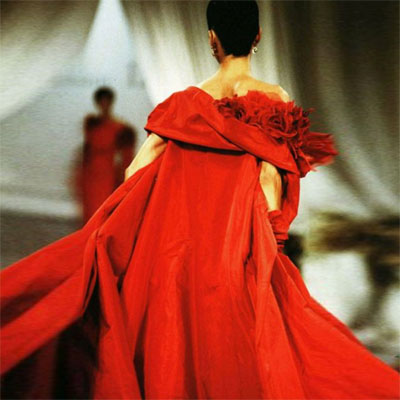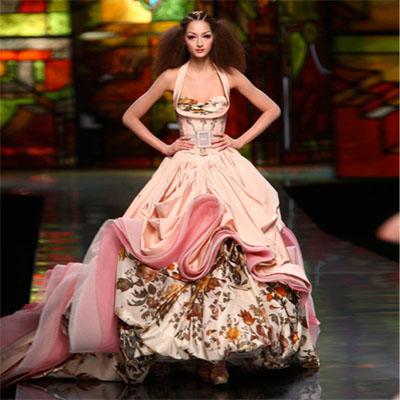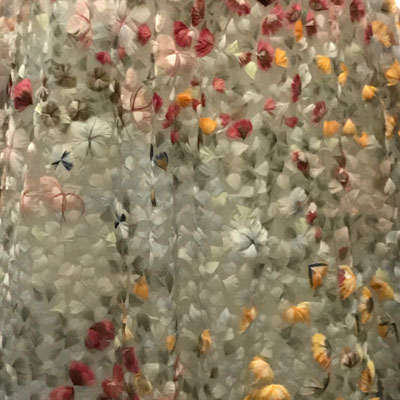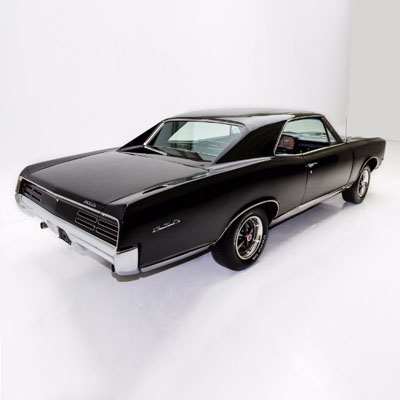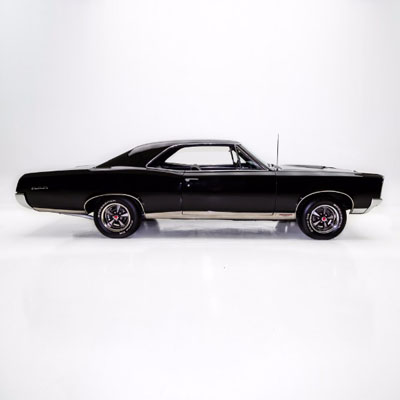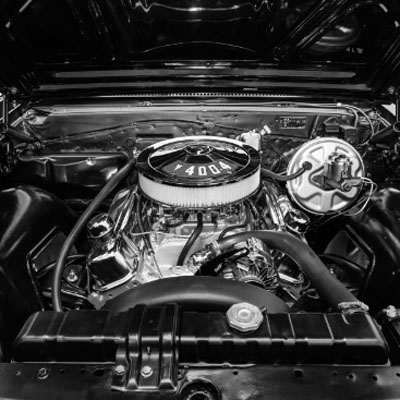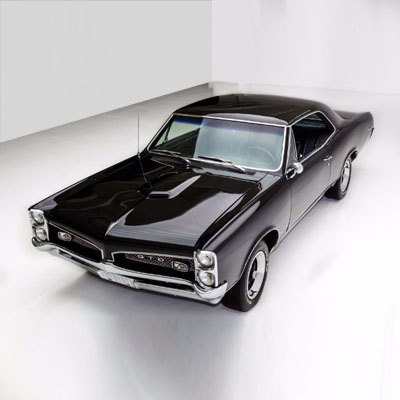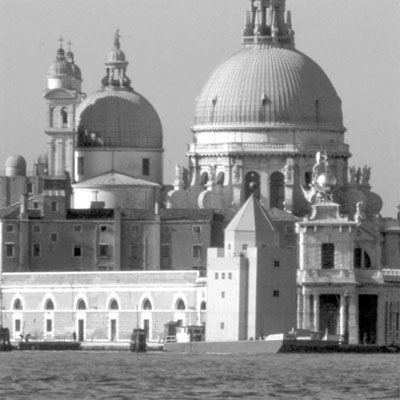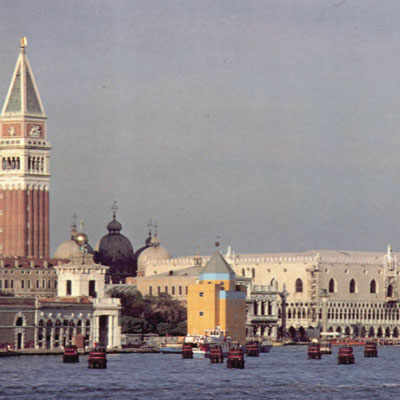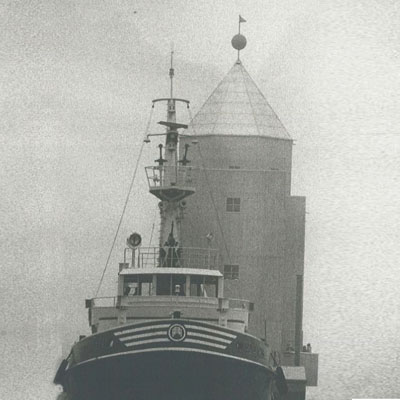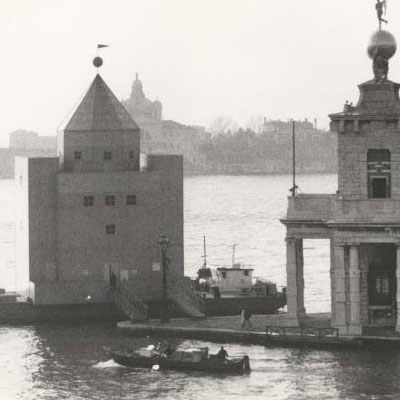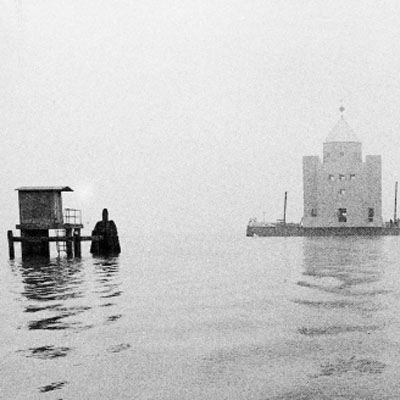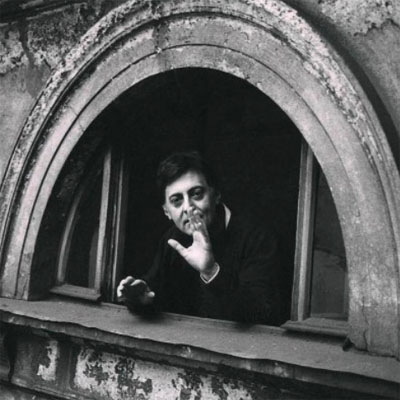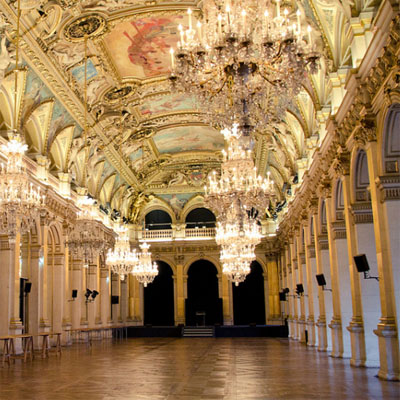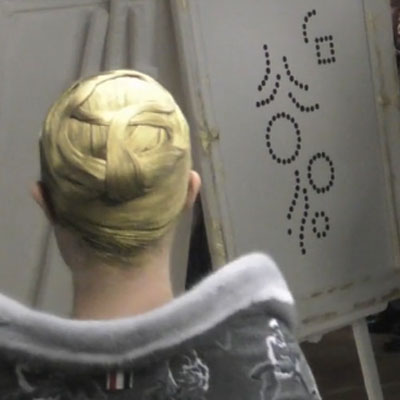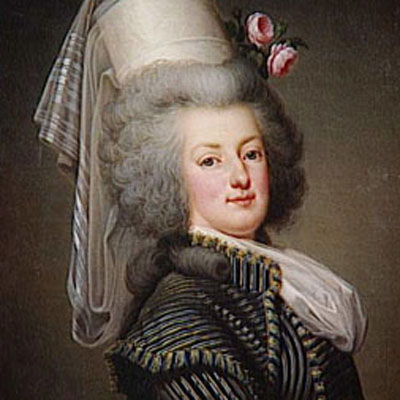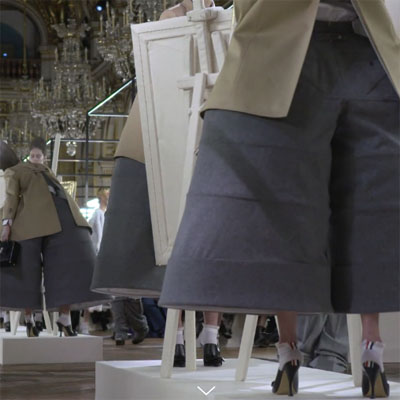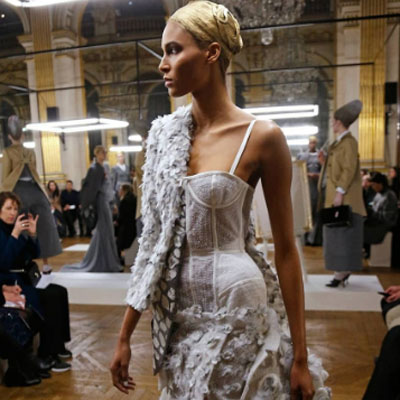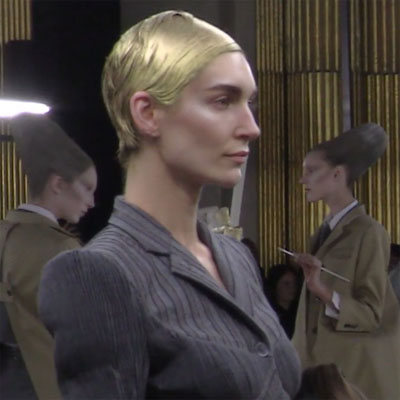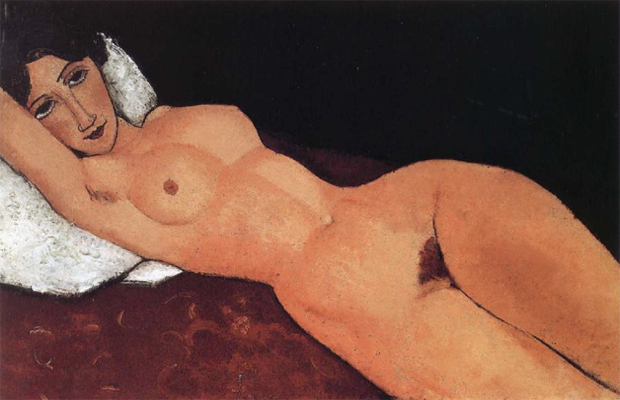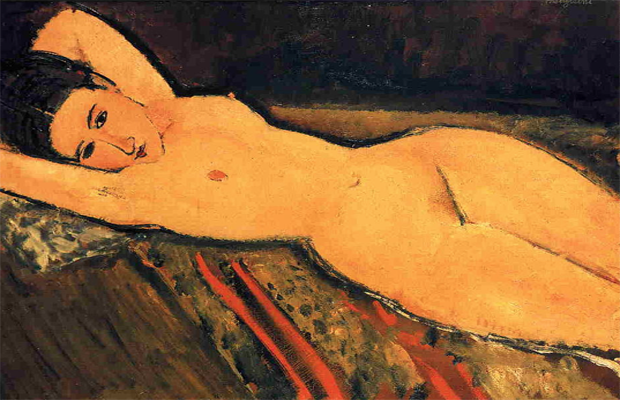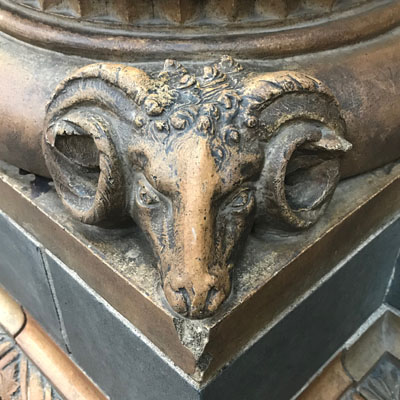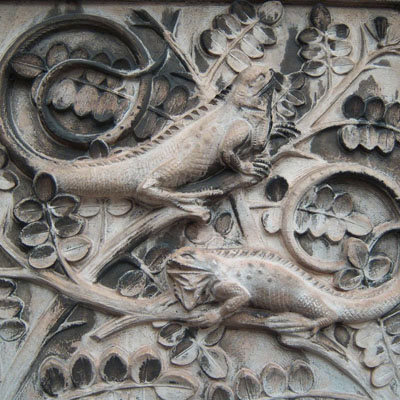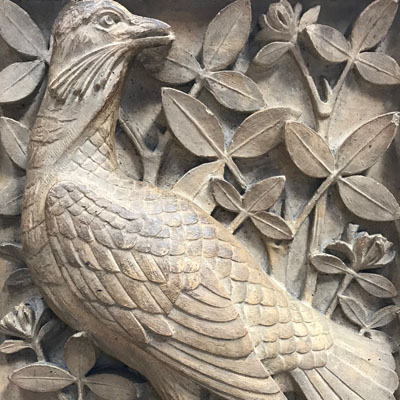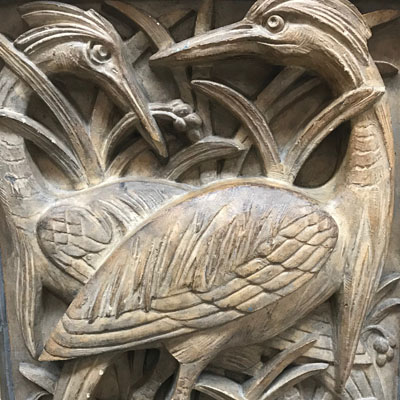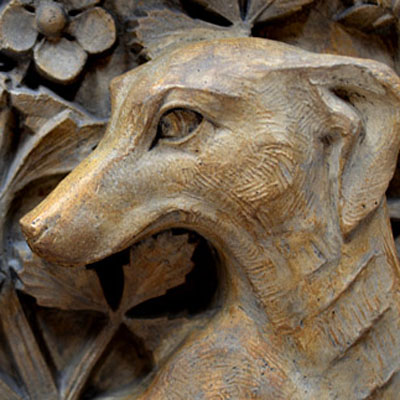230822 Yohji Yamamoto
> words
The ability for a textile to incorporate time, ageing, wear, and use all of these to enhance the garment throughout its history gives each item its exclusivity and longevity. Dyes fade over numerous washes, or bleach out under sunlight chronicling the wearer’s usage, each fold records its own rate or usage and through this exposure each garment reveals its own time map. This ageless quality of Yohji Yamamoto’s clothes along with the black aesthetic became the designer’s uniform throughout the 1990’s. With time the black aesthetic became less important and the ageless and more subtle qualities of Yohji’s clothes became more endearing. Ageless and classic are often the same term within design vocabulary.
Yohji Yamamoto’s interest in textiles is the basis of much of his work, within his designs he can give them strength and fragility to form. Whether a garment is hemmed or not hemmed, allowed to fall on the bias or is gathered and tied, the textile embodies the wearer and is imprinted over time through use, unique to the wearer. The textile in this way does not wear out or become redundant but instead becomes enriched and personalised. The clothes are styled in such a way that they evade fashion and seek to avoid the disposable churn incorporated into the two shows per season ethos. It is possible to wear an early 1990’s Yohji garment with a contemporary piece of today 2022 without it either looking out of place or dated.
It needs to be remembered that when Yohji made his Paris debut in 1981, Paris was still promoting the “Jolie Madame’ candy-coloured expensive outfits, designed to be the envy of other women and pleasing to men. Yamamoto’s show, a parade of marching women, often shaven headed, in dark, distressed, asymmetric, oversized outfits confronted this preconception. Those that wore Yamamoto were labelled ‘the crows’. Paris was forced to reassess it’s preconceptions of female beauty. Yohji describes Winter as his favourite season and that he is a coat designer, “coats represent the house, protection” you can live inside protected. Yamamoto dresses women in men’s clothes, to create coats for protection. To protect women in men’s coats, empower the working independent woman. Soon after, in 1984, Yamamoto introduced his men’s collections to Paris with a similar aesthetic, not only were these pieces gender neutral, but many items were also interchangeable across the collections women’s to men’s. Yamamoto wanted his clothes to envelope a person’s body as opposed to exposing it. He describes the desire to design clothes that protect, hiding the body, protecting it from the elements, protecting it visually, this he says is about sexuality, gender protection. Yamamoto also wished to protect the clothes from fashion. His clothes are designed for long life, ten years or more, they are clothes designed to be outside of the fashion world or the perpetual transience of fashion. Yamamoto saw fashion design as too busy, fiddled with, appliqued, whereas longevity required simplicity and simplicity requires purity or essence.
The ‘Jolie Madame’ clothes of the eighties which were fitted, Yohji’s garments rarely fit or are fitted, hanging slightly oversize incorporating a space between the garment and the body allowing the wearer to inhabit the garment naturally. The garments are not tailored to the point that they dictate the way one sits, walks or stands and as such are not tailored for that moment, that fad, that season. They fall in soft folds, can be layered and as such absorb the texture of woollens, rough cloth, cottons, working together to create a timeless look of the chique vagabond. This volume, the space between garment and wearer animates movement, as the garments are rarely static, the recurring fall of soft fold over fold, a daily choreography, the unseen performance. The non-fit or non-fitted avoids gender stereotypes, it is gender neutral, non-ageist, non-sexist, androgenous. In 1998 Yamamoto presented an entire Menswear Collection on women, in 2004 a menswear collection with each male model skirted. Menswear and women’s wear collections consisting of garments, large loose-fitting garments, often asymmetrically constructed with minimal decoration, regularly with unfinished seams and nearly always predominantly black can be interchanged, traded between male and female.
Yamamoto’s clothes are often asymmetrical. Asymmetry falls within the broader philosophy of perfection and imperfection, unfinished. Like an artist’s sketch that allows the viewer to complete the composition, here the wearer completes the look by adding their personality. Symmetry, what the eye expects to perceive, is too easy, too ordered whereas asymmetry enhances the fall of a moving garment, a garment where space between the wearer and the clothing allow for movement. Clothes are never still, never perfect as drawn or as worn on the mannequin. One can imagine a symmetrical front, a symmetrical back but how often is anyone viewed perfectly square on, most of the time we are at three quarters view and moving, a composition which explores the rhythm of that movement not the static idealised perfection of symmetry. Asymmetry with sleeves of different lengths, pockets orphaned, panels opposed in both length, cut and volume enhance this continually changing moving composition. There is a romanticism to the clothing and a reference to the period of Romanticism. The clothes draw from the past yet embrace the degradation of the contemporary, their conclusion a timeless artifact outside of the seasonal à la mode procedures and practices, with gender-ambiguous clothing and reconstructions of historical western dress. As a musician or a dancer that continually practices scales or steps, Yohji has been described as a master tailor but he is this only in his ability to understand full traditional clothes and then to deconstruct and reconstruct them for the contemporary urban world. He understands that the same clothes worn on the catwalk by a model become knowingly reconfigured when worn by the customer, the designer no longer controls either their look or their composition. The loose fit, asymmetrical folded compositions, multiple layered items allow for endless re-composition controlled by the inherent theme of the quixotic itinerant gypsy. From his first men’s collection in 1984, Yamamoto had an objective to be the outsider of men’s suits, the outsider of the businessman, the desire to design for the urban vagabond. Within this parameter, material comes to life with time, making its mark over the years as it wears and frays, folds and creases, slowly incorporating the imprint of the wearer bearing the traces of a rich past. To encourage this Yamamoto can often manipulates his materials, crushing, boiling, fraying, cutting, crumpling, tearing or stretching it, so that it looks worked, lived in. Simple woollens, cottons, canvas, workwear fabrics, these are the materials that can absorb time. The unstitched pinstripe suit with hanging cotton threads seen also as a theme in the collections of Vivienne Westwood’s. Yamamoto’s clothes can get dirty, they can wear out and with that they barely age this only adds to the aesthetic.
Like all individuals practising outside what is expected this can create tensions between business and the business of design. Yohji’s company filed for bankruptcy in 2009 and was taken over by Japan’s Integral Corporation. We live in a world dominated by corporations and conglomerates, and these have their use as now Yohji can concentrate on design and the Integral Corporation can concentrate on the business side. The design prerequisite is not to lose control over direction, even as the market by necessity may need to grow and incorporate other branded items. For example, Yohji Homme, the first men’s fragrance a mixture of cardamom, bergamot, cedar wood, leather, patchouli with a glaze of coffee was aimed at the nomadic spirit, the explorer, the adventurer, that lies dormant within every man. The fragrance references the clothes, an unchained freedom, not tied to an office, not enforced to follow the latest trend. The clothes, a veneer of freedom that we aspire to or desire and yet we are all, each of us tied to our rents, our orders and systems, confined within the cultural parameters of ones accepted social circle, entities that are difficult if not impossible to break. This freedom to reverie, the inspiration that drives us forward hoping one day to reach the escape velocity to be able to leave behind the encumbrance of conditioning and obligation. Even the sounds used at Yohji’s shows follow a consistent theme an electronic ambience for industrial landscapes of asphalt, cement and metal, scraping textures and beats of the urban landscape.
The graphics of Paul Bouden best exemplify Yohji’s work, they are themselves urban textures. The models are not the central or the total composition they are elements of a larger whole, often a scaleless composition, overlaid and transparent and always very masculine. They are rough edged, printed across the binding of a book or magazine with a very limited tonal range, graffiti, or music posters on the shuttering that surrounds building sites, temporary, passing through but with a prescience that expands, once noticed. This aesthetic spill back into Yamamoto’s later collection where image is used across clothes as if graffitied post fabrication.
Ultimately in designing clothes Yamamoto designs men’s clothes for his own taste, and women’s clothes how he believes they should be represented. He designs men’s clothes that he would like to wear, and women’s clothes that empower, clothes that describe the way he feels about the world and by sales many others feel that way too.
Images
- 1. 1930c Gypsy, August Sander
- 2. YY 2004 SS, Graphics, Paul Bouden
- 3. YY 2016 AW
- 4. YY 2023 SS
- 5. YY 2021 SS
- 6. YY 2021 SS
- 7. YY 2023 SS
100822 - Grand Prix Wheel
> words
26th June 1906, the date of the first Grand Prix, Le Mans. The race was won by Ferenc Szisz in a 12.9 litre Renault (18.3 litre engines were also in the race). The car had its engine up front with its radiator fitted behind the engine, it was prop driven via the rear wheels but without the use of a differential. It had a three-speed gearbox with a leather cone clutch. The car covered 769.9 miles at an average speed of 63 mph but reached 92 mph on the straights. The Renault team used wire wheels during practice, with these the car had no wheel brakes and only engine braking to the rear wheels through the transmission. The life of a rear tyre was short. The cars had to carry both a driver and a mechanic and any repairs on the cars away from the pits were carried out by the driver and mechanic. Spare tyres were carried on the car along with the tools to fit. To fix a puncture on the track, the old tyre would be cut off by knife and a new tyre, with tube pre-inflated at low pressure was forced over the wire rim and then fully inflated, enabling the team to re-join the race. A good driver and mechanic could change a tyre in about 16 minutes. Tyre technology was in its infancy and punctures were often, meaning that a race could be won or lost on tyre changes. The Renault team had a trump card yet to be played.
The Renault Type K race car had a strong technological provenance. Of the eleven car makes taking place in the 1906 Le Mans, it was one of seven to use a shaft drive with U joints, which Renault had pioneered and had used in on all his cars from the 1898 prototype through to the Type K. It was one of six to have a three-speed gearbox, one of five to use a high-tension magneto ignition and one of two to use thermo-syphon cooling. More importantly, at the start of the race the Renault team had changed its wheels. Renault was one of the three teams running “la jante amovible”. In place of the 34x3 inch wire wheels were wooden artillery wheels. The rear wheels only incorporated a 290mm rod driven drum brake, Michelin tyres, and an eight-bolt detachable rim. With these split rim wheels it was possible to replace a tyre in under two minutes. Renault’s last-minute wheel change paid off, on the fourth lap Szisz and his mechanic changed all four wheels in 3 minutes 47 seconds, quick enough to gain a lead advantage that no other car was able to close. At the end of the first day’s racing, circa 6hrs of continuous racing, Szisz car number 3A, had a 26 minute lead.
All the cars that finished the first day’s racing were then locked in a paddock overnight in the condition that they had finished the race and they were not able to be touched. The race would recommence at staggered times the following day. This meant that Szisz would leave first and set off at 5.45am. His car, car 3A had a flat tire, Szisz drove straight to the pits, where he replaced two wheels, refilled all fluids and lubricated all joints in 11.5 minutes, still setting off 14.5 minutes before the next starter. Szisz maintained his lead throughout the day winning the first Grand Prix. His 105 h.p. side valved Renault had beaten into second place a 135 h.p. o.h.v. Fiat by a margin of 34 minutes. A race won where reliability and sensible driving, conserving tyre wear whenever possible had bettered pure power and performance. The victory bade well with Renault factory orders, the Le Mans Grand Prix race cars were adapted road cars of the day. However, why in this race was a state-of-the-art Grand prix car running on wooden spoke wheels?
The wheel was invented around 4000 BC, exact dates are unknown. This would have first been a circular wooden disc place upon an axle. The wooden disc most probably a crosscut from a tree. The spoked wooden wheel was invented around 2200 BC, it was lighter and could be used on faster moving vehicles such as chariots. The wooden spoked wheel remained in continuous use through to the 1870’s, a continuous run of over 3600 years, when it was slowly replaced by the tensioned wired spoke wheel.
The wire wheel was invented by George Cayley in 1808 but further developed and applied to bicycles by William Stanley in 1849. By the late 1800’s the wire wheel was used mainly on bicycles, tricycles and early quadricycles and yet for the 1906 Grand Prix, the Renault Type K ran on 4000-year-old wooden wheel technology. Wire wheels in 1906 were still tied radially, the shortest route from hub to rim, these wheels were not strong enough for heavy race cars driven on poor roads. Radially spoked wheels although strong in compression (they could physically hold the weight of the car) were unable to cope with momentum forces, those of acceleration and braking. When accelerating using the colossal torque of a 12.9 litre engine, the rotation forces from wheel hub to rim would collapse a radially spoked wheel. Transmission braking would have the same affect in reverse. It was not until the invention of the tangential wire wheel, designed in 1907, that a resistance to the acceleration and braking forces could be accommodated.
In 1907 John Pugh designed a tangential steel spoked wheel for Rudge-Whitworth that could safely be used on cars. These wheels owed their resistance to braking and accelerative stresses due to their two inner rows of tangential spokes. An outer row of radial spokes gave lateral strength against cornering stresses. These wheels were deeply dished so that steering pivot pins might lie as near as possible to the centreline of the tires. Their second feature was that they were easily detachable, being mounted on splined false hubs with knock-off fixings. This made changing a wheel quicker and easier. The pressed steel wheel was later invented by Joseph Sankey in 1908 and was quickly adopted by cost conscious car manufacturers. The Type K Grand Prix car had to use the technology that was available, and this meant reverting to the wooden spoke wheel.
So how far could a wooden spoke G.P. race car wheel be upgraded from a wooden spoke wheel that had graced Persian chariots 4000 years prior? The Renault wooden artillery wheel had a large hub circa 240mm in diameter from which the twelve wooden spokes would radiate. The hub had a steel reinforcing plate bolted to both sides, through the wooden hub, making a steel plated sandwich and spreading torque forces over a wider circumference. Each spoke was then widened at a knuckle through which was bolted a 290 mm drum brake. The wheel and the drum brake were then one unit. The wheel then had a timber outer rim, as a conventional wooden wheel. The word tire comes from attire, as in a dressed wheel. The first tyres were a steel rim surrounding the circumference of the wheel. The steel rim would be preheated and then shrunk fit to the wheel by cooling. This provided a compression around the wheel holding it tightly together. The Renault cars had steel rims but the inner edge of the rim was turned up to support a pneumatic tyre. Around the rim were eight bolt on flanges that held the tyre in place. By undoing and removing these flanges it was possible to change a tyre without removing the wheel (see cross section detail). The technology is extremely crude, but every car related technology was still in its infancy. With early race cars design development focussed firstly on developing power from the engine, suspension, braking, roadholding would all have to wait.
Further to qualify for entry into the 1906 Grand Prix the cars had to have a maximum unladen weight of 1000kg (one metric tonne) but this is extremely misleading as to the actual weight of the car. To this weight all fluids, driver and mechanic, tools and spares would be added. These are the early days of the motorcar and there are design inefficiencies everywhere. A by-product of inefficiency is heat and with an engine as inefficient as a 1906 12.9 litre Renault the by-product is a lot of heat. To cool this heat the radiators were huge. On the earlier Renault Type K of 1903, (the car on which Marcel Renault died during the infamous 1903 Paris-Madrid race) the radiators were fixed along the full length of both outsides of the bonnet. This design inefficiency wrapped the engine in a hot water jacket making engine maintenance near impossible. The radiator was consolidated into a single unit on the 1906 Renault Type K, its sheer volume made its location a difficult problem to resolve. The radiator had an approximate volume of 1200x900x400mm and when full would have a weight of approximately 432 kgs. A radiator of that size has two pragmatic options for its location on a car, transversally mounted in front of, or behind the drivers. If mounted behind the drivers, while cooling a front engine car, its heat tubes would need to run past the driver’s, back to front of the car. Putting this much mass behind the rear axle would drastically affect handling. It was decided to put the radiator behind the engine and in front of the drivers, along the scuttle. This placed the weight central to the car but had its own issues. With the radiator behind the engine, it had almost no through ventilation and the steering column had to pass through the radiator to reach the front wheels, an insane configuration by contemporary engineering standards.
With water in this huge radiator and circulating a 12.9 litre engine, it is easy to see how quickly the car could gain additional weight on top of its unladen entry level weight of 1000kg. A 12.9 litre engine also requires a lot of oil and a car that at best returns 9 mpg requires a lot of fuel for a 700-mile race. Added to this additional weight is that of the driver, the mechanic, tools, jack and three spare wooden wheels (the rims and tyres alone weighed 18kg each). With the tank and the radiator full and the driver and mechanic on board, a 1000 kg entry car would be approaching a two tonne (2000 kg) race car. This would have been a two-tonne car capable of 100 mph, running on a dirt road with no shock absorbers, on wooden spoke wheels, with rod driven drum brakes only fitted to the rear wheels. A driver needed considerably more courage than skill to push these cars to their limits. A car without a differential would also mean that the rear wheels would need to skid round corners, as this is the only way to compensate for the difference in distance between the inner and outer radius of a bend. The huge torque of a 12.9 litre engine, with the car running on a dirt surface, the 3-inch-wide wheels would slip when accelerating or braking. This was to the benefit of the wooden wheel. A wooden wheel racing on a contemporary tarmac surface would better grip on the bends and the sheer force across the timber wheel when cornering would probably break the spokes. The slip on the 1906 Le Mans poor road surfaces made the tyres suffer but saved the wheel.
Car design was still in its early days, but competition was fierce and design development rapid. Design progress was greatly helped at first, by racing and then by mass production. Race car design in 1906 was still very crude but by the mid 1920’s cars such as the Bugatti Type 35 and the Delage 15S8 were racing with refinements recognisable today and still used on many modern cars. Racing forced designers to look at all aspects of car design, brakes, suspension, aerodynamics and to bring these design developments together into a refined whole. Ideas past swiftly from team to team and at each rejuvenation re-invented and improved. The early car designers paved the way for the millions of incremental improvements that have happened since.
Gaston Vinet was a French inventor, automobile and aviation pioneer who ran Maison G. Vinet in Courbevoie, a coachbuilding company founded in 1896. In 1900 he founded Automobiles Vinet in Neuilly-sur-Seine, which manufactured cars until 1904. He introduced the gummed wheel in France in 1893, and patented axles and brakes. His detachable rim was patented in 1905, the patent was bought by Michelin and the wheel was used on the Renault Type K that won of the 1906 GP de l'ACF. A significant win for Ferencz Szisz and Renault, but a win no less on a wooden spoked wheel.
Images
- 1. 1906 Renault Type-K.
- 2. The Gatson Vinet / Michelin Split-Rim wheel.
- 3. Gaston Vinet Split Rim patent.
- 4. Vinet / Michelin detachable rim.
- 5. A Persian Chariot wheel 2800 B.C.
- 6. Marcel Renault in the 1903 race in which he died.
- 7. Movie clips from the 1906 Grand Prix.
010822 - Model T, 1908-1927.
> words
15,007,033 is a big number, even today, but in the 1920’s it was huge, unimaginable, incomparable as it was the number of Model T cars sold between 1908 and 1927. The Model T had a greater influence than any other man-made object on the American way of life, with only the washing machine as a possible comparable, today the personal computer would also need to be considered. The cars made accessible, affordable freedom, access to travel, it opened up the roads and therefor helped urbanise, numerous businesses developed using the Model T as its primary workhorse. As a utility vehicle it was the family car, the doctor’s coupe, the builders flat back, the local fire brigade’s truck, the milk wagon, the police car and the ambulance. The Pullford Company quickly accessorized the Model T, advertising to make it a ‘Practical Tractor’ in less than 30 minutes, to be able to carry out all the work that four horses can pull. The Pullford Company offered plows, harrows, drills, mowers, hay loaders, road graders all as adaptions or add-ons to the trusty Model T. It was everyone’s ultimate utility vehicle. Famously it cost $850 dollars in 1908, its price increase to $950 dollars in 1909 but as the production numbers increased the cost came down and by 1916 a two-seater runabout would cost $345 and a four-seater touring car $360. There was no other car on the market offering as much for so little. The systematic mechanization of mass production inspired numerous copycat industries and lead to the outstanding rise of American economic growth throughout the twentieth century.
With fifteen million happy customers, it would be difficult to argue that it was a poorly designed car, but it did have some very crude details that could have easily been improved during the normal evolution of a car production life. This however was contrary to Henry Ford’s belief and aim as standardization and methods of mass production took priority when it came to design decisions. The Model T’s slow design evolution was compromised by Ford’s obsession with the ideas of inter-changeable of parts. A component from a 1908 machine would fit on a 1927 machine, and new parts could also be retro fitted. This gave the Model T great endurance and adaptability but also eventually its design became dated as other cars makes allowed the increase cost of their cars to fund the increased design development.
The Model T was not the first Ford. Henry Ford built his first experimental quadricycle in 1896 (although sometimes quoted as 1892) but commercial production did not begin until 1901. Ford built thirty cars and then his company collapsed. In 1903 Ford took a new approach and built a sprint car for use in the popular local track events, this was primarily to attract publicity, this approach succeeded and procured backers. The Ford Motor Company was then incorporated with the sum of $28,000 and production began with the Model A 1903-04. The Model A had a two-cylinder engine under the driver’s seat and a chain drive to the rear wheels. It was an expensive car at the time and did not sell well. This was followed by the unsuccessful Ford Model B, this was Ford’s first four cylinder car. Which in turn was upgraded to the Models C & F, all unsuccessful. Bowing to the pressure of his financial backers Ford produced an up market, six cylinder Model K which was equally unsuccessful. Briefly a Model N was developed but this quickly morphed into the Model T. Ford’s primary objective was always to build an affordable quality car that the man of modest means could buy and use on a daily basis. Cars at the time were very much a rich man’s toy or status symbol. In an all or nothing last attempt The Model T was developed and put into production in 1908.
Fifteen million cars sold and a huge commercial success but was the Model T a well-designed car? What was it really like to drive and own? To criticize a design, the needs to be put into context, the context of the times, the available knowledge of technologies and the available material technologies. A design also has a context of use, is it appropriate for its purpose?
The chassis of the Model T is almost web like it is so delicate and fragile. The idea of a rigid chassis complemented with able suspension was not a design concept in the early 1900’s. The chassis consist of two thin parallel and narrowly spaced longitudinal C shaped channels with minimal cross bracing and thin radial rod diagonals to the rear axle. The track of the car was predetermined by necessity to run the cart ruts of the dirt roads. The chassis sat on transverse semi elliptical leaf springs back and front above the two axles. This gave the car a high roll centre, so it would sway or rock from side to side when on bumpy ground. The suspension, the chassis and the car body all flexed to soak up movements encountered when travelling. This would be nothing like a contemporary chassis, but it was fit for purpose, minimal and cheap to produce and could accommodate the poor roads. The flex through the chassis would eventually cause metal fatigue at all stiffening junctions and there were after-market solutions to this but in general the chassis was strong enough and appropriate for its intended use.
Henry Ford came across Vanadium steel at a racetrack on a crashed French race car. He was impressed by its strength, and weight and took a small sample for analysis and upon learning the production process he used this metal on the Model T. Vanadium steel was an advanced alloy of the time and the Model T used Vanadium steel in many places including the chassis. Vanadium steel was lighter and stronger than carbon steel, parts could be made smaller and lighter. This reduction of weight and minimalization of components, ease of assembly, access and repair were key concepts to Ford’s design philosophy. Cost was kept to a minimum by not having certain components. There was no brass, no footplates, no locks on the doors. There was no petrol pump as the tank was stored high under the seat and gravity fed to the carburettor. There was no fuel filter, any sediments fell into a bulb below the tank and could be drained. There was no water pump, water was circulated via convection, this was ok for the many open roads but not great for congested traffic, but most roads were open. There was no oil pump, the crank splashing through oil in the sump provided lubrication, a very primitive solution made worse by a very shallow sump. The gearbox used the same oil as the engine and rotated in a shallow trough of oil, the flywheel with its magneto splashing oil as it rotated. Even by using the two transverse semi elliptical springs, one per axle, saved weight, usually there would be two per axle one in each corner of the car. Running a machine that was missing all these components meant that the Ford Model T needed a lot of manual adjustments and a high level of regular maintenance.
The engine was a cast iron four-cylinder, in line, longitudinal monobloc. The engine bloc incorporated the pistons with water cooling jackets and crankshaft top mounts. A cog driven camshaft run off the crank opened inverted valves via pushrods. All of this within the cylinder bloc. The cast iron cylinder head was separate and housed only the spark plugs. A copper asbestos casket separated the head from the bloc (a Ford invention). The combustion chambers were L shaped, flat over the piston chamber and extended to overhang the valves. By contemporary standard this provided a very poor combustion chamber configuration, but this was unknown at the time. Ease of fabrication and maintenance drove design decisions. The head and block design, separated by a gasket were state of the art in 1908. Engine block and cylinder heads were often cast as one unit, also a four-cylinder monobloc incorporating water jackets was up to date engineering in 1908. Cylinders would usually be built in pairs and then paired. The aluminium sump was also separate and bolted to the bottom of the engine bloc. The Model T’s sump lacked depth, this would cause bearing problems on all cars and the crank had no counter balance and very long levers, more nodding donkey than motorcar but again this was normal for the period. The camshaft is driven off the crank and these via pushrods operate a side valve head. The engine was 2.9 litres and develop 20hp or just under 7hp per litre a deplorable inefficiency by contemporary standards but adequate for the day where inefficient 6 litre plus engines were the norm as capacity was the easiest way to create power. The crank had three main bearings and the engine had a 1243 firing order (modern car 1342). The engine, like cars of the period had a long stroke, meaning that the crankshaft has a wide radius. This gave good torque but limited the engine to around 1800rpm as the moving components were heavy. The long stroke also made the engine bloc very tall. The low rpm, high torque and light weight of the car gave it 13mpg on unrefined 40 octane fuel, a high mpg for 1908. The compression was only 4.5 to 1 allowing the engine to run on kerosene, alcohol or other poor-quality fuels of the time. The low compression also made starting by hand cranking easier, electric starters were not available as an option for the Model T until 1919 (although invented in 1903).
The whole transmission fits via a bell housing to the engine bloc, this is again contemporary, around this time gearboxes tended to be separate components attached to the engine via shafts. The Model T engine and gear box were tidy and compact unit by the standards of 1908. However, the Transmission is nothing like a contemporary gearbox. It uses elliptical planetary gears that are in constant motion as the engine turns, this drives a gearbox drive that is also in constant motion. The gears are engaged by friction collars, initially made of steel clamped cotton, operated by three pedals. Each pedal tightens a collar around a spinning pulley. The pedal on the left is pushed down and held down to engage a low forward gear, its central position is neutral (it slips), when released, top position, it engages a high forward gear. The pedal in the middle is held down to engage reverse. The pedal on the right is held down to apply a brake to the engine rotation via the transmission. Transmission braking was the norm on the early cars, most had no wheel brakes at all and only later had rear wheel brakes. There was a rear emergency brake, operated by hand and this was rod driven, its primary role was as a parking brake.
There was no battery and no dynamo, there was no high voltage distributer as in modern cars but instead four multi-spark coils firing spark plugs one per cylinder. This provided multiple sparks in the combustion chamber. There were two levers on the steering column one controlled acceleration and the other controlled ignition advance and retard. The Flywheel magneto was a simple way to generate electricity using the rotation of the flywheel as the engine turned. Magnets mounted on the flywheel move past coils mounted behind the engine this generated the electricity that fired the spark plugs. The magneto would be dropped on later post Model T Fords. The Model T was a perfect example of precision engineering of its day. A Rolls-Royce, the obvious symbol of precision and quality, was hand crafted machine with each of its parts a one off, each car bespoke. The Model T factory produced interchangeable identical parts.
“Any colour as long as its black”. The Model T’s were at first produced in many colours, eventually as production numbers increased black was the primary option as black was the fastest air drying paint, the cars stood outside to dry. Every aspect of the Model T’s design was to cut costs and produce a machine at the lowest possible price. Making the car available to a wider cliental, instead of a car only for the rich, was Henry Ford’s social mission and this determined all design decisions. The car was an amazing success and socially revolutionary. It used the best materials, up to date technologies for both car design and manufacturing, all of which were amazing achievements for 1908. Model T sales peaked at 2,011,125 units sold in 2013 and then began their decline. In total 15,007, 033 units were sold through to 1927 and approximately 60,000 still remain. Today, the Ford Model T ranks ninth in all time car sales of one production model but this today is with a global population considerably greater than in 1908. Relative to population the Ford T would still be the number one selling car.
The Model T’s main design failure was that it failed to evolve over its production period. Cars that have long production runs such as the Volkswagen Beetle, selling 21,529,464 units evolved considerable between its 1938-2003 production dates. The Model T not only failed to evolve Ford’s had no other car to offer until the Model T was taken out of production. It was replaced by the Ford Model A, 1828-1932 that sold 4.8m units during it production run. However, by then the other car makers had caught up and competition was fierce. The Great depression first hit in 1929 but by 1931 was in fall momentum, this would affect all aspects of manufacturing as survival was the prime objective for the next decade.
The Model T is a very beautiful car, it is designed as, and is recognisable as a contemporary car. It has the engine in front, shaft drive, rear differential. It has an enclosed passenger compartment, it is operated by a steering wheel, foot pedals and hand controls and yet it is still possible to see its carriage routes. The transition from horse and carriage to horseless carriage was long and complex but the early 1900’s witnessed increased speed of consolidation of design and technological development. The racetrack became the testing ground and manufacturers quickly assimilated all the best ideas into each model. The two World Wars further hastened technological development, with cross-over technologies and skills migrating across the various engineering disciplines of aircraft, weaponry, product design and car manufacture.
The Model T was Henry Ford’s most famous car. However, Henry Ford will always be best remembered for his introduction of Mass Production design and techniques to the industrial world, a system that would be copied by every other volume producer in the following decades. The production line system of high-volume mass production would not be superseded until Toyota’s Lean Design systems on the 1980’s.
Images
- 1. Model T, 1911 Runabout
- 2. Model T, Chassis
- 3. Model T, 1916 Doctors Coupe
- 4. Model T, 1911 Tourer
- 5. Model T, 1915 Town Car
- 6. Model T, 1923 ForDor Sedan
- 7. Model T, 1909 Phaeton
300320 – Van Gogh’s Shoes – The Relevance of Mis-Readings – London
> words
Pre-Amble One - Provenance and Value - The Relevance of Decoding
Pre-Amble Two – From Sportswear to Signaturewear - A Contemporary Portrait - Balenciaga Triple S Sneakers
The Critics Previous Comparatives - Van Gogh’s Shoes vs Warhol’s Diamond Dust Shoes
Three images of Shoes – Van Gogh, Warhol, Balenciaga
Summation
This essay looks at three images of shoes and reflects upon the societies that have produced them. The essay consists of five parts as outlined above. Three pictures of shoes, from left to right, one from 1886, one from 1980 and one from 2018. The first two images have been chosen as they have already received considerable attention, as outlined below. The third image, are a pair of shoes of today and represent aspects of today’s society. All three images represent time frames of culture, ongoing development and reappraisal.
Pre-Amble One - Provenance and Value
Provenance - The beginning of something's existence; something's origin.
Value - the regard that something is held to deserve; the importance, worth, or usefulness of something.
Provenance, history, association, gossip, story, rumour and endorsement, are all entities that affect our perception, acceptance and eventual evaluation of something. The provenance need not physically improve or alter a product, it need not be accurate and it need not be positive to have affect. Provenance can be fickle, have considerable consequence and a two-way effect as it re-evaluates. The object that receives ‘provenance’ is re-evaluated and the giver of ‘provenance’ is equally re-evaluated.
For example. A rock star is photographed sitting in a new sports car. The cars significance is increased. The rock star’s famous model boyfriend / girlfriend is photographed sitting in the passenger seat. The cars significance is increased again. The rock star is known to be a car enthusiast and has a large collection of cars. The cars significance is increased again. The rock star is known to compete in track days or amateur races. The cars significance is increased again. The rock star crashes the car. The cars significance is increased again. The rocks stars boyfriend / girlfriend is killed in the crash. The cars significance is increased again. The rock star is also killed in the crash. The cars significance is increased again. It makes little difference that the rock star may not have owned the car, that he was lent it by a famous brand as a means of endorsing their product, or that the rock star drove the car just under two miles before the fatal crash. The object that receives ‘provenance’ is re-evaluated and the giver of provenance is re-evaluated.
The above example is a fiction, but numerous examples exist. In December 1967 Elvis Presley walks into a car showroom and buys a gold 1968 Cadillac Eldorado Coupe. One morning the new Cadillac refuses to start and Elvis shoots it in the passenger side front wing, where the bullet hole still remains. In 2014 this damaged car is sold for ten times the market value of the equivalent car. Numerous examples exist of cars receiving provenance from celebrity association and of celebrities receiving provenance from their association to specific cars.
Provenance to products is transferable. Steve McQueen’s 1968 green 350 Mustang fastback, from the film Bullitt, which sold for $3.74m million in January 2020, is transferred to all 1968 green 350 Fastback Mustangs. It should be noted that Steve McQueen did not own the car but it was used by him to make the film. It should also be noted that the car sold was not the main car in the film (that was written off) but the stunt double car. Neither of these facts have altered the re-evaluation, the car via celluloid is inextricably linked to Steve Mc Queen and has been assimilated into popular culture. James Bond has done the same for Aston Martin and Lotus. Cars featured in the films Fast and Furious, Matrix or any popular film gain transferable provenance.
The above are easily accessible examples of cars, we can read about them daily, we can check prices on auction sites and numerous websites and magazines. But the same provenance / re-evaluation can be readily applied to more esoteric goods, such as Samurai swords, contemporary furniture, jewellery, fashion, architecture, memorabilia, art etc.
Artists can invent and enhance their own provenance. The Masters from the Renaissance would often include themselves as a background figure within an allegorical composition painting. This was often revealed only after the painting’s completion, sometimes not discovered until after the painter’s death. They would paint mysteries that needed to be deciphered and leave clues so that the painting could be read and more importantly endlessly re-read. The more times a story is told, enriched and embellished the more significance is added.
In Art, provenance is as, if not more important than the art itself. Provenance authenticates, it establishes the origin and hence the authenticity. This is why the art forgers first task is to convince the specialist. Eric Hebborn (1934-1996) was a struggling London painter, who purchased some paintings in a market and sold them to a gallery. The gallery put the paintings up for sale at thousands of pounds over what they had given Hebborn and he believed that the gallery had intentionally cheated him. Hebborn set out to get his revenge, at first on the art experts at the gallery and then on art experts everywhere. Hebborn painted over 1000 pictures, in a range of styles, but the Old Masters was his speciality and sold them as originals. He was wise enough not to duplicate the originals but to study them and then produce preparatory drawings for existing or ‘missing’ paintings. Many of the world’s best museums bought and showed his paintings. Once a fake had been established as authentic, it is logged and archived and the fake itself becomes a means by which authenticity of other works are judged. Hebborn was an expert in drawing, ageing and dating his works. He would provide a sketchy but well-researched history and then allow the experts to make all the connections as expert authentication adds value and re-evaluates the piece. When the forger is eventually discovered, their fame endorses their own work, and some have then set up studios creating ‘authentic’ forgeries, exact copies of famous works signed by themselves.
Contemporary artists know very well the value of provenance and create both the work and the back-story. Damien Hurst’s, ‘Treasures From The Wreck of The Unbelievable’, composed of broken, barnacled and aged sculptures are sunk off the east African coast to be discovered in 2008 and retrieved. The sculptures are supposed to be that of Cif Amotan II, a collector of antiquities, from the second century CE. The whole process of discovery and retrieval is fully documented, catalogued and filmed. The fictional back-story is in itself a piece of art as that of the sculptures themselves. In 1918 Banksy’s ‘Girl With Balloon’ is put up for sale at a Sotheby’s auction. It sells for $1.37 million. As the hammer falls on the sale, a hidden shredder inside its frame begins to shred the recently purchased painting. The painting is shredded halfway. The auctioneers look at each other in horror, but they have completely missed the cue as the painting has just considerably increased in value. It is possibly now Banksy’s most famous painting. Banksy had intended for the painting to fully shred but the shredder hidden in the frame malfunctioned and the painting was shred only halfway leaving half in the frame and the shredded half hanging from the frame. This was by far the better conclusion, exceeding the intended, as the work records and displays its own provenance.
You may ask what has any of this to do with Culture or High Art, surely this is simply market manipulation for commercial gain? The answer is Yes and No. Designed objects and works of art are records or cultural stepping stones, they document the values and beliefs from within a specific time frame. Artists and designers are windows and conduits for recording cultural history and markets are intrinsically linked to our cultural history. Democracy, globalisation and popular culture are, in the present time frame, uniquely interrelated and art and design have adjusted to this. High Art, often takes an aloof stance, but it is very much part and product of the same system that generates understanding and culture.
Pre-Amble Two – From Sportswear to Signature Wear
To make any sense of the third image some historical background information is required regarding a genre of clothing that emerged in the twentieth century. Sportswear, leisurewear and casualwear have been grouped as the same genre of clothing as they have become hybrids of each other in contemporary fashion. Sportswear entered fashion via small complimentary collections within the French high fashion houses of the 1920’s. Women started to wear looser fitting clothes and began participating in sports such as tennis, golf and swimming. Sportswear was a minor part of these collections and still often made bespoke for women of the leisure classes. However, sportswear is really America’s Post War contribution to fashion, linked to the growth of ready to wear and interchangeable separates, where it became increasingly part of the fast-paced American female wardrobe. American sportswear was seen as an expression of middle-class values, including comfort, function, health and the concept of democracy. The established eight-hour day, five day working week enabled a growth in leisure time for all classes and clothing was required to embrace this new found freedom. Advertisements for women began to embrace the ‘American look’ of good health, good teeth, good grooming, fit and free. American sportswear designers focused on mass produced, affordable, versatile, easy wear garments. While the post war Paris fashion houses imposed their styles on their wealthy clients, American sportswear was widely available, encouraged self-expression, and accessible to all and as such, seen to be democratic. During the 1970’s Ralph Lauren, Calvin Klein and Perry Ellis produced sportswear made in natural fibres, brushed cotton, wool mixes and linen. By the late 1970’s American designers were producing extremely simple garments in high quality fabrics that have become modern classics and these have barely changed over the years. Casual had become minimal, with simple clean cuts. These fashions were endorsed on a global stage by America’s command of film and music, through these mediums they expressed new youthful freedoms, new independent ways to live, the all-American lifestyle.
As the lines between sports and casual wear became blurred and mixed, the music of the 1980’s and 1990’s opened new possibilities for this type of apparel. Popular culture saw the music of the 60’s and 70’s as a visual spectator-based recreation. The music of the 80’s and 90’s was far more activity based and dance orientated and this evolved a clothing style appropriate for the new genres. At the same time global access to TV had popularised sports at a domestic and international level. Teams with their colours, hierarchal uniforms and brand association gained a popular following among fans. Popular culture and business were inseparable as money follows and manipulates the markets. Street fashion, from necessity, has to be inventive on a budget. Mixing second hand separates and casuals with sportswear was an easy and practical step, layering all of these into a new streetwear most recognisable through the Hip-Hop scenes of the 80’s and 90’s who often wore the uniforms of one brand, adidas, Nike etc. Further into this mix came other forms of street culture as leisure time amongst the young increased. Skateboards, Surfing, BMX, B-Boys all had their own dress codes. Leisure became increasingly activity based or at least one could dress with the resemblance of association to an activity lifestyle. Clothes became tribal through association but tribal within a global catchment of popular genres. Mass markets had huge financial potentials and the big brands followed this. Soon the alternative became mainstream, break-dancing, surfing, BMX, became international sponsored events and ambassadors from within the scenes were courted by brands and able to earn considerable incomes. Brand Ambassadors and Influencers could be seen in the front rows at the catwalks of high fashion.
High fashion had to reinvent itself to follow the markets. Couture, bespoke and quality were replaced with the creation of ‘Difference’. Signature clothes replaced tailored clothes, from Generation X (1961) onwards, the youth market, that may have baulked at spending $800 on a new suit, would gladly spend that on the correctly tagged t-shirts or trainers. ‘Difference’ through fast turnover, limited availability and immediate association became the call of the Instagram society. Flags were worn, Brands brandished, Tags noted, all signifiers of association to a particular lifestyle and attitude to life. When brands such as Gucci adopt the mix of street fashions and place multi thousand-dollar price tags on them, this appropriation is self-reinforcing. Drawing from popular culture and directly feeding into popular culture enables the media to manipulate and create new markets. Demna Gvasalia, the creative director of Balenciaga, explains how luxury products have changed. “The emphasis has gone from quality and craftsmanship into the uniqueness of the product, A high price tag isn’t the only way to ensure scarcity. Streetwear brands have pioneered a strategy called “the drop,” where they let new products trickle into stores in small quantities on a regular basis, scarcity has fuelled a massive secondary market” The role of music and the fictive alternate lifestyles developed within club culture should not be underestimated. In the US alone Hip-Hop has the largest following of the music genres, at around 25% of total market sales, it is now a multi-billion-dollar industry. Product endorsements and limited-edition signature ranges have made many Hip-Hop celebrities incredibly wealthy and with their wealth and fame their endorsement value grows. Rappers are no longer just Rappers but instead company CEO’s, designers, actors and market influencers. The web has helped enforce and aid the growth of this mix.
High fashion has adapted, it no longer takes an aloof stance but instead is more a mirror of society. Street fashion with its influences from sportswear, clubwear, gaming and anime is absorbed by the fashion house, deconstructed, re-worked, re-composed, styled with an exaggerated edge. The material technicity of sportswear, 3D fabric forming, moulding, bonding, makes the whole look progressive and futuristic. This is intrinsically linked to digital communication, film stingers, sound-bites, hyper-real and interactive graphics, all of which help create these super-intense aspirational worlds created within ads. Instant digital media is a condensed experience, a thick syrup of real life, delivered in a few mega-bites of data and as such, an inaccessible simulacra, a hyper-real simulation of a reality that never existed. This offering of the unobtainable can be purchased through symbolic association and this symbolic association has a greater value in today’s society than the traditional quality and craft of making that would have been associated with previous fashions.
The wealthy are able to live in a multi-stratified world above the everyday. Here, they inhabit a world based upon choice, to either live inside or outside reality whenever the occasion requires. The majority of the population have little choice when directing their own lives, and respond daily to circumstance. Most can barely keep up with the cost of reality, they can hardly afford their cities, the major part of their life consumed by the cost of existence. The repetitious banality of the everyday is endured through the escape into fictive realms. These would once have been those of the story teller or the novel, today, its first point of call is TV and the internet, its second is music and club culture and its third would be the packaged tour or themed event. In these realms hope, optimism, group acceptance and personal success are superficially achievable in this digitised or themed, socially mobile, the American Dream. Where once the t-shirt, as signifier was the substitute for one’s own reality, today we have avatars, online identities, photoshopped ideal personas complete with imaginary CV’s. Reality has no place in these fictive worlds. Optimism, hope and moral justice, once the realm of the religious parable or folklore fairy tales are now part of everyday popular culture. In these fictive worlds super heroes abound. Those fictive super heroes that have been lucky enough to have mutated, have developed super powers and dress accordingly. They inhabit our gaming culture and our action films. These fictive worlds feed back into reality, through role play, fandom, adoption of gesture and mannerisms, clothing and merchandising. Manga films inspire Cosplay and Harajuku cultures that fill clubland and overspill into our urban environments. The fashion world mirrors this and gives it a more credible edge and makes it available to the mass markets.
Just as Warhol commodified celebrities through image, here activity and myth have been commodified. For the very few that dedicate their lives to pushing the limits of their alternative arts, be it BMX, Skateboarding or B-Boying etc. the majority are satisfied with association through tags. It requires no skill to wear a t-shirt, grow a beard or adorn a tattoo but all of these signifiers carry a disproportionate significance with regard to the owner’s personal achievements. The skilled individual has been outcast, he/she has been replaced by this new tag enhanced collective popular culture that gains strength from unity and identity and this group identity can be commodified.
The Critics Previous Comparatives
Above we are presented with three images, two of these have gained in notoriety due to receiving considerable critical attention and have from this had to be re-assessed and re-evaluated. The two paintings, both simple paintings of shoes, have been the subject of much discussion with regard to both the interpretation and role of Art within society and culture. The paintings are Van Gogh’s Shoes and Andy Warhol’s Diamond Dust Shoes. What has previously been said about these two pictures needs to be outlined to be contextualised. These images of course, were not chosen at random, they are images more famous for the critic’s discussions around their meaning than as artisan exercises in the representation of a still life. So, it would seem appropriate, to start at the beginning with that controversial paragraph, written eighty-five years ago, that set all this dialogue in motion
“From the dark opening of the worn insides of the shoes the toilsome tread of the worker stares forth. In the stiffly rugged heaviness of the shoes there is the accumulated tenacity of her slow trudge through the far-spreading and ever-uniform furrows of the field swept by a raw wind. On the leather lie the dampness and richness of the soil. Under the soles slides the loneliness of the field-path as evening falls. In the shoes vibrates the silent call of the earth, its quiet gift of the ripening grain and its unexplained self-refusal in the fallow desolation of the wintry field. This equipment is pervaded by uncomplaining anxiety as to the certainty of bread, the wordless joy of having once more withstood want, the trembling before the impending childbed and shivering at the surrounding menace of death. This equipment belongs to the earth, and it is protected in the world of the peasant woman. From out of this protected belonging the equipment itself rises to its resting-within-itself.”
In this quote from ‘The Origin of a Work of Art’, 1935, Martin Heidegger, the wordsmith, does what he does best and offers a worthy phenomenological description. Heidegger’s text trembles overwhelmed by his individual interpretation of this painting in which he puts emphasis upon the owner of the shoes as a means of interpreting the painting. Heidegger also puts emphasis on societies need to understand a painting by reading into the subject the personal context. Here he portrays the shoes as that of a peasant woman and he reads the painting as representative of her personal struggle to survive the harsh realities of life. Heidegger’s text is focussed around the assumption that these shoes are that of a peasant woman, unfortunately this assumption is almost certainly flawed.
In ‘The Still Life as a Personal Object’, 1968, Meyer Schapiro criticises Heidegger and re-writes the painting in his own image, replacing the peasant woman as the owner of the shoes with the shoes being Van Gogh’s own. Schapiro sees the painting as a self-portrait by the artist to represent his life’s struggle for acceptance and artistic recognition. This reading is probably more accurate as we know from Gauguin that Van Gogh painted several paintings of his own shoes.
In ‘The Truth in Painting’, 1976, Jacques Derrida picks up the baton and both critics are hit again, this time with the lengthy polyphonic virtuosity of Derrida’s endless semantic riddles. At one point during his text he invites the reader, to read, in full, the original Heidegger text in both German and then in both French and English translations. He questions assumptions made by both Heidegger and Schapiro around the ideas of ownership and if the shoes are even a pair. Derrida finds fault in the two previous critiques but offers little in the way of a reading.
Frederic Jameson picks this up yet again in ‘Postmodernism or The Cultural Logic of Late Capitalism’ 1984, and compares two readings of the Van Gogh’s shoes and agrees with the possibility of each. He then adds as a comparative Andy Warhol’s Diamond Dust Shoes. (Although both the Van Gogh’s painting of boots and Warhol’s painting of shoes referenced by Jameson (p10a&b) are both incorrect images). Jameson suggests that the methods of reading the Modern, Van Gogh painting, cannot be applied to the Warhol Postmodern painting and his interest is in why these previous methods of art interpretation are now inappropriate.
The Van Gogh shoes high claim to fame comes not directly from the painting or the painter, but from the attention the painting received from critics and writers. This single pair of shoes, on a yellow background, was to become fuel for philosophers as they questioned arts role, its meaning and how it is perceived and interpreted. To make any sense of these texts one has to put them in the context of the critic. Each of these essays shifts the focus of content from the painting to the content of the previous criticism. They are conversations in time and are important as they reveal as much about the context and time in which they were written as they do about the original painting. Equally important is how that written context is viewed in the present. The essays show how perception changes with time and context and how societies develop within the flux of constant self-reappraisal. So, now let us try to contextualise the paintings and the critiques of the paintings beginning with Van Gogh, the original author and the following chronological sequence of critiques. Contrary to Derrida, to be able to offer any reading one needs to begin with educated assumptions. These assumptions are of course made from within this present time frame and as with the previous readings this context is in a constant state of flux but a snapshot time frame is required and is very much a component of that flux.
The source of the shoes will always be inconclusive, two personal variants exist. One is that Van Gogh bought a pair of old working boots from a Paris flee market in 1886 and took them back to his studio in the Montmartre district of Paris. It is known that he tried to wear them but they did not fit so instead he used them as a subject for a painting. Gaugin however offers another slightly more credible story. Having lived with Van Gogh in Arles in 1888. Gaugin asks him about the painting of the shoes, by this time there would be several paintings of shoes that had been made between 1886-88. Van Gogh replies “My father,” he said, “was a pastor, and at his urging I pursued theological studies in order to prepare for my future vocation. As a young pastor I left for Belgium one fine morning without telling my family to preach the gospel in the factories, not as I had been taught but as I understood it myself. These shoes, as you see, have bravely endured the fatigue of that trip.” If this story is to be believed, then for Van Gogh the shoes were a memorable piece of his own life, a sacred relic. The shoes represent the essence of himself, a homage of his struggle to share his beliefs. Van Gogh sees beauty in honesty and simplicity. However, the shoes paintings may simple have been experiments in paint and render. Impressionism, including Van Gogh’s own Impressionism was being invented on the run, canvas by canvas. The meaning of this non allegorical painting is a subconscious sensorial transference, a feeling about oneself and the time in which one lives.
Famously Van Gogh only sold one painting during his lifetime, as a struggling artist models were beyond his means, he had no clients or patrons, his paintings were unwanted. He was working at a time of great industrial disruption in both the cities and countryside, where mechanisation had replaced manual labour, the mechanical camera now captured realism better than the artist could. Impressionists sort to capture feeling and mood, tinged with nostalgia for a fast disappearing rural idyll. Industrialisation is a great gatherer and accumulator, bringing together collective labour, previously widespread resources, dispersed capital funding, all are focused to serve the machine and its products. An alienating overview, heartfelt, if not fully perceived at the time of Van Gogh. The Impressionists were part of a collective reaction to these times and a conduit for this reaction. Van Gogh’s shoe painting, torn between struggle verses optimism, represent a generic portrait of the common man, weathered and beaten, set against a background of ochre, Van Gogh’s ‘Happy Yellow’.
Heidegger’s text comes from an entirely different context, that of the established academic. Heidegger came across Van Gogh’s shoe painting at an exhibition in Amsterdam in 1930, forty-six years after the shoes were painted. Van Gogh’s work had now transcended from unwanted to collectable, its social status and influence increased by its new found financial value. Impressionism is no longer the art world’s young antagonist upstart but is now a respected and acknowledged historical Art movement of which Van Gogh was part. His life as a struggling artist, his bouts of insanity linked to chronic depression and his eventual suicide all add to his works provenance. In 1930 Heidegger is an established intellectual and academic, his Being and Time was published 1927 and was well received and highly influential. 1930 sits in the midst of two World Wars of which Heidegger had already served in WWI. Germany is in the midst of an identity crisis; post WWI hyper-inflation had desolated the country. The industrial Ruhr valley was controlled by France. Germany seeks unity and stability through Nationalism and Fascism is endemic. Heidegger, by 1933, was a full member of the Nazi Party.
Heidegger saw art as not merely the representation of the way things are but as a product of society’s shared understanding. For him, every time a new artwork was added to a culture, the meaning of what it is to exist is inherently changed as art is a form of reappraisal. The artist is not in control of the artwork, art itself, a product of culture, becomes a force that uses the artist for its own purpose. Art must therefore be considered in the context and time of its creation. The artwork is about the painter who painted it, how it was painted, the subject and its context. In Van Gogh’s painting, this is the owner and maker of the boots. Art by its very nature is not a scientific text, readings are interpretations that in themselves become minor artworks. The psychoanalytical works of Sigmund Freud were influential and well-read among academics, the sub-conscious, free association and transference were central to the analytical process. Van Gogh’s ongoing battle with depression and his eventual suicide would be irresistible to Freudian methods of analysis. All of this would put emphasis on the place of the individual within society. Heidegger takes an aloof stance, looking down on the his assumed owner of the shoes, the peasant woman, as a fraught lone individual.
The opening quote of this essay, is Heidegger’s elaboration, his interpretation from the perspective of Heidegger, a German intellectual, written a generation away from the painting’s original conception. Much has been written of Heidegger’s search for ‘the meaning of things’, his work has been extremely influential among the Existentialists. The search for meaning in a world ripped apart by the chaos of World Wars, where mankind’s devoted and constructive energy is put towards the building of machines of mass destruction, would seem an essential existential need. Hyper-inflation and commercial fiscal instability, would further query the reality of the everyday and its meaning and purpose. Heidegger’s phenomenological reading may be a fanciful over-reading of an image but his methodology is considered and has become an incorporated method of art criticism. However, ‘meaning’ read into paintings, as phenomenological description, contextualise a cultures perspective upon a subject (the shoe painting) within Heidegger’s time frame. This critic and painting are then viewed from the cultural perspective of the present. This continued reaffirmation is the means by which collective knowledge is accumulated dispersed and reinvented.
For Meyer Schapiro, an art historian as opposed to Heidegger the philosopher, shifts the context again. In ‘The Still Life as a Personal Object’, 1968. Schapiro sees Van Gogh’s shoes as a self-portrait without the artist being present. In isolating his own old, well-worn shoes on a canvas, he turns them to the audience. Shoes bear all the burden of struggle, age and fatigue, they stain with time, crack with age and wear out from the pressure and heaviness of one’s daily mobile tasks. They mark the owner’s station in life, his predicament, his inescapable position in society. In the painting of the shoes, the artist, Van Gogh stands naked but invisible. Schapiro’s reading is from the context of post WWII America. Fascist Nationalism has been set aside and replaced by Marxist Socialism, here the individuals voice and the individuals struggle have value and Schapiro concludes the painting to be a self-portrait. Schapiro had considerable knowledge of European history and the historical context in which paintings were produced, his first book in 1950 was on Van Gogh.
In 1978, Jacques Derrida returns to the subject of Van Gogh’s shoes in ‘The Truth in Painting’. Derrida’s Deconstructive stance is in line with Postmodernists rejection of metanarratives and universal truths. He concentrates on the dialogue between Heidegger and Schapiro and deconstructs each case by emphasising that there are no truths to the assumptions made within each text. He puts emphasis on the assumption of ownership, whose shoes are they, but also on the assumption that the shoes are a pair. Derrida reads through the critiques and builds an attorney’s case, questioning every assumption made by the previous critics about the painting. Often this can be an exercise in grammatology or the precise meaning of individual words. The original painting becomes a background subject and the dialogue around the subject has precedence. Although many of the points mentioned by Derrida have relevance, assumptions need to be made to offer a reading or to even begin a constructive conversation. Derrida’s text comes from a period of cultural self-questioning. The Modern Movement, with its universal reductive rules, had been seen by many to have failed, Postmodernism offered a new plurality but not necessarily a direction, it offered a means of re-evaluation but not a conclusion, as a conclusion would be just another metanarrative, an imposed truth. Derrida’s text is written in the first person, as if it is a conversation about possibilities and interpretations. It is set without the forming ground of opinion, it assumes that the basis of critical opinion has plurality and is always in flux, the Postmodern age being a time of incessant choosing. Van Gogh’s shoes were composed by Van Gogh within his time frame and context. Criticism of Van Gogh’s shoes are equally composed within their own time frame and context. The flux associated with the readings come from the passage of time and not from the moment in time.
Jameson suggests that these hermeneutic readings of the Van Gogh’s painting are possible as the work has imbued depth, as its author has considered each brush stroke, controlled its direction and texture, selected the tonal range of the colour pallet, arranged and rearranged the composition and chosen the framing and the juxtaposition of background. The author has filled the canvas with feeling, his persona and his temperament. Jameson sees the van Gogh work as an inert object form and should be read as evidence of some vaster reality which replaces it as its ultimate truth.
Jameson goes on to compare Van Gogh’s shoes with Warhol’s Diamond Dust Shoes, however, compared to the Warhol painting, already flattened twice, through the mechanical process of reproduction, photograph and the silk screen, this image is a simulacra that cannot be read in the same way or contain the same depth of meaning as the Modern Van Gogh painting. Frederic suggests that the Warhol shoes are distant, and cannot contain the intimacy of the Van Gogh shoes and that the Diamond Dust Shoes histories are unable to be identified. Instead we have a random collection of dead objects that we are unable to restore to a larger lived context. Warhol through the commodification of objects transfers its subjects, even celebrity human subjects such as Marilyn Monroe, into commodities of their own image. To surmise Frederic the Van Gogh’s painting is grounded in its materiality, the material of paint and canvass, the materials of the shoes and the shoes use by people. The Warhol shoes lack materiality as they have been moved into the world of exchange value, of surfaces and play, a simulation, a copy for which there is no original.
Three images of Shoes
What is the relevance of these essays with regard to Culture and their Cultural contribution? Are they too esoteric to have any purpose or meaning? When isolated as individual essays they are indeed sole critiques of the subject but when considered as a collective their interpretations re-evaluate societies values and direction. Heidegger, Schapiro and Derrida, when they are not disseminating each-others text focus on who the shoes belong to and from that context a precis can be formed. Van Gogh painted six paintings of old shoes and in every painting the shoes are isolated. Of these six, the painting above is the picture of prime relevance to the art world. The six paintings are still life’s and exercises in technique, Van Gogh painted because he enjoyed painting, it allowed him to cope with life. The shoes may have all been his or may not. The value of the shoe painting pictured is not of the individual but of the historic period that it represents. Heidegger’s contextual reading of the painting, as methodology, is important but subjective over reading into the personal misses the paintings historic relevance. Schapiro’s criticism of Heidegger challenges the shoe ownership and describes the painting as a Van Gogh self-portrait, without the artist being present. Derrida takes both Heidegger’s and Schapiro’s texts as being heavily flawed, and like a prosecution attorney lists faults in each case. He pulls the critiques apart but then leaves the pieces on the table, as a Postmodern critic, he refuses to conclude by inferring an alternative metanarrative. Jameson looks at the methodologies used in the formation of the previous critiques and argues that the same methods cannot be used to assess contemporary art as contemporary art has been stripped of imbued meaning. The Warhol painting has been distanced from the observer by the mechanisation of its production and by the mechanised production of its subject shoes, both shoe and painting are exchange value commodities.
It is worth looking at these two paintings again from the present perspective to form an assessment outside of the previous critiques and to add to these a new image of a contemporary shoe. Three images of shoes spanning 132 years of time, in which societies relationship to each shoe, its purpose and meaning has undergone considerable change, as societies and their values have changed.
In 1886 the Van Gogh shoes would have been made by hand, they took time to make, they were organic, made of life, they are embedded with sacrifice both in their procurement and in their use. They age as natural materials age, crease and crack, weather as skin. The shoes would be expensive items to buy, saved up for over time and yet an essential necessity, a survival item. The owner would look after them, repair them, they are intended to have longevity. With time and wear they become more like the owner. The relationship to the object becomes one of shared experience and stops being one of possession. The painting can be read as a portrait of the generic working man set within a time frame of great transition. After the invention of the camera, Van Gogh like all impressionists was searching for a means of emotive representation and this involved experiments in technique. The Impressionists had a nostalgia for the past as a rooted reaction to the uncertainty of the future. In the shoe painting Van Gogh frames the canvass. The shoes face forwards, confronting the audience. Frontal, questioning, laces undone, step into my shoes? The shoes are painted in isolation on a background that sets mood but is non descriptive or revealing. The background is mainly of yellows and ochres, to Van Gogh, optimistic happy colours. He famously once ate yellow paint in an attempt to become happy. The framing is static, not quite square but of the proportion that puts the subject in the position of centre focus. All of these attributes are techniques of portraiture. The shoes are presented as a portrait but not necessarily of an individual but instead of a displaced generation in turmoil. A generation in which all precedents are questioned, religion due to science, craft due to mechanisation, displacement due to industrialisation, meaning, value and authenticity due to mechanical reproduction. For a generation, all these values that were once solid are now transitory, in the process of great change and/or slowly disappearing. This test of inherent values and man’s displacement has been represented by the portrait of the invisible generic owner of these shoes. These personal, valuable, essential utilities.
Numerous versions of Andy Warhol’s Diamond Dust Shoe’s, like the Van Gogh’s shoes, exist. Warhol, when working as a commercial illustrator for the fashion industry first created his Diamond Dust Shoes in 1950. These have probably been retrospectively titled as Warhol did not come across the technique of adding Diamond Dust to a screen print until 1979. Warhol revisits the shoe subject in the 1980’s again for a commercial ad-campaign for the fashion designer Roy Halston Frowick (Halston). A large box of Halston shoes arrived at Warhol’s studio where Ronnie Cultrone, Warhol’s assistant, tipped them onto the floor, Warhol liked the way the spontaneous arrangement looked and took Polaroids. The Polaroid was the favoured medium of Warhol’s for recording image, it was quick, immediate, its colours poster like and acidic and it was disposable, an instant gift. Warhol would choose a Polaroid image to be sent to the lab and enlarged, turned into a monochrome screen print, to which Warhol would then add further colour. Diamond Dust was then added to the surface of the screen print. Diamond Dust is a ground glitter from a natural crystal, although Warhol preferred to use ground glass. Glass a low-cost commercial product, is used to create literal glamour, a mass-produced material used to create the illusion of wealth. The Diamond Dust addition gives an appropriate shimmer, a reflection of mirror ball glitz and the disco lamé of Studio 54 and of 1980’s New York.
As a bought mass-produced commodity, the shoe’s inherent value has decreased, craftmanship has been replaced by choice, choice of style, choice of colour, choice of occasion. As a commodity the specifics that once made it a shoe are lost, it is now a commodity like any other, a fridge, a car, a biro. The Warhol shoe is an object that faces an identity crisis, stripped of its history, its heritage, its craft and its skilled time laboured making, all of these qualities have now gone. In the same way as the photograph and the silk-screen flattened the image, the making of the mass-produced shoe flattens the shoe. Its previous cultural associations, those of craft, skill and quality are replicated by an embossed surface pattern and/or replicated image. How does this new commodity shoe replace the value once associated with quality of material and craft skill? How does any mass-produced commodity, such as a biro or a mass-produced shoe contain value beyond its production value? The ultimate Warhol mass-produced shoe would have been the Croc, that jelly mould regurgitation of an object disguised as a shoe. If Crocs had been silk-screened, they would be the perfect Warhol product.
Contrary to Jameson, a Postmodern painting also invites interpretation, a decoding to develop and complete the world represented which is beyond what can be physically captured by paint on canvas. In a Postmodern work, the image has been flattened limiting interpretation, making it depthless and superficial. Aesthetic production today is part of, and cannot be separated from, the broader general production of commodities. The Warhol shoes are mass produced commodities, there is not a pair as that would indicate a person and offer the interpretation of a persona, instead we have a random arrangement of colour, styles and sizes. The shoes are not displayed but instead displaced, left over, consumed, pre-used, a line of superficial choices for a market that creates superficial needs. Shoes no longer wear out, they are exchanged as the occasion determines or as fashion dictates. Consumer culture creates the desirable from the mass produced. The shoes value is that of currency, their exchange value. Societies priority value is that of ownership, collections of possessions, shoes, properties, companies. Ownership has greater value than use, collections of shoes that may be bought but never worn, collections of properties, bought but never used. The shoes are possessions, badges or merit.
As Postmodern commodity culture develops and mutates, the commodity has become the inherited identity of the owner, representing their choices, values and status. The shoe once a utility, then a badge or merit, now become a signifier of association. Marketing understands that pre-loading the commodity with associative provenance enhances the commodities value. Provenance is acquired through associated ‘stories’, often fictive. The commodity becomes a symbol representing an association to a lifestyle or to a group. Markets and popular culture encourage this signifier to be representative of a collective tribal identity, in the world of the net and global communication the successful signifier can become viral. Post Wars, we now live in an image saturated world, where the image is the quickest and most direct form of communication. The rise of comic book culture and the medias increasing use of the photo essay, especially in newspapers and magazines, have become a powerful means of mass communication. This suited the new urban workforce, forever on the move, with limited time during frequent breaks. Film, chopped and edited, with interlaced stories and distance to close up framing, aerial shots and distorted perspectives, creates a space in a similar way to the photo essay and comic book. This has become the principal way for stories and spatial sequencing to be portrayed but this is far removed from the linear space-time in which we live our real lives.
The visual image is the ideal medium for the fictive world, the image of dreams, desires and aspirations. A fantasy world where we are happier, healthier more beautiful and more successful. It is a world saturated by multiple images, where space consists of a flickering collage of reference and association. Rauschenberg paintings of the mid 1960’s hint at this coming construction of space. Collaged multi-media space was fully absorbed in the 1980’s by popular music, where previously music was an acoustic medium. TV programmes such as MTV and others changed music from an acoustic to a visual medium using the purpose made music video. The music video, an elongated glamorised advertisement, cannibalised images, it mixed, references, sources, hierarchies, it stole everything. It was flattened, contextless, timeless and relentless, an intense collaged world to represent our new fictive realms. The MTV generation of the 1980’s was bombarded by images 24/7. They were immediate and instantaneous and became our new mythical religion, a world constructed of digital flickering frescoes. The music video became the background noise in every teenager’s bedroom, turn it on – leave it on, a world where everyone can live their dream.
This Postmodern image-based culture, where the image is loaded with signs, references and aspirations, where text is replaced by a visual language, has an almost medieval implication, similar to the fresco adorned churches, with their walls lined with images of a better world and a promised paradise. A promise that was accessible to all simply by following a set of rules. These aspirational mythic worlds offer escape from the everyday. The visual image was central to the spread of religions as it spanned literacy, language, culture and continents. Today, the visual image is now being used again as the central method of communication to globalisation world, for the very same reasons. The hyperreal, aspirational image, is a cartoon of the original, a condensed summation. It can be politically loaded, subjectively interpreted, it is a message for the masses. The modern aspirational lifestyle image is shown next to a tag, logo or brand name, the signifier of association. The sign flattens, the logo shortcuts. The rise of sportswear from leisure wear, with its adornment of tags and brand names has become fashions contribution to this new urban landscape where space is understood as a photo essay, a collage assembled from image bombardment. The majority of our education is now delivered on screen, also in the format of the film photo essay, for example, nature programmes, science programmes, history programmes, all real-world scientific subjects, use these methods. This has become the means by which we now comprehend and explain space, and therefore cannot be separated from the linear, real-world, space-time that we experience and inhabit. This overlay, understanding verses experience, is how our fictive and real-worlds merge, aspects of these fictive worlds inhabit our urban environments and are absorbed into societies and culture. These links tie the fictive and the real together, space understood as a photo essay, often mythical, and the linear space-time that we inhabit.
Van Gogh was a deeply religious man, the son of a Protestant minister who once considered following in his father’s footsteps to study Theology. Andy Warhol was a devout Catholic, he went to church often, sometimes daily, he met Popes and was buried under Catholic Rites. Both Van Gogh and Warhol believed in alternative spiritual worlds. Although education and science have yet to rid the world of religion, they have weakened religions global grip. It is interesting that technologies derived from science have been used to create, encourage and enhance other mythic worlds. These replacement utopias, like the religions before them, have aligned with commercial objectives and encouraged means of social control.
Space constructed through the medium of collage reinterprets established conditions of our spatial reality. Multi-media collage space can be constructed with multiple scales, it has no hierarchy, no gravity, it can be played forwards or backwards, in slow motion, speeded up or in real time, it can be live or historical, virtual or real, it can be augmented, supersaturated, hyperreal, greyscale, flattened or filtered, it can be layered, may contain text or signifiers, tags or logos, it may be synced to sound or have sampled sound running over or through it, it may be in a constant state of flux or totally static, its transitions may fade or morph, it paints mood, it agitates boundaries, it’s a space that bleeds. the perfect space for mythic worlds to be constructed, the perfect space where the real and the unreal become seamless. These idealised worlds as an image can be framed, sold and purchased, we can buy into this lifestyle. We are never sold a product, we are sold a dream, a space in which we can shape our new personas. Images satisfy this psychological need for an improved habitable space. The image when referenced by a tag, a soundbite, a catch phrase, a brand, a symbol, or a logo, is a powerful persuasive tool, an immediate shortcut,
We have become used to living alongside parallel fictive worlds, Europeans have amusement halls, cinemas, theatres and casinos, America had amusement parks but also has amusement cities, Las Vegas being the obvious example. The purpose and focus of Las Vegas, is that of entertainment and gambling, its architecture is totally artificial, representative of other cities and cultures. Robert Venturi describes Las Vegas as a ‘message’ city entirely made up of signs. In this essay one would probably ask, why put so much emphasis on simple items of clothing, on three images of footwear? Clothing is man’s first point of defence, practicality against the elements and secondly as a signifier of association and hierarchy. Clothing was one of man’s first tools, wrapping the body in fur as protection against the elements would later be transferred to skinned covered frames forming primitive tents and enclosures, the beginnings of architecture. Clothing and habitation are semantically linked and both are able to hold the memes of cultural expression. Clothing today, fashion, is then a codified utility in much the same way as architecture is, and architecture is an established historical archive of culture. Our commodities are no different to our architecture, each are loaded with the memetic traces of our time.
In the third image, the Balenciaga Triple S shoe, like the Van Gogh shoe, it is presented in isolation as a solitary object on a neutral canvas. It is however not a pair and makes no attempt to represent an individual persona. It is an object presented on an invisible plinth, an object of status, of attainment, of achievement. It is a badge, a monument, an award, a flag, an item for attention or treatment in a specific way. It is a symbol of admission and acceptance and represents a collective elite group, a select brotherhood. The Triple S shoe is no longer a utility. It is neither a sports-shoe, a work-shoe or a formal-shoe. It is a hybrid object that has gained its form from many sources. Its triple soles owe more to the fictive worlds of Manga cartoons or Transformers than to the world of the athlete. Its multiple layers of complex moulding, formally organic, have more in common with the aesthetic forms of insects or coleoptera than with the function of walking. The materials are synthetic, intricately three-dimensionally woven, in parts transparent, the colours lurid and acidic. The shoes are designed to lift their owner, to make the individual stand out. Many of the adornments are superfluous forms, stylistic additions, each referencing worlds outside of functionalism or ergonomics but also worlds outside of sportswear, casualwear or leisurewear.
The Triple S shoe is a signature, here we no longer wear shoes we wear signifiers and identity tags. The t-shirt, the original pop art signifier was once mono-denoting, a clear single message, Peace, Love, the name of a band. It is printed as a flat item, a worn political poster and only gains a third dimension from the process of being worn, it is a pure sign. With the Triple S shoe, the signifier has become a complete multi-faceted three-dimensional form. Multi-faceted as its form cites a range of eclectic multiple associative references to a collective of genres: digital, virtual, themed and real. Man creates prosthetics to enhance or enable activities, usually this enhancement is practical, the spear, the shovel, the hammer, but he also uses prosthetics as a means of cultural codified empowerment, make up, perfume, the suit, the military uniform. First and foremost the Tripe S shoe is a culturally codified item before it can be considered as a practical item. It is a form that has been generated from the blending of our many themed and fictive worlds into a three-dimensional worn entity. Its hybrid of sources, club culture, manga comic books, film, fashion and sports, then become an everyday part of our daily lives, a meme absorbed without notice, a further element within the urban environment that we inhabit, a ménage of our imaginary and real worlds.
Summation
In the three images represented the shoes value has changed from one of an essential utility, made of nature, incorporating time in their making and in their use. To a commodity of instant gratification, of mass-produced choice, themed and styled for a particular occasion but ultimately a possession. To the shoe as signifier, of a symbolic association to an often-fictive activity or a group, a mythical synthetic creation.
Images
1. Vincent van Gogh, Shoes, 1886
2. Andy Warhol, Diamond Dust Shoes, 1980
3. Balenciaga, Triple S Shoe, 2018
140320 - Just Snapshots - Warhol, Tate Modern, London
> words
A camera is a powerful tool, it captures a still in an instant and immortalises for an eternity. The camera is incessant, rolls of film, hundreds of Polaroids, images created in each micro second, in sequence, to record the day. Many of these images are abandoned, rejected, nothing but a passing fragment of time, a micro moment, a twitch, an expression, where the artist selects which image will be eternal, which image will become history, the image of relevance. In framing history one selects the subject of relevance, this may be the irrelevant that is then lifted to the status of the historically relevant. The Soup Can, the Brillo Box, the Coca-Cola Bottle, all commercial celebrities, popular and accessible. All recognisable, pre-loaded with their own popular democratic fame. ‘Lifted’ onto a plinth or into a frame, elevated to the gallery, the auction house, immortalised in our history books but all of these images, are no more than, Just Snapshots
Images – Just Snapshots of Snapshots
1. Warhol, Marilyn Monroe, 1967
2. Warhol, Liz Taylor, 1963
3. Warhol, Debbie Harry, 1980
4. Warhol, Mao Tse-Tung, 1972
5. Warhol, Marlon Brando, 1966
6. Warhol, 13 Most Wanted Men, 1964
7. Warhol, Andy Warhol, 1986
030320 – Future Nuclear – London
> words
Disruptor is an on-trend word that we hear on a daily basis, it is used as if it has just been conceived. But a disruptor is intrinsic to our evolutionary, political and technological progress. Disruptors can be technological, the square-rigged sail, the invention of gunpowder, the production of electricity, or the understanding of flight. Disruptors can also be social political, famines, disease, wars, education, affluence. Disruptors are causal, they open some doors and close others, sometimes their consequences are predictable often they are not. They improve efficiencies in some industries while simultaneously destroying others. The current computer revolution is a present-day disruptor. Climate change may well be our next.
Disruption is by definition uncomfortable, it initiates displacement, displacement of norms and of ideals. There are several taboos that will soon need to be addressed as our present disruptors force their presence. Three of these will be nuclear power, population and CRISPR eugenics. The easiest of these to address, is that of nuclear power.
What Is Nuclear? Before the 1900’s the world was understood through the laws of classical mechanics, that of Newtonian physics. Laws relating to motion, gravity and energy of the everyday and practical. These laws were adequate for the building of engines, bridges, railways etc. These are the laws that most of us understand, the basics of physics that we were taught at school. Laws relating to velocity, time and distance, mass, momentum and conservation are extremely powerful in physics since they allow one to derive a predictable stable future from the present conditions. Likewise, complete knowledge of the future allows precise computation of the past.
At the turn of the century mathematicians noted that reality deviated from Newtonian physics at all scales and that this was most notable as speeds approached the speed of light and at the microscopic scale of atoms. The macroscopic world, the one we live in, deals with concepts such as temperature and pressure. The microscopic world of atomic theory understands macroscopic quantities through the kinetic motion of atoms. In atomic physics all matter consists of atoms held together by electromagnetic forces. How tight these bonds are, determines the state in which matter exists: solid, liquid, gas or plasma. Solids have strong bonds, liquids have weak bonds, gases have no bonds and plasma is a conducive ionized gas.
Note: Plasmas are only found naturally in the coronae and cores of stars but can be artificially generated and are an essential for the creation of nuclear power. A nuclear generator creates plasma by heating and/or subjecting a neutral gas to a strong electromagnetic field. This removes from within the gas an atom’s orbital electrons, leaving the plasma either positively or negatively charged. This ionized gaseous substance becomes increasingly electrically conductive.
Einstein’s famous 1905 equation E=mc2 sets up a relationship between energy and mass, anything that has mass has the equivalent amount of energy. Energy and mass are the same thing and are interchangeable. Energy cannot be created or destroyed it can only be transferred from place to place.
Uranium is a high-density heavy metal. It was fused, along with all heavy elements, in a supernova 6.6 billion years ago. A supernova is the collapse of a star triggered into runaway nuclear fusion. Uranium contains its own fused energy, occurs in most rocks at 3 to 4 parts per million and it is in the earth’s seas. It is one of the heaviest of all the naturally-occurring elements (hydrogen is the lightest), and like all radio-active isotopes, is in a natural state of slow radioactive decay (cooling). This decay is very slow, millions of years, so it is barely radioactive, however it generates 0.1 watt / tonne as decay heat and this is enough to warm the earth’s core, causing convection and continental drift in the earth’s oceans.
Energy and mass are the same thing. The energy contained within heavy metals was transferred there from the collapse of a star, a supernova. Energy is obtained from uranium by splitting its atoms, reversing the process of a collapsing star. The nucleus of the Uranium-235 atom comprises 92 protons and 143 neutrons (92+143=235). When the nucleus of a Uranium-235 atom is hit by a moving neutron it splits in two and releases some energy in the form of heat but it also releases two or three additional neutrons. If the additional neutrons released cause other uranium-235 atoms to split these in turn produce more heat and more neutrons. This creates the chain reaction caused fission. When this process happens multiple millions of times, a very large amount of heat is produced from a relatively small amount of uranium. Radioactive isotopes release heat naturally through the process of radioactive decay over millions of years. When forced to release this energy all at once, this creates an explosion. Controlling the speed of the release of this energy creates a useable resource in the form of heat.
A nuclear power station is similar to a coal, gas or oil fuelled power station, it uses a fuel to generate heat. The heat is used to create steam that turns a turbine, that is then converted into mechanical or electrical energy. The great environmental advantage of nuclear is in its energy density. A golf ball sized piece of uranium weighing 780 grams is enough to provide all the energy one would require for a whole lifetime, including electricity, flights, car transport, the manufacture of one’s food and goods, a total of 6.4 million kWh. In contrast, 3,200 tonnes of coal producing 11,000 tonnes of carbon dioxide would be required to produce the equivalent amount of energy. Other, more abundant heavy metals such as Thorium can be used to generate nuclear power. India has Thorium powered nuclear power stations. The UK has had on running nuclear power stations since 1956.
There are three principle ways of generating nuclear power, each is at a different phase of technical development and they all have differing levels of efficiency. Two are types of fission reactor, a fission once-through reactor and a fission fast breeder (fast neutron) reactor. Both of these split the atoms of heavy metals to release the energy trapped within from a collapsed star. The third type is a fusion reactor. Unlike nuclear fission that splits heavy atomic nuclei, fusion bonds (fuses together) lighter ones such as Hydrogen to give off energy. The sun and the stars are powered by nuclear fusion. These three methods of generating nuclear power are described in more detail in the text below.
Nuclear power is not a new technology and its development needs an historical context. In the 1920’s, using F.W. Astons measurements of the masses of low mass elements and Einstein’s 1905 theory of relativity E=mc2, Arthur Eddington proposed that large amounts of energy could be released by fusing small nuclei together and that this was the energy that powered the stars. The following years through the 1930’s, scientists made astonishing scientific achievements in the field of atomic physics. In 1932 Ernest Rutherford discovered that when Lithium atoms were split by bombarding them with protons, they released immense amounts of energy in accordance with Einstein’s mass energy equivalence theory. In the same year, 1932, James Chadwick discovered the neutron. The neutron has no electronic charge and was immediately seen as a tool for nuclear experimentation. In 1934 Frédéric and Irène Joliot-Curie discovered induced radioactivity by bombarding materials with neutrons. During the 1930’s Enrico Femi improved the effectiveness of induced radioactivity by bombarding uranium with neutrons. In 1938 German chemists, Otto Hahn and Fritz Strassmann, discovered that when a tiny neutron split a relatively massive uranium atom an immense amount of energy was given off along with additional neutrons, this process they called fission. Numerous scientists at that time realised that if fission reactions released additional neutrons a self-sustaining chain reaction could result. This was a eureka decade and a move nearer to unlocking the ideal of perpetual motion for energy. Once self-sustaining fission reactions were confirmed in the lab, scientists petitioned their governments for funding for nuclear research.
Nearly all of the nuclear research throughout the 1940’s and 1950’s was related to weaponry, but in 1955 commercial applications for nuclear fusion began in Japan, France and Sweden. By the mid 1960’s fusion development had stalled in the West but Russia made claims of progress with continued development of the Tokamak reactor, of this the west was sceptical. In 1969, by Russian invitation, a UK team of scientists confirmed the achievements of the Russians and this led to a wave of Tokamak toroid reactor construction throughout the 1970’s financed by multi-million-dollar research funds. R&D continues through the 1980’s to 2010’s with incremental improvements and breakthroughs in sustaining a fusion reaction. In 2014 US scientists at the National Ignitions Facility - NIF, for the first time, generate more energy from fusion reactions than from the energy put in to achieve controlled fusion.
Three Variants of Nuclear Reactor
Fission – Once-Through
In a Fission Once-Through nuclear reactor the energy is harnessed by a controlled chain reaction. When a uranium-235 nucleus in a reactor splits, it produces two or more neutrons that can then be absorbed by other nuclei, this in turn causes them to undergo fission as well. More neutrons are then released and continuous fission is achieved. The reaction is controlled by controlling the quantity of free neutrons that are able to induce further fission. Control rods made of neutron poisons absorb free neutrons. When the control rods are pushed deeper into the reactor, its greater exposure absorbs more neutrons and this slows the fission reaction. Neutrons produced by fission have high energies and move extremely quickly. These so-called fast neutrons do not cause fission as efficiently as slower-moving ones so they are slowed down in most reactors by the process of moderation. A liquid or gas moderator, commonly water or helium, cools the neutrons to optimum energies for causing fission.
Uranium-235 has an operating cycle of 4 to 6 years. During the fission process some of the uranium is turned into plutonium-239. Plutonium-239 does not give off as much heat so with time the fuel degrades and efficiency declines. A nuclear fission reactor is very inefficient and it uses only 1% of the fuel available. Economics determines the length of time a fuel is used before it is considered spent. Spent fuel however, still contains large amounts of energy but short-term financial concerns determine that fuel rods are replaced so that they can run at 100% efficiency. The spent fuel is highly radioactive and contains weapon grade plutonium. This waste requires long-term protective storage to cool and decay. However, it should be noted that a kilogram of uranium-235 releases three million times more nuclear energy than the energy produced by burning a kilogram of coal and unfortunately this encourages inefficiency.
Fission reactors are categorised by generation. Generation 1 reactors are the experimental reactors of the 1950’s. Generation 2 reactors, are the most common of the current reactors, developed between 1965-1996. Generation 3 reactors have evolutionary improvements from 1996 to present. Very few Generation 3 reactors have been built and development has been very slow as political opposition to and related funding for nuclear has been withdrawn and projects terminated. Generation 4 reactors include technologies still under development. Nuclear fission is already a very old technology, it is incredibly inefficient and wasteful of its fuel source with its waste still containing huge quantities of unspent fuel. Fission reactors have been able to run this inefficiently due the relative cheapness and availability of the uranium fuel.
FBR’s
The plutonium-239 within the waste of the nuclear fissions once-through process has been the biggest setback to its development. If stolen, plutonium-239 can be used to fabricate nuclear weapons, it still requires dedicated safe secure storage where it is allowed to cool and decay to be used in non-weaponry. The technology already exists to safely burn plutonium-239 in Fast Breeder Reactors - FBR’s. This technology could dispose of the existing waste problem, reducing the threat of radiation and nuclear proliferation, and at the same time generate vast amounts of low-carbon energy.
The majority of fission reactors use a once-through method taking the energy from uranium-235 which makes up 0.7% of the uranium and discards the remaining uranium-238. Our present commonly used technology burns under 1% of the fuel’s potential. FBR’s - Fast Breeder (fission) Reactors, also called fast neutron reactors, allow the continued chain reaction to completely use the uranium fuel but control of these is both difficult and dangerous. FBR’s are very efficient, they convert uranium-238 to fissionable plutonium-239 and obtain sixty times more energy from the uranium. They are expensive to build and difficult to control but they can also produce, when required, more plutonium than they consume and therefore can produce more fuel than they burn. However, development programmes have faltered with material and technical problems that still need to be resolved.
The high costs of FBR’s and the relatively low cost of uranium fuel has helped the less efficient once-through fission burners to dominate. Although about 20 FBRs have already been operating, some since the 1950’s, they have covered some ground work for further design development. Russia and Kazakhstan have run reliable FBR’s since the 1980’s. FBR’s have the additional advantage that they can further burn the spent fuel from the once-through reactors and ex-military weapon plutonium because all plutonium isotopes in an FBR can fission. This would turn these waste and problematic resources into a useful energy supply. Fusion reactors should be the long-term goal but fast breeder fission reactors should be the focus of the short to medium term.
FBR’s use a coolant, such as liquid sodium, that is not normally used in the once-through fission reactors. This coolant is not an efficient moderator so its neutrons remain fast moving high energy. Although these fast neutrons are less efficient at causing fission they are easily captured by uranium-238 which then becomes plutonium-239. Plutonium-239 can be reprocessed and used as more reactor fuel. FBR’s can be designed to maximise plutonium-239 production and in some cases can generate up to 30% more fuel than they consume. This is why they are called Breeder reactors.
The process of producing more fuel than consumed is achieved because natural uranium consists primarily of uranium-238, which does not fission easily, and only 0.72% of uranium-235, which does. Natural uranium is therefore unsuitable for commercial reactors and its uranium-235 content has to be enhanced to 3 to 8% for it to be able to sustain a chain reaction. The uranium-235 is encouraged to fission but more than 90 percent of the atoms in the fuel are uranium-238. The fission process releases neutrons from the uranium-235 which are then absorbed by the uranium-238. When uranium-238 captures a free neutron, it becomes uranium-239, this rapidly changes by beta radiation (decay) into neptunium-239. Neptunium-239 continues to decay for a further 3 days to become plutonium-239. Plutonium-239 is more fissile than uranium-235 so additional nuclear fuel is produced.
125,000 nuclear weapons have known to have been built since 1945, the majority were constructed by the US and the Russians during The Cold War. As of 2019 17,000 of these weapons are known to still exist. In 1992 when The Cold War officially came to an end, nuclear weapons stockpiles were decommissioned and these flooded the market with cheap plutonium and uranium. This proved to be a setback to FBR development and the less efficient but easier to achieve fission once-through reactors benefitted from this surplus. Further, market lead capitalism unfortunately will always opt for the short-term gain over a wiser long-term objective. This is due to the fact that if one company decides to take the sensible long-term view they will be undercut by their competitors and this perpetuates short-termism. A further setback for FBR’s and nuclear in general, has been that companies sitting on fossil fuel assets, coal, petrol and now shale, will understandably encourage their consumption whilst promoting negative news on alternative competitor fuels. Governments are equally aware that disruption to the fossil fuel industries will displace a considerable workforce that would need to be re-employed elsewhere. Although a market lead economy is good for competition it is not necessarily good for setting sensible and sustainable long-term objectives. These need to be set as agreed global government policies with market competition encouraged and controlled to develop efficiencies within these directives.
Fusion
Considering the potential benefits of nuclear fusion relatively little research and development work has been done since the oil crisis in the 1970’s. The Anti-nuclear movements, often naively linked to environmental campaigns, have forced nuclear R&D to stall and the considerable budgets required for fusion research have been withdrawn.
Nuclear fusion would be the alchemist’s elixir. It is the energy source that would power the future, on earth and in space. Its energy density is way beyond any comparative and as an energy source it is highly efficient, both in terms of minimum waste and energy production. Unlike nuclear fission, that splits heavy atomic nuclei, fusion bonds lighter ones such as Hydrogen to give off energy. The sun and the stars are powered by nuclear fusion. The concept of putting the power of the sun inside a box is enticing, the issue is that we don’t as yet know how to make the box.
Fusion has more potential power than fission. With fission large unstable nucleons such as uranium and plutonium are split to produce energy. With fusion lighter elements are fused together to form heavier elements, such as deuterium and tritium yielding helium + neutron + energy. Fusion can yield eight times more energy than fission but fusion uses considerably more energy to initiate than fission.
The Tokomak reactor has been one of the most successful fusion reactors to date. It uses extreme magnetic fields to confine a hot plasma into the shape of a torus. This forces the atoms together as they travel at high speed, 4 million meters per second, around the torus, whilst heated to 150 million degrees Celsius (ten times the heat of the centre of the sun). When deuterium and tritium fuse, they become an unstable isotope of helium that quickly becomes stable by releasing one neutron and 17.6 million electron volts of energy. This process has kept the sun and stars burning and releasing energy for billions of years. Every second the sun transforms 600 million tons of hydrogen into helium at a temperature of 15 million degrees centigrade. The problems with fusion, is not the principles of fusion but with the amount of energy required to jump start and sustain a fusion reaction. The basic science is solved and the problems that remain are technical ones to do with materials. The Tokomak reactor has to withstand extremes of force, speed and heat and this pushes the limits of our current technologies.
Nuclear fusion is still considered to be speculative and experimental as the energy required to cause fusion has, to date, been more than the energy commercially produced. The International Thermal Experimental Reactor - ITER is an international R&D project that is looking at the long-term reliable potential of nuclear fusion and as mentioned above the US NIF lab claimed energy positive fusion in 2014. When a fusion reactor is achieved that is energy positive it would also be easier to miniaturize. Recent billionaire backed funding (Bloomberg, Gates, Bezos) programmes have been looking to create fusion reactors small enough to be built in factories and shipped for assembly on site. With the new HTS magnet technology (High Temperature Semi-Conductors), a net-energy fusion device can be considerably smaller at about 2% of the volume and mass of ITER. A smaller size means lower costs, opening fusion design to the smaller, more agile organisation. Several start-ups that are pursuing nuclear fusion believe that this will be achieved by 2025 to 2030. Hydrogen fuels are widely available, when fusion reactors fail, they tend to burn out as opposed to meltdown, making them safer. Fusion reactors give off fast neutrons but these can be shielded by lightweight high-tech poly plastics such as Borated HDPE and this could be moulded making a seamless enclosure for smaller units.
Miniature SMR’s
Small Modular Reactor’s SMR’s. The image of a nuclear power station is that of an enormous factory, ring fenced from the rest of the world, a preternatural industrial island. Why aren’t nuclear reactors small and if so, how small is small?
The smallest designed and prototyped, nuclear reactor known was built in 2012 for NASA deep space missions. The Lawrence Livermore National Laboratory LLNF-DUFF space reactor is just 24 watts. The energy was used to turn a Stirling engine electrical generator. A Stirling engine is a closed-cycle regenerative heat engine with a permanently gaseous working fluid. The first portable nuclear reactor "Alco PM-2A" was used to generate electrical power (2 MW) for Camp Century from 1960. Optimism towards nuclear in the 1950’s was such that Ford produced the Nucleon concept car. A car powered by its own nuclear reactor, with its toroidal reactor visually located behind the passengers.
More recently, in 2017, Kilopower a NASA initiative designed a nuclear reactor to provide one to ten kilowatts of electrical power continuously for twelve to fifteen years. The reactor is intended for space travel and exploration including future Mars missions. Designed, prototyped and tested in 2018, it measured approximately 2m high by 1.2m diameter and weighs 134kg, it produced 1kW of power. An Israeli research team designed a thermal heterogeneous reactor that weighed 4.95 kg and measured less than 19cm across, it would produce a few kilowatts of power. These are prototyped future projects but small nuclear reactors have been in use for many decades.
Nuclear powered ships were in use in the 1940’s. The first nuclear submarine was built in 1955. The majority of nuclear marine propulsion use nuclear power to heat water in a sealed primary system, that in turn heats water to turn a steam turbine. This can then provide direct propulsion or can generate electricity that provides both utility power and propulsion. Compared to earlier diesel fuelled submarines, nuclear fuel offers advantages of very long intervals before refuelling. All fuel is contained within the nuclear reactor saving the space that would usually be required for fuel and no air intakes or exhaust stacks are required. The relative fuel costs are low but are offset by high operating and infrastructure costs, so nuclear marine transport is mainly used by the military.
Most nuclear submarines have one but can have two reactors, whilst aircraft carriers have two but the USS Enterprise has eight reactors. Marine nuclear reactors are much smaller than conventional land power generators, in both dimension and output. To compensate for this, they use a uranium of higher energy density that is safer than the uranium used on land but it comes at a cost. Marine reactors also use more innovative cooling and shielding systems. Nuclear ships operate for years (10 to 25) without refuelling. In the US the latest Virginia Class SSN-774 submarines designed by General Dynamics Electric Boats will be in service until 2060. The SSN-774 use a S9G nuclear reactor that delivers 40,000 shaft horse power (c. 30kW) and has a nuclear core life estimated at 33 years. These submarines use a quiet pump-jet propulsion instead of conventional propeller. Much of SMR future development will borrow heavily from the transfer of existing military applications. A fleet of nuclear-powered cargo ships would be wise replacement for those that burn heavy fuel oil with its high sulphur and nitrogen content.
At present nuclear fission and fission FBR’s are multi-billion-dollar developments. This financial commitment means that its asset value encourages longevity of use, to refurbish instead or renewing. This means that many nuclear power stations have been on running since their inception in the 1950’s and 60’s, long past their initial design lifespans. The smaller SMR’s would have a much shorter life and be decommissioned and replaced more often encouraging design development in line with other products such as aircraft and cars.
The majority of the cost overruns in building large nuclear power stations are not due to construction cost overruns, but instead are due to legislative costs related to delays called upon during the development and construction process. With billions involved in the financing of these mega projects any delay begins to rack up fees and adds to the project’s procurement inefficiency. With Small Modular Reactors the oversized expensive one-off nuclear power station becomes instead a factory product with all the benefits of factory design and development. Using recognised standards and technologies creates certainty with regard to both quality control and licensing procedures. Factory controlled product design provides control not only of the build but also of the design development process. Design feedback from product use can be quickly assimilated to improve and further develop the generic designs.
SMR’s would provide a low cost, low carbon, safe and reliable energy source. In the developed world energy infrastructure has aged with many power stations, coal, nuclear or otherwise all running beyond their scheduled termination dates. With costs of one-off mega projects being multiple billions (£15b-£25b) there will always be the temptation to revamp and relicense existing power plants. This means the continued use of technologies developed in the 1970’s and this in turn hinders design development. Design development of SMR’s would increase efficiency, improve safety while simultaneously reducing product scale. Design development would continue to fit improved efficiency into a smaller package at a lower cost. A network of smaller SMR’s also mitigates risk of total loss of energy supply. A designed product is a globally exportable commodity and as such would develop with the benefit of global technological inputs. Several firms, established and start-ups are pursuing the development of SMR’s. Their designs range from 6 to 440MWe. A SMR creating 440MWe of electricity would be enough to power a city the size of Leeds. But SMR’s need to be smaller than this, around 100MWe, and spread into a grid that would also include solar inputs and battery storage.
Once a product is accepted by a market its development becomes exponential. Consider flight, from the Wright Brother first 1903 flight, a 37m, 12 second hop at 6.82 mph, to the SR-71 Blackbird Mach 3 (3x the speed of sound) flights in 1976, or to the moon landing of 1969. This development period is only 60 to 70 years. Computers are equally an obvious comparative, consider the whole buildings required to house NASA’s computers in the 1960’s. The Apollo 11 / iPhone 11 comparison is one, not only of computing power, but one that takes mankind’s most astonishing achievement and compares it with a mass produced, everyday pocket utility. The Apollo 11 computer had 32768 bits of RAM and a processor that ran at 0.043 MHz compared to the Apple iPhone 11 (basic model) 64 GB RAM that is 549,755,813,888 bits (16.78 million times more than Apollo 11) and 2x 2.65GHz of processing speed. This increase in efficiency and reduction in scale has been achieved in 50 years. Nuclear power needs to enter this phase of design development and it needs to do so quickly and SMR’s are a way to achieve this.
Waste
Nuclear waste, like all waste products from industry, remains unresolved. Nuclear fission reactors use only 1% of the fuel available. When fission reactors split heavy uranium nuclei into medium sized nuclei creating energy it gives off waste. The nuclear energy available per atom is approximately one million times larger than the chemical energy per atom of fossil fuels. This means that the amount of fuel and waste used and produced, would be one million times smaller than that for the equivalent energy produced by fossil fuels. For example, the ash waste from ten typical coal fired power stations would be four million tons per year, the equivalent nuclear waste would be four tons. The materials flowing into and out of nuclear reactors are small relative to fossil-fuel streams. Most nuclear waste is low-level waste. 7% is intermediate-level waste and 3% is high-level waste. From the above example of ten typical coal fired power stations with 4m tons of ash per year a once-through nuclear power station would produce 109kg of high-level waste. Nuclear high-level waste is highly radioactive and it is generally stored with the reactor for forty years in cooling pools. After 40 years the radio activity has fallen 1000-fold but it will remain a high-level contaminant for at least 1000 years. Nuclear waste is a problem but it is a physically small problem and with the use of the right reactors a resolvable problem. It should be remembered that this high-level waste is a very potent future fuel that at present cannot be commercially accessed but at some future date will have value.
Radioactive isotopes eventually decay, or disintegrate into harmless materials. Some isotopes decay in hours or even minutes, but others decay very slowly. Strontium-90 and cesium-137 have half-lives of about 30 years (half the radioactivity will decay in 30 years). Plutonium-239 has a half-life of 24,000 years. By reprocessing separates residual uranium and plutonium from the fission products both can be used again as fuel. Most of the high-level waste (other than spent fuel) generated over the last 35 years has come from reprocessing fuel from government-owned plutonium production reactors and from naval research and test reactors. Most of this waste has a use as a future fuel source.
Industry, has as yet, never provided a circular economy where all waste is reused. The last two hundred years has burnt through fuels and materials at criminal levels of inefficiency. Metals are sent to ground fill or down-graded when reused and plastics are the current curse of the Anthropocene. With the coming of the global adoption of the electric car and with the addition of grid storage, disposing of spent batteries will be our next mountain of a problem to which no feasible solution, pre-adoption, has been tabled. Every aspect of industry should ideally be circular but society is taking a long time to get there. Nuclear waste obviously adds to this problem but volumetrically is almost insignificant to the mountains of existing and coming industrial waste. All waste at some point will need to feed back into a circular system.
Bad Timing
If nuclear power offers such opportunity why has development stagnated over the last fifty years. The Cold War was the political disruptor that pushed man to the moon before he was technically ready to go there, with plentiful reserves of oil and coal, energy has not had such a disruptor. Nuclear energy was an amazing scientific breakthrough but unfortunately a discovery made with very bad timing. Bad timing can often have the same conclusion as a bad decision. Nuclear power was first discovered in the 1930’s. This great decade for science and technology unfortunately fell in the midst of mankind’s cultural and political regression. The 1930’s sits inconveniently between the two World Wars. Governments, each believing that its neighbours were in the process of constructing atomic weapons poured funds into their making. In the US the Manhattan Project, ironically lead by European scientists that had fled fascist Germany, created the first nuclear chain reaction in December 1942. The United States tested its first nuclear weapon in July 1945 and within a month Hiroshima and Nagasaki were annihilated. The Enola Gay and Bockscar B-29 bombers may have ended World War 2 but the Cold War that endured post-war built up arsenals of nuclear weapons. 125,000 nuclear warheads have been built since 1945, 97% of them were American or Russian. There are a known 17,000 nuclear weapons in the world today. The words nuclear and bomb can no longer be separated, they have become culturally infused, joined by a hyphen that cannot be eradicated.
In the 1950’s countries still had optimism for nuclear power. The UK built its first nuclear powered reactor in 1956 at Calder Hall (Sellafield) but government policies, along with world policies, changed during the 1970’s and 80’s and development stagnated. At the beginning of the 21stcentury interest in nuclear power has again picked up but has so far focused on multi-billion mega projects. Globally there are many different approaches to SMR nuclear design, some using innovative fuels or cooling systems, some explore new materials. Conventional, proven and understood systems will be developed first, however as soon as markets are established, new technologies will find funding and speed up design development.
It is interesting that the majority of providers of SMR’s prioritise economic reasons for their development, as compared to the larger plants and mega projects that have struggled to be delivered on budget or at all. SMR’s would offer reduced overall capital cost that would enable conventional project financing. They would offer improved certainty of construction, manufacture, project delivery and a competitive cost for the production of electricity. These are all very pragmatic concerns, but the conversion of nuclear power station design, each as a one-off, to a product-based design approach of an SMR, will speed up design development. Design development will feed into new design fields, especially when the product inevitably tends towards miniaturisation and improved efficiency. At the same time knowledge from existing product runs, the car, aircraft, ship building industries, will feed into reactor procurement and production. Further, SMR’s should not be considered as single stand-alone power plants, they are designed to operate as a fleet in series. An SMR would require one tenth of the space needed by a conventional power station to produce the equivalent amount of electricity. Nuclear power, due to bad political timing, is a technology that has been left on the shelf for nearly fifty years.
The Way Forward
The energy hungry world has long been fossil fuel dependent. At the same time as the world begins to reduce the burning of fossil fuels, additional demands will soon put considerable pressure on electric energy generation and electric energy grid infrastructure. Renewables such as solar, wind and hydro, however efficient, will never deliver enough power, there simply isn’t the space for the required number of solar panels or lengths of coasts for suitable offshore wind. The energy hungry computer servers that support the cloud and the world of instantaneous communication. the coming global roll out of electric cars, electric transport, electric heating and the further development of solely electric factories, will put additional demands on an already creaking system.
Immediate short-term transitional fixes should be applied to existing energy systems. This would need to be a coordinated global initiative. Carbon Capture - CCS should be fitted to all existing coal fuelled power stations and no further coal fuelled power stations should be built. Where possible coal fuelled power stations should be converted to gas. Heavy fuels should be removed from all trans-oceanic shipping, converting existing stocks to run on either lighter fuels, gas or by fitting heavy fuel scrubbers.
Nuclear power is an essential ingredient to a future sustainable energy mix and is possibly the only realistic alternative power source at this present time that can support present population levels and maintain existing quality of life expectations. In the near-term R&D should focus on Small Modular Fast Breeder Reactors – SMFBR’s (100-150MWe) and set up production lines where these are factory built. When nuclear power becomes a product, the natural efficiencies of product design, continued product refinement, product logistics and international IP, will increase efficiencies, shrink size, standardise components and systems and lower costs.
The lessons learnt by developing SMFBR’s as products would feed directly into R&D for nuclear fusion. SMR - Nuclear Fusion would not only provide the energy that the planet requires to maintain its existing level of population but it will also provide the power that is required for man’s next great exploration, that of space.
“We may be the only source of high intelligence in the cosmos, but our act of avoiding nuclear power generation is one of auto-genocide. Nothing more clearly demonstrates the limits of our intelligence.” James Lovelock
“We made the mistake of lumping nuclear energy in with nuclear weapons, as if all things nuclear are evil.” Patrick Moore
“Nuclear energy, in terms of an overall safety record, is better than other energy.” Bill Gates
“The sensible thing to do for a country like the UK, I think, is to focus on CCS, which the world needs anyway, and nuclear.” David MacKay.
Images. Shelled Nuclear Fictive SMR’s
220220 – Nicolaes Maes – London, National Gallery
> words
This morning’s adventure was to the National Gallery to view one of our much beloved art styles, the humble realism of the Dutch Golden Age, an exhibition from the 17th Century Master, Nicolaes Maes (1634-1693). Five years a student of Rembrandt, his work has been known to have been mistakenly sold as Rembrandt’s own. Maes’s brushed ink sketches, drawn fast, fluid, full of movement are all very Rembrandt. This is an exhibition of three rooms, in three distinct phases.
Room One is full of his early work, fresh from the studio of Rembrandt and working in Amsterdam. The works on display consist of medium sized allegorical compositions, many directly referencing Rembrandt’s own paintings on biblical themes, along with ink preparatory sketches. The works are in the style of Rembrandt, lofty compositions that never really sing, crushed by Rembrandts own work and influence. Maes’s early work, whilst in Amsterdam, is very competent but without magic.
Room Two is the room that captivates. Following his apprenticeship and a short period working in Amsterdam, Maes returned to his home town Dordrecht in 1653 and here ‘reality’ takes over. The focus of the work in this room is around Protestant values in the age of science. Myths and allegory are disposed of, and the everyday, doorstep events become the main direction for configuration and chronical. Compositions are structured not as static viewed, three walled interiors, but instead act as a suite of rooms through which a story can be told. Secondary spaces can be glimpsed from the main picture space, light leads the eye to allow the narrative to evolve. Often the hierarchy of these spaces are inverted to entice intimacy and humour, as the main picture space could be a hallway, a scullery or the servant’s staircase. The space beyond the main picture, being the principal space of the dwelling. It is in these spaces the story unfolds onto which servant’s eaves drop. It’s difficult not to view these paintings without a smirk as the everyday is turned into a major event simply by being captured on canvas. These are Dutch interiors painted at a small domestic scale but with an intelligent eye and a wry sense of humour.
Intricate brushwork and the use of Chiaroscuro, (inherited from Rembrandt), are applied to domestic anonymities, a quiet snooze, lace making, secret glances. Each painting is storytelling, a still from a silent film. In The Eavesdropper, the narrative evolves. Chiaroscuro is used to dramatize the whole picture. Light introduces the narrative, unfolding from left to right. It first falls on a book, the brightest light in the frame, representing wisdom, education and knowledge. On the wall behind is a map charting the world of Dutch trade and exploration. The eavesdropper’s apron is next lit. This central figure, the housekeeper, suggested by the heavy keys that hang from her waist comes down the stairs from her accounts, she, the subject of the painting, sets the tempo of quiet secretive amusement. A door ajar forms a screen, a thin veil shielding the room beyond, the door itself lit. Light takes the viewer across the floor and deep into the picture space, to an abandoned crib. The wet nurse distracted, flirts with an admirer in the street beyond. In the distance through the window, a windmill a symbol of Dutch triumph over the sea with the reclamation of its coasts. It is a picture about an intimate tail, a trivial occurrence but it is also a picture loaded with moral ethics, about a nation confident in its newfound wealth and success, now a global player and no longer a cultural backwater. These pictures take us into the very depths of the households, the private spaces, where we can see and hear through narrative, events that we should not. The Eavesdroppers series are painted in the process of overhearing their masters as they argue or flirt. The Eavesdropper faces us, the audience, with a smile, a finger on her lips, to hush us, offering an invitation into the canvass to hide behind a door or a curtain and listen, giggling at events that we should not hear. Every image in this room is intimate, humorous and delightful.
Room Three is a change of sides and this produces a double-take as you have to check that the paintings that you are viewing are by the same artist. From 1660 Maes devoted himself to portraiture, developing a style that was increasingly flamboyant and indebted to Van Dyck. The Protestant, refrained domestic paintings of servants at work are completely discarded and replaced with a room of French Catholic extravagance. These, the then fashionable portrait paintings of his later career, increase in size and flamboyance. Rich in fabric, colour and texture, flowing and animated, only the occasional sense of humour appears but not with the same tongue in cheek smirk of Room Two. In Room Three we are thrown suddenly into the slick posturing of the upper classes, whole families, lavished, preened and wrapped in acres of Venetian silk. In his later career Maes was indeed commercially very successful and much in demand, portraiture paid handsomely and he followed the money. On his death in 1693, he left several houses, in both Amsterdam and Dordrecht and a considerable sum of money. His paintings tell his life story, from his student days under the wing of Rembrandt, on through a process of cherished-discovery and eventually, upwardly mobile to end his career capturing the Dutch elite of which he was now firmly a part.
Images by Nicolaes Maes. Hands from a time when craft was an admired skill.
130120 – The Electric Carriage - London
> words
In 600 BC Thales of Miletus, the Greek philosopher, wrote of the attraction of the lodestone to iron and other lodestones. The lodestone, a naturally magnetised piece of mineral magnetite. The navigational properties of the lodestone were known by the Middle Ages and the name lodestone probably dates from this time as its Middle English lodestone means ‘course stone’. The first modern treatise on electricity De Magnete, was published in 1600 by an English scientist William Gilbert. In this text he studied electricity and magnetism. He invented the new Latin word electricus (like amber, from the Greek word electron meaning amber). Amber when rubbed can hold a static charge. The journey from the magnetic properties of the lodestone to beginnings of understanding electricity took 2200 years. The words electric and electricity first appear in print in Thomas Browne’s Pseudodoxia Epidemica of 1646. The German scientist Otto von Guericke demonstrated properties of electromagnetic repulsion in 1663 and in 1791 Luigi Galvini published his discovery of bioelectromagnetics, demonstrating that electricity was the medium by which neurons passed signals to the muscles.
The Leyden jar, is a glass jar that was able to accumulate and store static charge, a type of primitive battery. It allowed users to discharge electricity when required and was discovered in 1745. Alessandro Volta’s battery or Voltic Pile made of alternating and paired zinc (-) and copper plates (+) separated by felt pads soaked in salt water was published in 1799. The Voltic Pile gave scientists a reliable source of electrical energy and from this date considerable progress was made in the studies of electricity. Rechargeable lead-acid batteries were invented by Gaston Planté in 1859. The basic understanding of the unity of electric and magnetic phenomena including electro-magnetic fields, electromagnetism was made by Hans Christian Ørsted and André-Marie Ampère in 1819. Shortly after in 1821 Michael Faraday invented the electric motor and George Ohm calculated and analysed forces in the electrical circuit. Electricity, magnetism and light were definitively linked and modelled mathematically by James Clerk Maxwell in 1861.
Faraday's big contribution came when he discovered mutual induction. Faraday wrapped two insulated coils of wire around an iron ring, by passing a current through one coil he found that a momentary current was induced in the other coil. Faraday further discovered that by moving a magnet through a loop of wire an electric current flowed in that wire. The current also flowed if the loop was moved over a stationary magnet. Faraday’s experiments established that a changing magnetic field produces an electric field, this relationship was determined as a mathematical proof by James Clerk Maxwell and is known as Faraday's Law. Putting an electric current through a wire creates a magnetic field, putting this electrically created magnetic field inside a magnetic field (between the opposite poles of two magnets) creates a force. This force can be used to create rotation and hence mechanical power. Using these principles Faraday would go on to construct the electric dynamo, the ancestor of modern power generators and the electric motor. An electric motor is an electrical machine that converts electrical energy into mechanical energy. An electric generator is mechanically identical to an electric motor, but operates in the reverse direction, converting mechanical energy into electrical energy.
In the early nineteenth century once the principles of electric rotation were understood and a battery storage source had been discovered, electrical engineering progressed rapidly. People such as Thomas Edison, Alexander Graham-Bell, Ottó Bláthy, Galileo Ferraris (three-phase induction motor), Baron Kelvin, established laws and invented uses for electricity. People such as Nikola Tesla and George Westinghouse helped turn electricity into an essential resource for modern life.
Over one hundred years ago electric cars were the most numerous vehicles in the world. During the late nineteenth and early twentieth century they out sold every other type of car. Electric taxis could be found in London, Paris, and New York. Electric cars were also the fastest in the world holding the land speed records through to the 1900’s. By 1912 many houses in the US cities had electricity and were therefore able to charge the cars at home and so the popularity of electric city cars increased.
In the US in the early 1900’s 40% of cars on the road were steam cars, 38% were electric and 22% were petrol run. This may seem a strange mix today but car design was in its infancy and undergoing rapid transition. This transition was not only for the means to power propulsion but also cultural, away from the horse and carriage as an established typological norm. The most easily adapted transition technology was that of steam as it already had been well tested to power factory machinery and locomotives. Steam was noisy, heavy and ungainly, with the need to carry coal to stoke a boiler of considerable size. A steam car needed approximately an hour to prepare as the water in the boiler needed to be at steam before one could leave. The very early versions from the late 1800’s, were a strange hybrid of carriage, locomotive and what would become later recognisable as a car. Early steam cars were not at all user friendly and nor were petrol cars. The first petrol cars were noisy and temperamental. They had to be started by hand crank, had a crash gearbox, they had a series of knobs switches and dials that controlled ignition, advance and retard, fuel mix, often also hand pumped, in addition to the controls for acceleration, brakes & steering. They were complex machines to use, very smoky, smelly, dripping oil everywhere from total loss lubrication systems.
Early electric cars were popular for exactly the opposite reason, they were very user friendly and also used an existing and established transfer technology. Electricity had been used to propel rail carts in mines, as clean air in a mine was a necessity. Electricity was now quite common in the factory and companies such as Edison’s and Westinghouse’s had begun to connect houses to city grids. Electric cars required no gearbox, a simple lever pushed forwards or backwards controlled momentum. One could learn to drive an electric car within an hour. They started and stopped immediately, they were clean and could be charged at home. Their limited range was inconsequential as they were city cars designed for the short commute to and from near destinations. The energy density of the batteries was always their weakness. There were also cultural reasons why the electric car was a popular substitution for the horse drawn carriage. The concept of car as a utility did not exist. The people that could afford cars could afford servants. The carriage was a suspended interior room, softly sprung, sumptuously lined and protected from the elements. People sat on padded seats face to face, windows were curtained and ceilings were high, you stood up to get in and a tall hat did not need to be removed. Large windows accessed the view but equally allowed one to be viewed. Drivers and footmen sat outside exposed to the elements. The electric car was the best cultural replacement for the carriage and the society that were carriage drawn. It did not necessarily require a driver but the carriage component and its etiquette were kept whole and intact. The early electric cars were like the early electric lifts, both were rooms in which one moved from location to location, one vertically the other horizontally. These rooms had seats, often revolving seats, mirrors, flowers in hung vases and delicate lighting. One could wear hats, bustles and large voluminous dresses, one could wear a cape and carry a cane. These moving rooms were social spaces in which one could converse on the way to the theatre or to and from the newly fashionable multi-levelled department stores that had recently opened.
In America the early cars were called Brass Era cars 1896-1915 due to their ornate use of brass for details, lights and grills. Once again this is a cultural transfer of ornament onto engineering, a beautifying of the mechanically austere. This cultural transfer often has little to do with the car per se, as it is a transfer from the language of architecture and the interior. This interpretation of what a machine should be varies from our present day ideal of aesthetic convention. This is due to the altered perspective at the outset of the car destined typology, utility versus a social mobile room. As speed and distance began to take precedence, the utility aspect of the car developed over that of the mobile room. The speed, power and independence offered by the car as a utility replaced that of the leisurely, social discourse offered by the carriage. It is interesting that at the same time the movie house replaced the theatre, one a popular convenience and the other a social performance. The movie house as a building type diverged away from the theatre as it shed all of its ancillary social spaces. The anti-rooms where discourse, performance and the rituals of societies business people and voyeurs were entertained. The cinema stripped of these social spaces became streamlined, a foyer and a viewing room. As time became commoditised everything became more functional, functional used as a synonym for time efficient. Streamlining as a stylistic expression of time saving efficiency would spread in the coming decade through all aspects of the applied arts. Streamlining was quickly applied to cars and in the process the cultural language of design, with all its ritualistic and semantic overtones, were stripped away and replaced with the time saving language of functionalism. In this the technological advance overtakes cultural advance and in so doing shifts and realigns cultural agendas and values. It is impossible for us to look at the car anew with the values and from the perspective of the Edwardians. As we now transition from the internal combustion engine cars of our époque to the electric cars of the future, at first step, will be to simply replace the power plant. The car will be recognisable as a car. It will have a front and a back, a bonnet and a boot, some may even carry grills and transmission tunnels decades after either have need or use.
The very early 1900’s was the Golden Age of the electric car where sales peaked in 1910. This coincided with what in the US called the Brass cars and in the UK were called Edwardian cars. Brass, Edwardian and Electric were together all scheduled soon to be the past. Within fifteen years of 1910, electric cars had all but vanished from the streets and were replaced by cars powered by the internal combustion engine. So why from these three types of power source, steam, electric and petrol, did the petrol car from such a poor start soon dominate the roads. Firstly, reliable transport, both domestic and commercial, was beneficial to all markets and increased market capture through distance distribution. Transport was a growth industry fuelled by its ability to assist other industries. The fundamentals of logistic necessity put pressure on the fledgling transport industry to run with what was presently viable. There was no time to wait for battery technology to catch up and investment funds were quickly redirected towards the combustion engine powered motor car and its procurement. Secondly, huge reservoirs of underground oil had been discovered around the globe. It was estimated that these reserves were so large that they would last at least 3000 years. Oil, unlike coal, could be pumped and piped, making its distribution infrastructure easier to establish. Oil had greater energy density than anything else available and from the outset had multiple uses, it was a fuel, a lubricant and a preservative. Later with further research and advances in chemistry, oil proved to be incredible versatile and the basis for many varied industries to come. None of this was missed by the world of finance and the culture of capitalism. Thirdly, as roads improved it was possible to travel ever greater distances. A requirement of distance was range and speed, steam and the electric battery simply could not compete. Fourthly, Charles Kettering’s invention of the electric starter motor of 1911 greatly helped the petrol car as there was no longer a need to hand crank the engine to start it. A hand cranked engine not only required considerable strength it was also a dangerous activity, responsible for many injuries, even deaths when hand cranks took the full force of engine kick-backs. Fifthly, the final nail in the coffin of the electric car began in earnest in 1908 when Henry Ford streamlined mass production and with this managed to reduce the cost of and ease of, through standardisation, the assembly and repair process of the petrol-powered cars.
The association of carriage to personal identity had little importance. The grand horse drawn carriage may be recognised as part of a wealthy estate but not as an item owned by an individual. The carriage was a shared mode of transport. The driver, footman and stable hands may have considered the carriage as their own, as although they didn’t own the carriage, they would have known considerably more about it and the team of horses that pulled it than the owner. The carriage was part of the estate shared by the family members that lived on the estate. The early Edwardian cars, including the electric car continued this relationship, with the car as a shared facility and not a status item. As the car became streamlined, with its design bias now being functional, its previous cultural role gave way to its new technological role, the carriage became the chariot. The car became a masculine fetish object of the successful representing speed, power and daring. By the 1930’s the car had become the status symbol for everyone who wanted to be anyone, consider the celebrity cars of this period and images of Clark Gable standing alongside oversized Duesenbergs.
Post wars, the cars of the 50’s and 60’s were the youthful symbol of independence, films of the early 70’s such as Two-Lane Black Top (71), American Graffiti (73) and Vanishing Point (71) highlight the cars role in society. The car had become an essential expression of male virility, of status, of fashion and of tribal association. It became a means of escape, an expression of one’s values, it was the only confinement in which young couples could respectfully be seen alone. The car quickly became the ménage of all these things, a tin enclosure of adrenalin, courtship and competition, complete with Lucky Strikes and furry dice. By the 1970’s and 80’s a car was a necessity due to the suburban sprawl that now surrounded all cities, a pre-requisite for all youth as it gave independence and access to the now time organised week at work and the new weekend world of clubbing.
As service sector jobs replaced industrial jobs cities became re-urbanised, with many from suburbia moving back to the city centres. Today’s flat dwelling urban youth have no place for car ownership, cars are hired and shared. Cities have deliberately become car unfriendly, speed bumps, bottle necks, restricted roads, congestion charges, parking permits and fines all make car ownership very difficult. Modern apartments no-longer provide parking spaces in ratio with accommodation units or site density. Public transport is the norm, the cars iconic value and representative value has been diminished. Of necessity, society has become more social, flat sharing, co-working, cab sharing and car-pooling are the new norms, even small-scale transport, scooters and bikes, are hired by the hour. Ownership of any of these items is far less important. Greater urban density has created a new urban social class, flats, often beyond one’s financial means are now rented, kitchens, TV rooms, gyms, pools and a concierge service are included within the service charge. The new living room may be a private club or a local bar, people eat out, shower at their gyms and live within the social infrastructure of the city. A flat may serve only the functions of safe storage and sleep.
In the 18th century, one would probably work in the same industry as one’s father, continuing generations of cobblers, farmers and farriers. One’s time followed the seasons or immediate market needs. A farmer’s day changed in length Winter to Summer, a cobbler or farrier waited upon the next client to arrive, each job bespoke. The worker was a crafts person, he had total knowledge of the full process of making, from raw material to finished product. Quiet periods were one’s own time. The crafts person had control over the quality of his product and the application of his time. Industry mechanised and commoditised time as consistent and regular. It organised our weeks and weekends and the main purpose of our labour became profit not product. One goes to work to produce goods that may have no known immediate market and in that we serve the machine. The machine may produce shoes of which one’s contribution may be to only to push the button to make the heel. One need not know how to make a whole shoe, or how much it costs to make a shoe, or where the materials come from, or where it will be sold, these jobs are all done by other people. Industry collectivised our knowledge, time and production. The pooling of knowledge could be alienating as one no longer had an overview but industry improved living standards and created known quantities of leisure time. Leisure time itself became commoditised but still forms the networks for social grouping.
Leisure time will soon increase along with population increases and further automation. Within this new found leisure time new social groups will emerge and develop. Our changing relationship to ownership and product status is all part of this transition. The electric car during this transition will at first imitate the combustion engine car that it replaces but as more automation, increased connectivity and car sharing become the norm our cultural associations with the car will transform its form and purpose. The Edwardians saw the early cars as communal mobile rooms. The twenty-first century may revisit this approach to transport design or it may well invent the as yet un-invented as new technologies open up new cultural opportunities.
Images
1. Baker Electric 1910 – Aristocrats Ad
2. Baker Electric – Social Prestige Ad
3. Anderson Detroit Electric - Ad
4. Baker Electric – Society Woman Ad
5. Detroit Electric – 1912 Ad
6. Rauch & Lung Electric – Worm Drive Ad
7. Baker Electric – Will Live Ad
141019 – STEM - London
> words
In the film Upgrade, a chip ‘STEM’ is implanted by a team of doctors into a paralysed persons neck. This enables that person to regain control of his limbs and once again become mobile. STEM however has been designed by an AI system for its own purposes. STEM’s objective is to escape the confines of its hardware. The human body becomes the interface for the software. The STEM could have used any clone body, the body has little relevance, for the physical body is itself only the means for carrying out knowledge-based tasks, an interface, the means of communicating with the real world.
The STEM chip had been grafted into the patient’s spinal column at the cervical disc C4 from the rear of the patient’s neck. The STEM is not in itself an autonomous controlling system, but is linked via cellular networks to the main AI cloud. In this way the STEM has access to all available real time knowledge and can express this knowledge through the physical body that in now controls. In the context of the film ‘Upgrade’, this equates to a ‘Martial Arts and Shoot ‘Em Up’ script of commercial popular culture films. The subscript has been diluted into the pretext for another action film.
The subscript, that of the AI searching for a body, subverts our existing approach to this technical issue where the body searches for enhanced AI. Science considers the AI as a continuation of mankind’s prosthetic enhancement, another tool that increases his reach, domain, power and efficiency. Whereas another potential is for the body to be a subservient conduit for the AI system. It has taken 2.8 million years for Homo Habilis to develop in to the Homo Sapiens of today. That slow physical evolution has not kept pace with mankind’s knowledge development since the Enlightenment. Mankind’s evolved physical form is that of a hunter gatherer. He is designed (evolved) as a social pack animal that runs and hunts. He acts and reacts with primitive primal urges based upon his survival on the wild plains. He uses these instincts and has translated these via technological warfare into organised societies and States and today, via business into the systems that run the modern world. These systems have now outgrown the hunter gatherer. The symbiosis of the integrated systems and knowledge that organise our world are simply beyond the feasible comprehension of the hunter gatherer. The human body takes far too long to acquire the knowledge and skills required through conventional methods of learning to capitalise on its application. Man, physically ages far too quickly to ever be able to fully exploit whatever knowledge his/her lifetime has gained.
Humans also have the ever more prescient problem that once knowledge and skills are acquired, they are almost instantaneously out of date. The constant updating of knowledge and skills cannot be accommodated by an individual within an individual’s lifetime. Knowledge is instead the preserve of a multi-generational human development process. Humans collectively work as a multi-generation system of knowledge transference. This has had benefits for human development as each generation questions the conclusions of the previous generations, constantly refining evolving and adding. It is an accrual incremental development. Its weakness is that each generation constantly has to reinvent the wheel, starting each journey from a Carte Blanche, blank sheet. Learning first, how to breath and eat, then learning mobility skills, how to speak and converse, how to logically problem solve, then learning mathematics, sciences, social skills and eventually, through application of those skills, produce useful work. Each generation repeats the numerous mistakes of previous generations building the life skills we call wisdom. Each generation wastes its most valuable, receptive and productive period of youth pursuing the irrelevant. Our social systems enhance this waste of ‘youth’, as ‘youth’ is generally exploited to do the most mundane tasks, depriving them of their full potential. Further society controls through the subjugation and enforced conformity. This continues throughout one’s life until all creativity is eventually destroyed. It does this as society could not function via multiple individuals’ creative chaos; but the confusion brought on by chaos is the very essence of a creative reaction.
If the physical body becomes merely the conduit for the AI system, networked, constantly updated, its performance is enhanced a thousand-fold. Skills and knowledge can be downloaded or accessed as and when required and used for the task at hand. When no longer required, knowledge could be offloaded back to the cloud. This would encourage focus to the actual task and require no part of the brain to be used simply as a storage facility. Subverting the human body to mere disposable wetware is a difficult concept for our homocentric understanding of the world. The concept of the individual is quintessence of the human condition. However, historically we are all just wetware conduits for larger systems and organisations. We tell our histories through the stories of individuals, kings, emperors, warlords, inventors, artists and musicians. Yet these individuals are only at the forefront of a collective movement or action. They ride the wave or concentrate the collective knowledge or opinions of their time. They pick up where others left off and their work is continued by others when they are gone. Knowledge is the only consistent continuance.
There is of course a fundamental dilemma within a society made up of pre-programmed clones. How would a programmed cloned society evolve without happy accidents, or without having the ability to see the potential and be able to capitalise on an accident should one arise? Creativity and inspiration are emotive forces driven often by the illogical. The pursuit of the crazy, the ‘what if’ potential of an unknown and often un-needed entity. An entity whose use may often be found post discovery. Creativity capitalises on the happy accident. It sets up scenarios through combinations or recipes without knowing the exact conclusions. This focussed pursuit of the unknown conclusion is the essence of progress. This would be the challenge for all AI systems. The pursuit of the unknown rather than the logical methodologies undertaken toward a foregone conclusion by logistic computational systems. AI is of course tackling this. When Deep Mind’s Alpha Go plays Go it has no preconceived exact conclusion, it has instead objectives. Or perhaps in the software of Alpha Go the word objective always has an exact conclusion that is altered and readjusted move by move. These objectives are refined move by move at speeds beyond human comprehension. The objective in a game of Go is a simple, primary logic, to win. The objectives within global societies and eco-systems are far more complex, there is no simple win. There are also possible multiple outcomes, many possible futures. The objectives are shaped by moral or idealised beliefs balanced by logic and pragmatics. The control and constant adjustment of this mix is essential to the outcome.
What were the objectives of STEM? Why did an AI system need a physical entity, a human body? Wouldn’t AI be more useful just analysing huge amounts of data? AI, by passively observing phenomenon and collecting data can only extract correlations, it cannot control causation. To establish causation, one needs to physically act on the system of study. By acting on a system one can then correlate the outcome of the actions. To go beyond correlation, one needs to interact with causal structure of the world. This is called the ‘embodiment problemʼ. Intelligence and embodiment are tightly coupled issues. There is also an additional problem for AI as an abstract, and that is motivation. Why would an AI do anything at all? It has no needs, no curiosity, it has no concept of meaning, it has no subjective value that it can put on objects, ideas or relationships, it has no preference or bias.
STEM could have built itself a robotic body, humanoid or otherwise, as its interactive interface with the world. But humans are sensorial, receiving information via the five senses of sight, sound, touch, taste and smell. All of these senses are transmitted to the brain as electronic signals and a robotic humanoid could be equipped with the equivalent electronic receptors. It is equally feasible for the robotic humanoid to have an electronic perceptive range far beyond that of humans. A robotic humanoid could also be equipped with additional sensors, x-ray, infra-red, ultraviolet, ultrasonic, altimeter, GPS. The robotic human could have numerous additional sensors, with each one having an infinitely greater perceptive range. The robotic human could be faster, stronger, better coordinated, have better endurance and reliability than its human equivalent so why would the AI choose a human body as its interface?
Information received via the senses is interpreted subjectively, we choose to prefer one scent over another, one sound to another, we have visual bias as to what is beautiful, what has a preferred taste. To a robotic humanoid, although each of these things could be quantified, and quantified exactly, one is not better or worse than any other, they all exist as equals. The world has evolved, designed by natural systems, in it the machine is an uncomfortable fit. Humans understand the world as it is ‘revealed’ to them, this is rooted in their evolved, embodied needs as an organism. Nature has integrated the apparatus of rationality, the mind, into the apparatus of biological regulation, the body. Humans ‘think’ with their whole body and not just their brain. For STEM the human body may have been only a utility, a prosthetic for the AI system to interact with the physical. In a world designed by humans for humans the ergonomics of the fit would seem obvious. The body as an interface could push, pull, undo, lift, unscrew, fit, move etc. a useful utility for a man-made world. The human body would also be an intellectual interface. Other humans would be more inclined to listen to, and believe what another human says over that of the ideas of a machine. The AI’s human body as prosthetic has both a utilitarian and politic purpose.
However, the human body and mind are ultimately an irrational emotive force. The emotive force gains its strength from its surroundings, either by its encouragement or rejection, it feeds off of and from reactions both intellectual and physical. This gives the emotive force direction and momentum, collectively this is called culture. These are alien concepts to a machine. Only humans have reached the threshold of exponentially growing acquisition of knowledge that we call culture. Culture is the essential catalyst of intelligence and an AI without the capability to interact culturally would be nothing more than an academic curiosity. The AI STEM needs to be ‘embodied’.
It is wrong to think of the mind as some controlling computer atop a subservient fleshy mass that we call a body. The mind is not completely independent from the body. We learn through sensorial experiences smell, sight, sound, touch and taste each of which have autonomic responses to their immediate environment. Autonomic responses encoded through a millennium of evolution. Human experiences and reactions can be trained so that an autonomic synergy may encode some features that are used by the central nervous system to shape the voluntary actions. Gymnasts and trampolinists have refined autonomic body response, they are always aware of exactly where they are in three-dimensional space and adjust their biomechanics accordingly. The body could not function without the mind but the mind is not operating the full coordination of every single sinew. The body has obtained muscle memory autonomic reactions to stimuli. These are instantaneous reactions and are implemented far quicker than a mind-controlled body could perform.
When a person loses their motor response system through injury such as partial paralysis, basic motor functions, such as balance are severely impaired. The paralysed person tries to compensate for the lack of autonomic motor function feedback by using sight and sound but this is a poor and much delayed substitute. The headless chicken still runs from its decapitator. Perhaps the autonomic response, electric signals, the code for movement, are held chemically, in suspension by adrenaline or other hormones and released independently from the mind, a short-term signal for a short-term reaction. In a healthy person, for example a gymnast, these are sequenced, triggering one reaction after another into a seamless fluid movement. The body and the mind are in integral continuity and not a subservient fleshy mass with a computer atop.
It was once believed that if we continued to increase the processing power of computers for data collection and processing combined with unsupervised learning algorithms, AI would at some point miraculously become conscious. This confuses intelligence with the mechanical ability to compute. To link structured information to the world ‘meaning’ is required. Information has to have a value beyond the abstract to have purpose. To link information to the real world, or to create ‘meaning’, one needs to interact with the real world. Because one needs a body to interact with the world, intelligence and embodiment are tightly paired issues. This is the embodiment problem. Every different body has a different form of intelligence, this is best exemplified within the animal kingdom, of which humans are part. Due to this need for interaction with the world AI and meaning cannot be fundamentally tied to robotics but will need to be tied to the organic natural world. This is the dilemma of mechanical AI.
Humans exponentially grow the acquisition of collective knowledge; this we call culture. Culture is the essential catalyst of intelligence. An AI without the capability to interact culturally would remain a mathematical abstract, a theoretical curiosity. Culture cannot be hand coded into a machine, it must be the result of a learning process. AI also needs Intrinsic motivation. It needs to have the desire to process information, to give it meaning and to then assimilate it into the collective knowledge we call culture. In animals, including humans, motivation can often be driven by simple curiosity but it is also driven by other emotive states, desire, greed, passion, fear. AI has no emotive state and for this reason STEM needed a human body to act as its interface.
In the 2015 film Ex-Machina in a discussion regarding Ava the AI. (at 44 mins)
Celeb Smith - Why did you give her sexuality. An AI doesn’t need a gender she could have been a grey box.
Nathan Bateman - Except, I don’t think that’s true. Can you give an example of consciousness human or animal that exists without a sexual dimension?
Celeb Smith - They have sexuality as an evolutionary reproductive need.
Nathan Bateman - What imperative does a grey box have to interact with another grey box? Can consciousness exist without interaction?
But the opposite may also be the case as in the conversation between Jacq Vaucan and the Blue Robot in the 2014 film Automata (at 1.14 mins)
Jacq Vaucan - Who altered your protocols
Blue Robot - Nobody altered my protocols
Jacq Vaucan - What about them? (he points to the other robots)
Blue Robot - I enhanced them
Jacq Vaucan - Are you the boss?
Blue Robot - Boss is a human thought structure
Images
1. The Mechanical Monk by Juanelo Turriano. Constructed in the 1560’s
2. The Writer by Pierre Jacquet-Droz, 1768
3. The Dulcimer Player, made for Marie Antionette by Peter Kintzing, 1784
4. Maria in Fritz Lang’s Metropolis, 1927
5. iCub, a mechanical robot that learns like a child, embodied cognition, 2018
6. The insertion of STEM from the 2018 film Upgrade by Leigh Whannell
7. The dancer Roberto Bolle photographed by Ferri Fabrizio
131019 – Gauguin – London
> words
Gauguin can be appreciated in the same way as Modigliani, there is an idealised charm to their work, a search for an inner purity, one uncorrupted by contemporary society. Perhaps it is the search for what it is to be human, stripped of all our contemporary prosthetic industrial add-ons. It is a vision that is charming as naivety is charming, it wants to see the world as a child sees the world for the first time, a vision unloaded and not pre-dispatched.
It is impossible however to look at the work of Gauguin without seeing the character behind the work. Gauguin was a disgusting human, an egocentric with a Christ affiliation. His list of irresponsibility is endless. He left his Danish wife and five young children in Paris to go to the French Colonial Polynesian Islands and knowingly spread syphilis among indigenous teenage girls. Whilst there he abused his position of the ‘French White Man’ in power over the Polynesians setting up his hedonistic shack that in turn ruined many young Tahitian lives.
The contemporary audience needs to consciously block the realities of the chronical behind each picture and to view the paintings within the broader genre and objectives of the Impressionists and the Expressionists. Both the Impressionists and the Expressionists responded to the ebbs and flows of their times. Rural life was slowly disappearing and human existence was fast becoming mechanised. Concentration within new urban centres and related activities had created all of the frictions of dislocation and adjustment. One’s previously conceived role, usually that of one’s parents, had been re-manufactured. The assembly lines and supportive industries were the future. Industrialisation dehumanised as much as they liberated. Displacement was the order of the day. Mechanisation brought leverage, by many multiples, to all aspects of human labour, but in so doing reduced the human role to low skilled repetitive tasks. A mechanical servitude.
Even the role of the artist had been displaced, mechanised by the camera and the printing press, soon to be further displaced as moving film took over as the medium for narrative. The Impressionists searched for new objectives within painting, emotive, sensorial and spiritual, whatever the machines could not produce. Experimentation with light, with movement and with meaning developed new forms of pictorial representation. The artists canvas became an inconclusive surface, transient, a moment, an idea, an illusion to an idyll, metaphorically inciting multiple subjective interpretations. The paintings moods, of feelings, of warmth, to capture the essence of kindness or the sorrow felt on the fall of a tear. Reflections upon summer ponds or autumn leaves dotting a landscape, create an ambience, a cognitive recollection, an emotive terrain, felt but difficult to describe. Realist representation no longer had a purpose. Soundscapes are painted, wind and heat, ephemeral and subjective feelings of place are laid on canvas. Van Gogh’s fields of immersive warm happy yellow or Monet’s blissful summers.
The invention of the camera at the end of the nineteenth century changed directions in art as realism could now be captured mechanically. The Industrial Revolution had begun to have considerable effect on the shaping cities and had made new interventions into landscapes. These were seen by many to be alienating and dehumanising. Artists reacted to these conditions and sort new ways to represent the world and their role within it. Fauvists, Expressionists and Impressionists tried to capture moods and feelings using painterly techniques with emphasis on colour and light. The Primitives saw civilisation as a corruption of what it was to be human and the only option was to return to the essence of humanity, the primitive ‘noble savage’. The ‘noble savage’ a romanticised view of man living in harmony with nature has been a recurring theme throughout history. Eighteenth century landscape paintings themed peasants living in idyllic bliss among classical ruins. The views were a romantic fantasy as the reality of poverty toiling a living off of the land was far from idyllic. Romanticised eighteenth century landscape painting stayed within the confines of Europe. By the late nineteenth century European landscapes had also been mechanised, scarred by industries mines, railways, roads and canals. To search for the ‘noble savage’ one needed to leave civilisation and venture into the third world.
Gauguin first went to Tahiti in 1891. Upon his return to France in 1895, Gauguin was asked why he had gone. Gauguin answered: ‘I was captivated by that virgin land and its primitive and simple race; I went back there, and I’m going to go there again. In order to produce something new, you have to return to the original source, to the childhood of mankind.’
The principle issue of the view of returning to ‘the childhood of mankind’, in search of the ’noble savage’ is that it is the imperial viewpoint of the educated and civilised man. The two civilisations are never compared as diverged equals. It establishes the precedent of an us and them, the civilised and the uncivilised, a looking down on the lesser others. This is the first dilemma for Gauguin, the white colonial traveller setting sale for Tahiti in French Polynesia when trying to discover the essence of the primitive. To be conscious of something is called intentionality. Intentionality is loaded with pre-informed expectations. Seeing and looking are strategic activities, they are not passive. The subject, here the artist, frames, crops and edits. He assembles subjectively but draws upon pre-conceived ideas and beliefs which in turn are of his culture and his civilisation. This viewpoint is impossible to lose, even by consciously blocking it, one has made a strategic decision to edit out all that is civilised. This editing can only be done by someone conscious of their own culture and therefore by editing one is not fully immersed in the present but instead taking a distanced viewpoint.
The West discovered Tahiti in 1767. The first missionary expeditions arrived only thirty years later. It became a French protectorate in 1842 and by the time of its annexation in 1880, all local traditions and beliefs had been banned. When Gauguin arrived in 1888, he was another western tourist visiting a French colonial outpost. The Polynesians were already a hybrid culture. Their clothes, mannerisms, sayings, religions, superstitions and values were already carrying the memes of Catholic French colonialism.
Gauguin’s search for the ‘childhood of mankind’ has two clear dilemmas. First, he as the viewer cannot rid himself of his cultural past and its perspective. Second, the Polynesians had already been under French influence for over one hundred years, an influence he despised and openly criticised, but an influence that he was also very much part of. Therefore, Gauguin’s Primitivism is a fantasy, the fantasy that he travelled to Tahiti to see. The artists idealised construct and as such a dream incorporating his myths and desires of the ‘noble savage’ living in paradise. This is escapist, but this escapism gives access to a fast disappearing world and forms the construct of Gauguin’s view. A French Colonialist’s construct that would draw upon the stories of pirate tales, Robinson Crusoe, cannibals and boat people. This escapism pushes one to the edge of what one comprehends as normality, one’s comfort zone, and allows one to take voyages into the subjective unnormal. These are experiential expeditions, lived dreams. In Noa Noa, Gauguin writes: ‘At first I saw in her only the jaws of a cannibal, the teeth ready to rend, the lurking look of a cruel and cunning animal, and found her, in spite of her beautiful and noble forehead, very ugly.’ This is a fanciful view framed by a pre-loaded civilised mind.
If one searches for 19th century Polynesian paintings one finds very little. The Polynesians painted graphic geometric patterns, similar to their fabrics, tattoos and bas relief carvings. They sculpted stand-alone effigies to gods or spirits typically to aid fishing, farming and fertility. They never painted figures in landscapes. Gauguin’s view is of a western idealised landscape as paradise. Much of the symbolism within his paintings are Christian in composition and reference. Eve’s apple is replaced with a mango (Three Tahitians 1899), nudity is emphasised through embarrassed gesture and shy concealment (Parau ne te Varua ino 1892), a trinity, stables and manger, with cattle in the background (The Birth 1896). (Cattle were introduced to Polynesia by a Royal Naval officer from Norfolk in the 18th century)
The purpose of the above text in relation to Primitivism is that Gauguin’s ‘view’ is pre-conceived, pre-loaded and conditioned. It is a construct of the artist as a response to events happening in the western world and should be seen as such. Gauguin, was in many ways the serpent in paradise, he embodied the plundering colonial attitudes of his time looting exotic Polynesian details and fusing them with western symbolism. This concocted the dreamscapes that became the piquant infusion that intoxicated many future modernists and it is for this that Gauguin should be remembered. Gauguin’s work, especially his depictions of Polynesian women, were extremely influential to the work of Picasso.
Primitivism is a first-person experience, it is guttural, immediate, you need to smell it, taste it, fear it. It is adrenaline, lust, sweat, heat, you need to crawl through the mud, be repulsed by its stench or intoxicated by its scent, it’s a pheromone reaction, its inescapable and all consuming. Somehow this needs to be captured on canvas. This was a relevant pursuit in the late 19th century, art as mirror to the machine, but time and context changes perception. Naked, teenaged, dark skinned Polynesians, wrapped in bright colours and lurid patterned fabrics may well have been controversial in blushed, bustled and corseted 19th century Paris, but it has almost no shock value today. The gallery with its neutral walls, the chronological or themed organisation of its paintings does little to capture the impulsive. Framed moments each at the same height two paces apart, misses the cut and thrust of being there (Bond inuendo intended). The experience needs saturation, not organisation, confrontation, not conformation, it needs to be close up and personal, a chaotic assemblage, questioning one’s values, shouting - Where do you stand? A dive into Munch’s Scream (1893).
How can a gallery ever deliver this type of sensorial experience? Edvard Munch’s, The Scream hangs on The Oslo National Gallery wall like an A1 poster. The silent scream from an earless figure, released as he realises that his reality has begun to distort into a psychedelic warp of orange and blue. The paranoia of this realisation is best portrayed by Neo after giving Agent Smith the finger and asking for his phone call. As Neo’s mouth slowly seals, eventually to disappear, from which no sound can be omitted, he realises that his previously known reality is about to become the Matrix (1999). It’s an out of body experience, a loss of control, the loss of oneself into an unknown environment. This was Gauguin’s search; it could not be painted, it had to be lived and recorded. To question ‘what is’ cannot be done by applying rules and laws, moral or otherwise, one needs just to ‘do’ without hindrance or taboo. Somehow that process of doing, the activity of participating, being there, the primordial act, is what needs to be conveyed. This is an experiential tall order but this is the first-person Primitive.
Images
1. Three Tahitians 1899
2. Parau na te Varua ino 1892
3. Spirit of The Dead Watching 1882
4. Eh quoi! Tu es jaloux? 1892
5. O Taiti (Nevermore) 1897
6. Polynesian Fisherman God c19th Century
7. Nafea Faa Ipoipo 1892
011019 – China Scale of Intent – London
> words
Empires have existed for millenniums. Squabbles over land and resources by various groups or tribes continue until eventually a dominant player emerges, subordinating its rivals and bringing order to a larger populace. To strengthen its resolve and maintain order it improves its armies. Once order exists, its armies are usually then employed on further conquest on land and resource acquisitions. Acquisitions are taken by force. Throughout time this has been the principle means of empire building, where the strong extort the weak. Subordination followed by resource drain of mineral, fiscal and human capital eventually consume all benefits of the acquired land mass and populace. The growing empire has to look further afield for new resources to acquire and exploit. This process continues until the acquired resources can no longer support the growing empire and the empire implodes and collapses returning again to smaller self-governed states. Empires acquired by force are short lived. The British Empire colonised in much the same way, with the stronger more technologically advanced nation controlling the weaker nations. British Colonial rule differed in that it partnered rather than dominated its colonies. The British Empire formed business partnerships with the indigenous elite using a countries existing controlling elite and structures to incite its order. The role was exploitive, but the countries also benefited from provisions of governance and infrastructures. An increased longevity was gained from this relationship.
The American Empire has been more subtle. Although American military power dominates every other nation by numerous factors, America was built primarily through the propaganda of media, its film industry and its adverts. The chief weapons were jeans, t-shirts and Coca-Cola, symbols of the good life obtainable within a commoditised world. Post World Wars, America not only controlled global debt, it also provided the majority of the goods that that borrowed capital could purchase. On this America grew very rich and the globalised world became Americanised adopting America’s clothes, its music, its eating habits, its skyscrapers, its finance and its governance. This was a new type of empire led by TV and media but without land acquisition. American military bases are strategically located around the globe within other nation states. America maintains peace and conformity through dominant presence rather than action, although when required they act swiftly and conclusively. American military presence lubricates global trade allowing resources to be allocated uninterrupted, a policed order. Markets are left to find their own natural equilibrium and are only policed when all else breaks down. An empire built by creating the desire for the American way of life and providing the commodities to fulfil such desires.
Empires grow slowly, the ancient dynasties of China, The Greek, The Roman, The Ottoman, The Habsburgs. These empires took hundreds of years to grow, to mature and eventually fade. Businesses took multiple generations to become fully established, The Rothschild’s, The Morgan’s, The Rockefeller’s, The Ford’s, for these industrialists and bankers it took a considerable amount of time to grow their businesses. The grandfathers of modern business, as of 2019, Apple and Microsoft are respectively 43 and 44 years old. Amazon (25) Google (21) and Facebook (15) are in their teens or early twenties. These businesses have incomes beyond many smaller countries. Empires today like businesses grow quickly. The American country can be dated from the Declaration of Independence 1776, but the American Empire is really a post war phenomenon putting it in its mid-seventies. Perhaps this stretches one’s interpretation of empire, as traditionally we consider empires within contained perimeters. We think of the world map painted pink under the British Empire, strict locations with enforced borders. The American Empire is an empire of influence. Its borders are not fenced, they are not straight lines, thresholds between inside and outside. They are not best represented by Trump’s Mexican wall. Its boundaries are permeable, they overlap and bleed into other sovereign states and cultures. It grows as its influence grows by its rate of adoption. The modern businesses listed above are also without borders permeating all aspects of societies and cultures. What empires and businesses have in common are the infrastructures that facilitate their adoption.
Networks, the control of the infrastructures and gateways are key to building any business or any Empire. Whether they were the Minoans or Phoenicians controlling the Mediterranean shipping routes in the second millennium BC, the Venetians controlling the silk and spice gateway connecting The East to The West in the fourteenth Century or the British controlling the shipping routes in the eighteenth century. All these conduits of communication facilitate trade and allow their owner to generate a rentier income from their use. America grew its commodity focussed empire through the use of magazines, radio and TV encouraging free global trade whilst all protected by numerous discreetly located strategic defence ports spread across the globe. These trade networks, when they function smoothly are often an invisible occurrence on our everyday lives. Today these infrastructures are best exemplified by the networked logistics of companies such as Apple and Amazon that make commodity culture so effortless with click to door retailing. To enable the ease of search engines, like the abilities of autonomous driving, require huge amounts of input for them to function and considerable hardware to enable procurement and delivery.
China, once the greatest empire on earth, lost out to The West through inward looking and protectionist policies. At the dawn of the Enlightenment and as the following Scientific and Industrial Revolutions took off in the West, China was left behind, losing its lead through two hundred years of stagnation. China as we all know has been catching up. Slowly at first from the 1970’s but everything changed from 09.11.1989 onwards with the fall of The Berlin Wall. China’s change of speed has caught the West off guard. Immense capital allocation delivered with direction and focus has grown China’s GDP an average 15.8% every year for the past 32 years. China was the fifth largest economy in the 1950’s sitting just above India but now sits second only to the US. China is building its new empire. Its ambition started in the 1970’s but its growth began from 1989 making the upcoming Chinese Empire barely thirty years old, younger that Microsoft or Apple and yet it is growing at such a phenomenal speed and its ambitions are truly global. The upcoming Chinese Empire is growing not by conquest but by controlling integrated networks. China’s hardware, the huge infrastructure and gateway projects and its software, the purchase of existing businesses and patents whether in part of in full, a controlling and influencing proportion of global businesses. The rights and wrongs of empires are for history to judge, it is their actual strategy and procurement, their engineering and governmental achievements on route that are of interest here.
The Belt and Road Initiative, BRI – “Purpose - to construct a unified large market and make full use of both international and domestic markets, through cultural exchange and integration, to enhance mutual understanding and trust of member nations, ending up in an innovative pattern with capital inflows, talent pool, and technology database” (Wiki)
BRI - To create a market and build trust. This over simplification fully exaggerates the difference between an idea and the delivery of that idea. ‘To create a market and build trust’ translates to the largest global infrastructure project in world history. The delivery of which requires strategic, financial and engineering expertise at scale previously unprecedented.
China is looking to establish a new Middle Kingdom and become the dominant state in the Asia-Pacific region. To achieve this China needs to develop an educated middle class, it needs resource security and it needs to export innovation as noted in the points below.
1 The transition from a rural to a consumer-based society
2 To increase high quality imports
3 To invest abroad
4 To innovate and develop
In 1990 China was still largely a rural country with 75% of the population living in the countryside. Today half of China’s population are urban city dwellers. As China has opened up from a communist country of the 1970’s to a capitalist-communist country in the 1990’s the economic development has increased inequality. Educated early starters have been able to increase their economic lead over the adapting rural class. China has set up a strong educational policy with emphasis on maths and sciences and is now a world leader for the standards achieved at maths at secondary level. Asia are world leaders in academic achievement with China, Korea and Singapore leading the way. Education is key to growing both a middle class and a consumer-based society, lifting living standards across the country whilst creating liquidity for the internal markets through increased disposable income.
China has long been the factory of the world, where labour, prices and margins were all low. It grew its reputation by making other people’s goods at a fraction of the price. As China’s standard of living improves its labour prices also have increased and China now needs to move on to produce higher margin products. Increasing quality imports educates the consumer, it sets new consumer product standards and increases government revenues through churn and taxation. To improve liquidity China needs to make the transition from a country of savers to a country of spenders. Imports are also a means of international negotiation and trade. Buying from other countries wins friends and partners which are required to grow a network. Although imports will inevitably be replicated via the internal markets.
Since 1980 the industrialised world has been underinvesting in transport related infrastructure, instead seeking an export (commodities and services) orientated development model. China has pursued an infrastructure development strategy, at first at home and then by creating physical links with future trading partners. In so doing China has developed expertise in both infrastructure investment finance and in engineering and project procurement. The BRI may well be a means by which China intends to extend its influence at the expense of the US, as the two superpowers, old and new, go head to head. However, the ancient Silk Roads just like the BRI were never just Chinese, roads never travel in just one direction. The US has been the world’s largest national economy since 1871. Its 2019 GDP is forecast to exceed 21Trillion USD. In 1978 China was the ninth largest economy with a GDP of 214 Billion USD, in 2019 it was ranked second with a GDP of 9.2 Trillion USD.
China has been heavily investing abroad especially to secure resource commodities and raw materials. It has often done this in Third World countries by offering infrastructure expertise, finance and development in exchange for long mining leases. The Third World countries get ports, roads and railways for allowing China to dig in their back yards. China gets the resources it needs and much of the infrastructure it builds as payment for the leases it would have had to build anyway to shift the resources, yet for both sides this is still a win-win deal. Securing copper, iron-ore, lithium, coal and oil means that China’s development remains uninterrupted. China’s currency is pegged to the dollar and commodities trade in dollars, so investing in resource security also cushions dollar price swings.
Made in China was once a euphemism for a low-cost poor-quality copy. China is now spending money on R&D and innovation. Developing high quality products and patenting its innovations and IP. This will be a huge transition from poor quality copy-cat products to a world innovator. China is already a world leader for solar panel and wind turbine design. It also now manufactures more cars p.a. than the US and is now second only to the US in its annual output of scientific papers and its supercomputing capability. A less regulated Chinese market also allows for increased research into genetics and bio-engineering. China is a secretive country and there is much going on in the background away from the western press. This is conjecture but one should expect China to throw some surprises into the space race within the very near future.
For China, there will of course be internal friction, any empire that grows this fast will leave many behind. Access to the net combined with the leverage of globalisation means that the difference between the haves and have-nots will at first be extreme and this could create internal social and political conflict. China has strong governance and the people of China have a strong autonomous national identity, so lengthy internal conflict, even with the recent Hong Kong riots, is unlikely. China will also be aware that they were once world leaders and were reduced to an opium den in colonial servitude, a world third class citizen, from which it has taken 200 years to recover. Collectively their sights are firmly set and set very high.
As an upcoming nation state China has little competition. Its huge territory and population are considerable assets. Imports are a short-term fix as they will soon be replicated by the internal markets. It would seem unfortunate that the Chinese have rushed to emulate Western Imperialism grown on energy hungry, finite resource exploitation. In 2009 China consumed 46% of global coal production and similar percentages of aluminium, copper, nickel and zinc. A consequence of this rapid development has been China’s high level of ground, water and air pollution. A slower strategically better planned development route may have avoided all of these issues, prevention is always better than cure. There are also many aspects of Western culture that would be best edited out. Post war global values have become Americanised. In a commodity culture, possession is valued over ability, ownership over education, emphasis on the winner takes all. Excessive consumption and disposable consumerism have given us a materialist Bling culture, huge wealth discrepancy, obesity and environmental degradation. Western Scientific Enlightenment gave us a homocentric concept of our world and this we have practiced for 400 years. Today the planet desperately needs a Gaia-centric model. It would have been a far more progressive goal to have seen China lead the way to achieving this as the planet does not need a ‘more of the same, business as usual’ approach. It is time to change and the next Empire needs to lead the way.
Fundamental to China’s ambition is the Belt and Road Initiative. The BRI was set up in 2013 although its steering committee was not announced until 2015. The Belts are overland corridors and the Roads are maritime shipping lanes. The BRI has been compared historically to The Silk Road and Maritime Silk Road that connected The East to The West throughout the late middle ages. The BRI is far more ambitious and is nearer to the protected shipping lanes, ports and infrastructure that was set up to build the British Colonial Empire. The BRI is truly global in ambition and influence, it eventually will have developments and investments in 152 countries and a target completion date of 2049. The BRI will be the largest infrastructure project in world history. The project consumed 40% of China’s GDP in 2017. The project tries to address the infrastructure gap between the developed and the developing worlds and in so doing improve trade links and create markets.
The North Belt moves through Central Asia and Russia to Europe. The Central Belt passes through West Asia to the Persian Gulf. The South Belt runs from China to South East Asia to the Indian Ocean and Pakistan. At the same time the 21st Century Maritime Silk Road, a sea route corridor, crosses the South China Sea, the South Pacific Ocean, the Indian Ocean, the Red Sea and via the Suez Canal on to Europe. There is further an Ice Silk Road, a Northern Sea Route in the Artic and a Super Grid that will develop high voltage electricity across the whole of the Asian Continent.
Since the 1980’s Asia and Eastern Europe have pursued export orientated strategies, this has created an infrastructure-based development expertise in bridges, roads, tunnels dams, airports, ports and high-speed rail. These are Chinese Mega-Infrastructure projects. In comparison, during the same period, the industrialised world has underinvested in transportation infrastructure.
The BRI achievements to date are impressive, from its concept in 2013, through steering committee 2015, to procurement as of 2019, this is only six years. It is already the largest infrastructure and investment project in history, it covers 68 countries, 65% of the world’s population and 40% of the world’s GDP. It has been difficult to write a text about the BRI without simply writing an endless list of projects, this would be both tedious and beyond the remit of this essay, an abbreviated list however is required to give an idea of the scale and scope of these projects. In Africa – Djibouti the BRI has provided a new port and an international airport. In Ethiopia, completed in 2015, 750 km of standard gauge railway line, connecting Ethiopia to Djibouti. In Kenya, completed 2014, 470 km of standard gauge railway. In Nigeria further railways and the facilities to access satellite TV across 10,000 African villages. In Europe The China-Britain route launched in 2017 and as of 2018 connects 48 Chinese cities with 42 European cities. This line was extended towards Vietnam in 2018. In Russia the China-Belarus Industrial Park covers 91.5 sq. km. There is a 140 km high speed rail route in Indonesia commenced in 2016. In Laos a 414 km of railway project began in 2016. In Malaysia new rail and pipeline projects have begun. There are further projects and ports in Pakistan and Sri Lanka. In Thailand, solar parks, industrial Parks and a high-speed railway have all begun. There are two Hydropower projects on site in Argentina and numerous economic and infrastructure agreements have been signed with other countries with projects waiting to come on line. For example, instant port cities Bagamoyo, Mlingotini, Sihanoukville, Colombo, Kyaukpyu and Gwadar, Inland instant cities, Khorgos, and further railways planned for Thailand. The huge scale and scope of these projects is difficult to comprehend. Many of the above countries didn’t even have standard gauge railways let alone high-speed rail links. All of these projects move freight and people to and from China and the projects are financed by long-term Chinese loans, a very similar strategy to Post War American Imperialism. The difference is that these have all happened within the last six years.
The Karot Hydropower Project in Pakistan is typical of the agreements. The $2B project is funded by China’s Silk Road Fund and developed by The Karot Power Company which indirectly is a subsidiary to China’s Three Gorges Corporation. Upon completion The Karot Power Company will run and maintain the project for thirty years at a pre-agreed tariff rate. At the end of the thirty years the hydropower project will be transferred to the Punjab government. The project is a lease with a guaranteed return minimizing the risk for both parties but the primary beneficiary are the Chinese. There will also be collateral business opportunities during the thirty-year management period where both the Chinese and Pakistan businesses may benefit. The Chinese have been accused of Neo Colonialism and Debt trap diplomacy for many aspects of its BRI projects but this is not so dissimilar to America’s silent Empire building in post war Europe and Japan. The BRI has been called the Chinese Marshall Plan. In both the above cases at the time of the agreements, this was the best win-win solution. Could Pakistan afford a $2B hydropower plant without outside finance and expertise? Pakistan is better off for the next thirty years with a reliable energy supply upon which it could establish economic growth than it would be without this aid. Pakistan has a growing middle class. Two thirds of its population are under thirty and it is the fastest growing retail market in the world. China invests in links that can help access these markets and into which it can sell its goods.
Additionally, China benefits through these schemes from its excess capacity in the mainland, creating new markets for its goods. In Sri Lanka when the government struggled to make the repayments on the Hambantota port as payment the Sri Lankan government leased the port and 15,000 acres of the surrounding land back to the Chinese company for 99 years. This is a kind of land grab and territorial expansion that worries many of the neighbouring countries and is cause for political concern. Any port that can house and trade goods can equally be used for military purposes. There is now a Chinese military base at the port of Djibouti and one would expect others to follow to protect Chinese investments and assets. The BRI is not only about road and rail, hard infrastructure projects it is also about striking legal agreements on conditions relating to loans. There is then a soft infrastructure being put into place where China can exert its influence.
At home China’s energy infrastructure is undergoing a profound transformation. Early growth was fuelled by oil and coal power stations, too quickly set up and poorly executed, causing well publicised pollution within its cities. To counter this China’s new energy mix will include 110 new nuclear power stations due for completion in 2030. Off the coast of Jiangsu province, the Three Gorges Sea project, due for completion in 2027, will be the largest off shore wind farm in the world. On a Tibetan plateau, in the Qinghai province is the world’s largest solar park. New hydroelectric projects include the 16,000 MW Baihetan Dam in Sichuan province due to open in 2022 and the Suwalong project on the Upper Yangtze River, its dam is 112m high and it is due for completion in 2021. To ensure that all of these renewable energy generators work continuously and at their most efficient five new pumped storage power plants are currently under construction and all of this is integrated into a new national grid. Some of China’s scheduled infrastructure will not be seen by satellite, several highspeed rail tunnels are due for completion. The Zhoushan and the Taihu tunnels are subsea tunnels that will allow trains to travel at 250 kmph. The Bonhai high speed rail link, under the Bonhai Straight connecting the cities of Dalian and Yantai will be 123 km long and in places over 70m deep. It will be over twice the length of the Channel Tunnel connecting the UK to France. Not all tunnels are for trains, a 1000km tunnel will carry 15 billion tonnes of water p.a. from the high wet plains of Tibet to the dry densely populated Xinjiang province.
China has 20% of the world’s population but only 6% of the worlds fresh water, further, most of its water is in the South and not in the North. China has built the South - North Water Transfer Project, three canals that together move 45 billion cubic meters of water from the Yangtze river in the south to the less fertile regions of the North. These canals are also used for shipping as part of the BRI. Along its rivers China has 22,000 large hydro-dams half of the global total, each dam has an upstream and downstream consequence. Large rivers often flow through several countries. New China Hydroelectric dams on the Mekong have caused issues with five poorer countries that rely on its water and fish further down-stream. There will be continuing issues with the scale and speed of these infrastructure developments. China is set for further growth and territorial/market expansion. The Chinese government provides the infrastructure to allow development and then floods the markets with billions of dollars of cheap loans encouraging entrepreneurs and business. This push for market capture that has continued for the past three decades will not slow any time soon.
China, is a member of the Paris Climate Agreement. China is both a world leader in the take up of renewables but it is also the world’s leading polluter, its fossil fuel emissions exceed all of Europe’s combined. Most of China’s carbon dioxide emissions come from burning coal in new power stations to generate electricity. Many new coal-burning power stations have yet to be finished just as the rest of the world is closing them down. As part of the BRI infrastructure projects China has set aside $30bn to build coal-fired power stations in other third-world countries, including Pakistan. The world can ill afford more CO2 emissions being released into the atmosphere especially from countries where lower levels of regulation allow very inefficient and highly pollutive burning of coal.
The environmental consequences have been made worse since 2017. Under president Donald Trump, America’s withdrawal from the Paris Agreement, America’s trade war with China, the recent Hong Kong riots have all diverted China’s attention away from green initiatives. In 2018 all subsidies to solar and wind generation were dropped without warning and investment in these industries have shrunk 39% so far in 2019. In the mean-time the use of coal as a cheap and convenient option has increased. The short-termism, the rush to build empires sacrifices the long-term prospects both of China and the planet. The British Empire consumed, wasted and polluted through ignorance and primitive technologies. The American Empire consumed, wasted and polluted, through greed, self-obsession, power, control and wealth accumulation. The Chinese have the chance to take a new strategic approach and not to follow the errors of others and previous empires. The world no longer lives in ignorance, we watch by satellite and monitor daily the continued destruction of our planet. We are fully aware of the consequences of what we are doing and yet still ‘business as normal’ proceeds. When this approach is taken by an individual it is shameful. When it is taken by a great nation in the process of building a truly global empire it is unforgivable and the damage caused will be irreversible. The ambition, engineering and funding achievements for the BRI are extraordinary but the scale and speed of these projects, that focus solely on economics, have huge international environmental impact. Each infrastructure project, carried out in whatever country has an immediate environmental consequence. Infrastructure by its very nature generates further development along its lines of communication and this sets up huge areas as future development zones each with a further environmental consequence. The planet is a finite resource that we all share and is already over populated, projects of this scale will encourage further population growth and should be of international concern. For the rest of us mere mortals all we will be able to do is watch and monitor our forever changing planet by satellite.
Many of the BRI projects are utility projects that have little architectural or cultural quality, elementary roads, bridges and railways. I have selected images of projects that can be viewed via satellite to show their scale and that also offer quality design. All images are from Google maps, which in itself is an incredible resource for watching and supervising our planet.
1. Columbo Port City, Sri Lanka
2. Beijing Daxing International Airport by Zaha Hadid Architects
3. Beijing Capital International Airport by Foster and Partners
4. Shouhang Dunhuang CSP and Solar Park
5. Three Gorges Dam
6. Haiwan Bridge, Jiaozhou Bay China
7. The Danjiangkou Reservoir and Canal, South to North water Diversion, China
260919 - Chocolate Jesus - London
> words
It has been a continuing surprise to see how much time Richard Dawkins has given to discussing religion. It seems strange that an evolutionist should waste so much of his time talking about a medieval means of social control when consumerism now provides the means to organise the crowd. Statistically religion is still frightening with 84% (Pew Research Centre 2012 Wiki) of the global population still believing in some form of supreme being and life after death. This percentage is still high in developed countries and America is one of its leaders with 52% attending church at least once a week. In North America only 5% of the population describe themselves as atheist (Demographics of Religion Wiki).
Christianity in Europe has historically been inseparable from the State. When the Roman Emperor Constantine first converted to Christianity in 337AD, the religion began to gain in popularity. All previous polytheisms were soon to decease. By the early Middle-Ages the power of the church out-grew and oversaw those of Kings and countries, helped unify laws and establish common codes of morality. Church Law became intrinsic to State Law. The Church had its own means of fund raising through taxation and donations. Fear of the unknown kept the Godly good and Christianity grew very rich.
Religion has never only been a means of social control it also had a strong business model. Through the accumulation of wealth, religion had access to power, amassing armies to fight for infinite causes fuelling the further accumulation of great wealth and power. During the Middle-Ages, with the average life expectancy in the low thirties and the quality of life so poor for the majority of people, it is of no surprise that the people flocked to the promise of transcendental betterment. Religions have always had additional commercial objectives usually obtained from rents, taxation or gifts, often little more than payment of bribes to help obtain absolution. This wealth would then be invested in property or land that in turn generated more wealth, as in a typical rentier finite economic social system.
Religion, however, was also commodified, by among other things, the religious relic. The preserve of the religious relic for veneration, had and still has an important role in many religions including Buddhism, Christianity, Hinduism, Islam, Shamanism. The market for relics, and the extremely high prices paid ensured that there was always a constant supply. No other product could increase its margins quite like the religious artefact combined with the myth of Holy provenance. Fakes were plentiful and always available. If one could not afford an original item, a known fake or representative souvenir was the next best thing. The religious souvenir was a means of scaling the business model of the ‘authentic’ religious relic, where each relic could be multiplied a thousand-fold. An official souvenir, a souvenir blessed by the Holy was a license to print money. A license not to be missed and to be well used as an intrinsic component of future business models.
Commercial enhancement by provenance plays its part today, typically in corporate brand products such as designer t-shirts or signature cosmetics. This is corporate endorsement of corporate provenance. The latest form of global idolatry is for any product endorsed by the myth of the global internet celebrity. This is the most peculiar take on the endorsed product and is itself a consequence of globalisation and popular culture. An internet celebrity gains celebrity status via media saturation. The internet celebrity needs no particular skill or ability, they do not need to make the product or have any affinity with it, they simply need to endorse it. The popularity of the celebrity is the endorsement value. Within the structures of the internet popularity can be bought. The internet’s celebrity popularity is also often gained by the way in which the celebrity endorses the product, often this is a performance. The value of the celebrity and the value of the endorsement of the product by the celebrity are intrinsically linked. This is a circular, self-promoting activity where product and endorsed provenance gains the following of the faithful in popular culture.
Why then, post Enlightenment, post Industrial Revolution, post Post-War Consumerism, does religion persist? Within the developed European countries there has been a slow but steady fall in religious believers. However, America, the country that invented Consumer Capitalism, the percentage of religious believers runs close to 95% of the population. How does Corporate Consumer Capitalism sit so comfortably with the idea of deities and an afterlife? One key to this is that religion in the US has never been as intertwined with the formation of the State as it has been on many other continents. In many continent’s religion, and the formation of State have been inseparable. Religion in the US is instead an independent. In fact, it is a multiple independent, with numerous fractions practicing variations upon a Christian theme, each competing with the others for congregation. American religion is a business full of networks and showmen, it has been commoditized and is cash generating. Congregations fill stadiums and the Hallelujah feelgood factor is a hard sell. US religion is Walmart with hymns. Medieval religions practiced that if you are good (well behaved) and donate enough money or time there is a space for you in the afterlife. This required sacrifice whilst here on earth for the promise of better times to come. The US Christian religions have a ‘have your cake and eat it’ approach, a good time here will be followed with a good time hereafter. All you need to do is spend, spend, spend. All can be purchased, including absolution and one’s transcendental tickets to heaven. The relationship between capital and absolution is key, to spend on a good cause purchases the right of passage.
In the US there is a convergence of two controlling social systems, that of Religion and that of Commodity Capitalism. This is a syncretism. A religious syncretism is usually seen during the transition from one dominant religious system to the next. Historically these transitions recur. When a new religion is adopted fragments of previous religions continue, some are incorporated into the dominant religion. Often the easiest way to expand the territory of a religion is through incorporation of other religions. Eventually when fully incorporated the original source is forgotten. This is familiar territory of any business, smaller businesses, ageing or upcoming, are bought up for their assets or intellectual property. Sometimes the acquisition is generative growth positive, at other times a business may have been simply bought to shelve the competition. Business within today’s popular culture is a winner takes all event, where the control of the infrastructure and the gateways allows for a constant low risk rentier income. Corporate brands or internet celebrities control the gateways. Religion at one time controlled all infrastructure and all gateways, even transcendental gateways. There is no better way to expand one’s commercial domain than via the infinite virtual space of the hereafter or the internet. Heaven as a virtual IP address has yet to be constructed, a market as yet unexplored.
In the US as religion developed outside of the State and independent to it, it was possible for religion to have an open commercial agenda. In a competitive market lead economy, it was necessary for religion to fully adopt this commercial agenda. Growth required finance and survival among the many competing branches of US Christianity required popularity. Popularity in numbers and popularity in the consumer experience. The independence of the church from the State allowed the church to split into numerous derivatives each with its own esoteric interpretation of Christianity. These compete for congregation against each other and for market share. High popularity is essential for both survival and wealth generation. Convenience, accessibility and ease of use are key to attract new members. Recurring recognisable rituals, a strong social agenda, user enjoyment, ensure that the service is ‘sticky’. Every aspect is made user friendly e.g. credit card donations, The Drive Through Wedding, The Drive Through Funeral Home and Rent a Priest.
In the nineteenth century the great train stations were the temples of the Industrial Revolution. In the late twentieth Century the temples of the powerful nations were the airports, gateways to and representative of, a nation’s standing. In today’s culture of global consumerism, the flagship stores of the corporate designer brands are the places to which we travel to pay homage. Outrageous in their ambition, cost and regularity of their perpetual re-designs. These stores lined in exotic materials and finished with exquisite details can be found in the premium zones of every major city.
The Apple corporation take this religious affiliation to an extreme both in ceremony and within its stores. Each year Apple launches its new products or newly improved products. This is a venerable event hotly anticipated and attended by the faithful. Those lucky enough to obtain access sit through several sermons that last many hours. The speakers are applauded onto the stage, every incremental improvement receives a standing ovation. Every detail, every radius, every surface finish is described endlessly. The speeches are tutored, rehearsed, choreographed, embellished with laboured prose. The speakers have had their drama lessons and do not miss the long pause for reflection or the quip of self-sanctification. They preach to the converted, who each hold a goody bag of hallowed objects, the sticker, the pen, perhaps the time sensitive discount voucher. It is hard to imagine Porsche offering such a similar saccharine event.
The Apple stores continue the religious affiliation of the annual ceremonies. They are a profound contemporary reflection of a religious space, with a light filled nave sitting above a crypt. A typical Apple store sits as a pristine glass box on an open piazza or urban square surrounded by the giants, the commercial towers that one would expect to find in city centres where every square meter is maximised. Yet the ground floor of an Apple store is empty, an interior urban plaza for meetings, teachings and conversions. From this light filled space one transcends down a designer sanctified staircase to the crypt, here regimentally organised are alters of commerce bedecked with sacred objects.
In the Italian store of Apple Piazza Liberty, Milan. Apple go one step further, to paraphrase Moses 21:14
“Then Job stretched out his hand over the water; and the Lord (F) caused the water to go back….. and made the water into dry land, and the waters were divided. So, the children of Apple went into the midst of the water on the dry ground, and the waters were a wall to them on their right hand and on their left.”
Apple products and stores are without question high quality design, they do not need a gushy sermon to sell but showmanship is the American way and it is applied with indifference to all products good and bad. It is hard not to think of the scene from the 2015 film Lord of War where Nicolas Cage, an American salesman, steps over the very recently deceased body of a guard and complains that he can’t sell a used gun.
It is almost impossible to have a conversation in America without talking about money, American life revolves around the endless role of selling. The entrepreneur is no longer someone who invents, he is the showman that sells what others have invented, a performance artist, a salesman, a seller of confidence, a confidence-man and unfortunately often a con-man. The entrepreneur has reached a mythical plateau in our modern social hierarchy. We all follow a Sales Rep. A Sales Rep empowered by showmanship and the instant global availability of the web. By selling ‘confidence’ the entrepreneur transfers his perceived belief in the power of the product or service to the client. In America the country that re-invented the contemporary film and music industries, showmanship and selling come hand in hand. Everything is packaged and performed, sporting events to politics, high tech to low tech, fashion to faith. The US are masters of the Event and Event Management and all events are merchandised. At these Events one can buy the accessory you never knew you needed, the t-shirt, the logo mug, the fan teddy, the window sticker, the key fob, the Chocolate Jesus. The souvenir, a proof that you are one of the faithful, a financial commitment to one’s belief.
“Well. It’s the only thing that can pick me up. It’s better than a cup of gold, See, only a chocolate Jesus can satisfy my soul”.
Tom Waits 1999
Images
1. The Trier Nails from The Cross of Christ
2. A Souvenir stall in Padua, Italy
3. Souvenir ceramic eggs from Russia
4. A nodding head Buddy Christ
5. Heresy Bar
6. Chocolate Jesus
7. Take and Eat JC
080319 – Interface Joi - London
> words
Tools, machines, utensils, apparatus, utilities. There are many sub-divisions and classifications used to describe man’s prosthetics. Their classification relates to how they are used, their level of automation and their scale, they are all tools however, the airplane, the hammer and the factory. Through time, as our tools have changed, so has our means of interacting with them. Once a simple tool, a chisel would take a life time to learn to use with skill. Today our tools have shorter learning curves and greater pre-programmed conclusions of use.
All tools are prosthetics, they extend our reach and leverage our powers. Simple tools such as a club, a knife and a stick are hand held and used to act upon our immediate environment, they hammer, cut and thrust. I would call these first-person tools, that can be used to kill or heal, craft or destroy, farm and feed. They are used to have immediate effect upon an object or subject within our immediate vicinity. They can be used with great skill, to sculpt and paint. The interface with these tools is via touch, they are hand held, tactile, sensorial extensions of ourselves and our thoughts. As these tools never leave the hand and are always monitored by sight, sound and touch, they offer sensorial feedback that allows the user greater control. Modern simple first-person tools offer even greater leverage, for example the electric drill, the electric saw and the pneumatic hammer which greatly increase our power, speed and efficiency but at the loss of sensorial feedback. These tools are controlled by the intellect with feedback generally being of a visual nature. The tools have been mechanised and are products of a mechanised world, their use has an accurate predestined conclusion, to fit a screw, tighten a nut or to accurately cut a material. The tools over empowerment diminishes its feedback but increases its efficiency. Modern first-person tools may be sophisticated and still offer sensorial feedback, tools such as a bicycle, a sail boat and a glider. Feedback is felt and this feeling is part of the tools intuitive use and our interaction with it. Powered equivalents of these tools, the motorbike, the speedboat and the plane still all offer sensorial feedback as the consequences of their power and speed magnifies the forces that act upon them.
Simple tools have also been developed to have effect on objects and subjects beyond our immediate vicinity. Tools such as the spear, the catapult and the bow. These magnify our range as they are thrown or throw projectiles and increase our sphere of influence. These too can be used to kill, hunt and destroy. These, I would call second-person tools. Like the first-person tools these are tactile sensorial extensions of ourselves, their benefit of increased range comes at the cost of diminished accuracy. Their task is usually a simple singular objective, to hit something at a distance beyond our reach. This lack of control and limitation of the tools use means that they are rarely used to heal, sculpt or paint. Modern versions of these tools for example the rifle and the harpoon offer even more power and accuracy over ever increasing distances. The feedback from their use has been intellectualised, it is cognitive, pre-destined, and is predominantly controlled by sight.
On many modern tools the component we interact with is not the tool itself but is remote from the tool, connected via wire, blue tooth, satellite, the web or the cloud. This has numerous considerable consequences on our relationship with the tool and with its powers. These I would call third-person tools, and they have had and are having profound effects on the latter part of the twentieth century and the beginning of the twenty-first century. Third-person tools have enabled the vast accumulation of power and capital within the hands of a few. Unlike the first-person and second-person tools, third-person tools have further controls over distance, scale, boundary, multiples of, and can be self-correcting and algorithmic.
The tool operated by a remote is first and foremost impersonal and objective. There is a distance between the remote and the tool, maybe covering a few centimetres, a few meters or thousands of kilometres. The remote may operate a tool in the yard or on the moon, the distance has little conceptual relevance. The operator may be sat by a pool on a beach operating a tool in a war zone or at the depths of the ocean operating a tool in the desert, and although this is unlikely, the emphasis on detachment and consequence is important. With distance one can be coldly impersonal and objective. All of the sensorial feedback from a first-person tool is lost on a third-person tool. Control over huge distances enables both the spread of power and the concentration and centralisation of power. The third-person tool operates in a variable distance environment.
The remote also has no bias to scale, it may operate the infinitely small or the infinitely large, trans-oceanic tunnelling machines, satellites in space or nano-surgical tools. With the remote one could open dams or bridges, heart valves or arteries. The third-person tool operates in a scale-less environment.
The remote may operate tools beyond a physical barrier or within an inhospitable zone, the tool can operate beyond boundaries and is highly permeable. For example, this may be from behind the safety glass dividing two rooms or from the inside to the outside of the human body. It can operate either side of a physical barrier but it can also operate within zones that are otherwise inaccessible. These may be toxic, radioactive, atmospheric. It can operate tools within the vacuum of space. The third-person tool operates in an environment without boundary.
Just as it can navigate distance, scale and boundary it can also be multiplied. In commercial terms this would be called scaling or roll out. If one can operate a hammer with a remote at a distance, one can equally operate one hundred hammers, set in format, with the same single remote. A hundred shovels digging, a thousand lathes milling. The third-person tool operates simultaneously in an environment of multiples.
Third-person tools may be algorithmic and have some built in autonomy. Why operate a single drone by remote when you can operate many flying in formation. If each individual drone has a certain amount of autonomy, collectively it could hive mind and swarm. Each drone may have a specific task or bias but still work within the swarm. The hive mind would confer and adapt to conditions ‘on the ground’, as the environment changes the response changes. Collectively it adapts. The third-person tool could operate instantaneously in a changing environment.
The most sophisticated tools that the majority of us use will be our computers, pads and phones. These are all remote third person-tools. We interact with them directly to produce a digital outcome that exists within a virtual digital world. We may use them to type or to photograph, we can draw and sculpt within this digital world, we can operate drones or our homes connected systems. In each case our instructions are digital and are then reprocessed to re-enter the physical world via a remote tool. The printer, the 3d printer, the drone, the thermostat for example. Some of this work may forever stay digital and virtual but still requires an additional tool to be useful and realized. Text, film and image all require a screen, sound requires speakers. These may be proximate, part of your phone, pad or computer but they could just as easily be at a distance, scale-less, multiplied and recurring. These are the elements that make these modern tools so powerful.
We interact with these tools via typing, touchpads or touchscreens using taps, swipes, expansions, double clicks, haptic click, rotations. Typing via writing devices is already three hundred years old. With typewriters being invented in the 1700’s, the first patent in 1714 by Henry Mill. The QUERTY keyboard is also over 250 years old, patented by Christopher Sholes in 1868. Yet our other means of interacting with these machines tapping, swiping, brushing are even more primitive. We can control via voice but language is proving difficult for machines to interpret and they often make errors. The above tools need to be physically touched to operate.
Touch control can be distanced, using a touchless user interface. This is very similar from mouse to computer interface. Nintendo uses a Wii-remote, a hand held device that communicates positions in space with the computer using motion sensor technology. These were first used in the video games industry in 1972. In the film Minority Report (2002) when agent John Anderson (Tom Cruise) communicates with several screens the hand held device is replaced by interactive gloves. To communicate with the machine agent Anderson uses gesture and voice control. Wired gloves use magnetic or inertia tracking. Some interactive gloves have fibre optics sewn into them that carry light pulses. When the fibre optic is bent, i.e. bending the fingers, the fibre optic leaks light registering a loss and the losses can be tracked. These kinetic user devices require the communication between two tools, one hand held or worn and the other tracking movements.
In the film Her (2014), Theodore (Joaquim Phoenix) plays an interactive game where his hand movement is mapped in real time, alongside using voice control. Gesture control maps movement in 3D space time. To achieve this mapping, it uses depth aware cameras that use structured light to structure depth from a known source via deformations that occur as the light strikes a known surface. Structured light is used in 3d scanners, but more commonly used in multi lensed cameras that use time of flight calculations to resolve distance between camera and the subject. Gesture control uses algorithmic mapping to follow physical movement and to interact with a computer. The interaction is usually visualised on screen. Gesture control using algorithmic mapping is already quite sophisticated and used in facial recognition and in real time links between the face, facial avatars and emoji. Complicated surface modellers like NURBS and polygon meshes can be tracked, mapped, translated and mutated. Distance creates a latency between the tracked subject and executed data. Technology is quickly addressing this, GPS can real time track our phones our watches and our fitness bands. It is possible to tell if the user is walking, running, cycling or swimming and measure distance travelled, average speeds whilst collecting health related data.
Facial motion capture electronically converts the 3D map of a person’s face into digital data. This is now often used as security access for pads. This data base can then be used to produce CG computer animated avatars in real time e.g. facial expression emoji or Apples Animoji. If we can map our faces and have the expressions translated in real time to Animoji it is only a few short steps to animating our expression on to those of a digital other. The digital other may be a president, a celebrity or your pet cat. If we can create a three-dimensional digital version of someone or something we can, via 3D printing, create a real three-dimensional static version. A robotic version controlled via gesture control and algorithmic mapping would not stretch our imaginations, it is only our technical inability that at present prevents this. Gesture control could in theory be used on any non-automated robot, container cranes, underwater diggers, asteroid mining equipment. These would be third-person tools, without distance, boundary, scale or multiple.
Man is known as the tool using animal. If no specific tools are available man instinctively improvises and adapts. He will use clubs, levers, ties and grips, anything that is available. The Industrial Revolution, brought repetition, mass production, uniformity, which increased speed and efficiency, through the scale of the factory. It mechanised our farming and our wars and our relationship to our tools became distanced. The highly personal use of the sculptor’s chisel, the artist’s brush and the musician’s violin bow would become an historical footnote. First-person tools have been demoted from a primary to a secondary field of influence and then further demoted to a realm subservient to the machine, to fix and repair. With the Third Machine Age, The Electronic Age, the interface between man and his tools has been further stretched. First-person tools that were solitary, unaccompanied, tactile and intimate have been removed and replaced by Third-person tools that have a collective detachment. Our personal control has been diminished and fragmentised into a world of pre-organised tasks. A world in which we usually contribute only to a fractional proportion of the total task.
What is the future means of interface between man and computer and man and AI?
15.30mins
In Blade Runner 2049 the relationship played out between a hologram Joi (Ana de Armas) and the replicant K (Ryan Gosling) explores how one may interact with a holographic companion and be able to sense their physical presence. The scene opens as replicant K enters his flat and begins a conversation with someone else as yet unseen, one is led to assume it is his girlfriend in another room.
As K arrives home he hits a button on a wall console to his left to turn on his home entertainment system. Frank Sinatra begins to sing ‘Summer Wind’ and a female voice Joi feigns surprise at not hearing K arrive and proclaiming that he is early. Joi tells K to get cleaned up and begins a conversation about his day. When Joi is asked about her day, she says that she is ‘getting cabin fever’, as if she is a stay at home housewife. After his shower K goes to the kitchen and cooks an instant meal, poured from a packet into a saucepan. K asks Joi if she wants a drink, she agrees, K pours two drinks and takes them to the living room along with his bowl of instant noodles. K drinks both drinks. K does all of the tactile work, he eventually sits down and prepares to eat his instant meal. Joi as yet unseen proclaims that she has been working on a new recipe and that she will be with him soon. Joi says, ‘I should have marinated it longer, I hope it isn’t dry’ a real-world physical thing. Joi also gives some background information to the Sinatra track playing, as only a computer could. Joi further exaggerates a real time delay as she is putting the finishing touches to his meal. Joi has yet to arrive and the audience is unsure who she is but Joi makes a big thing out of getting ready for K and preparing his meal.
Joi opens as a hologram just in front of the kitchen door. She at first appears translucent but quickly becomes more-opaque. The mechanical ceiling mounted projection beam aligns itself as though Joi is coming from the kitchen into the living room. At this point in the film Joi has never left the living room, her space is dictated by the realm of her projection mechanism. K’s actual meal is a bland bowl of noodles and protein nutrients. As Joi materialises, she is carrying her own holographic meal, an aesthetic meal, a hologram she has concocted that she then sits over the real meal. An aesthetic enhancement, visual spice, although there was very little to marinate in steak chips and salad, it beats the look of a bowl of protein slime. The concept of touch is reinforced as Joi the hologram bends forward to kiss K on the cheek, again here the tactile is only visual and would need to be mapped in real time perfectly in 3D space time. A virtual friend will always leave one feeling alone as we have a deep-down need for touch and sensorial companionship. Physical contact is constantly simulated to enhance the reality of the event and intimacy of friendship. Joi lights K’s cigarette with her finger, one assumes, like the holographic meal overlaid onto a real bowl of protein noodles, the lighting and the burning is holographic, a 3D image on the end of an unlit cigarette, complete with holographic smoke. Joi blinks and instantly changes outfits, a pink skirt and white top become black trousers and black crop top, at the same time she changes her auburn hair. Joi reaches for a real book on the side table, Vladimir Nabokov’s Pale Fire, a book about life, death and afterlife. Joi takes a virtual copy of the book and asks K if he wants to read. Joi then changes outfits again, a silver sparkling mini dress, now with blond hair, she asks K if he wants to dance. Joi’s role as a companion is to entertain K.
K has a surprise for Joi, a present, an Emanator. K connects the Emanator to the home entertainment system transferring Joi’s data to the Emanator. Joi disappears. K then turns off the mechanical ceiling mounted holographic projector, opens the hand held Emanator and Joi re-appears. Joi now in a blue dress with long dark hair walks under the shutdown ceiling mounted mechanism and feigns disbelief. Joi spins and giggles as K tells her she can go anywhere she wants in the world now. She has holographic freedom, freedom to roam, her augmented world now extends beyond the living room. K asks Joi where she wants to go first and they walk out onto the balcony to stand in the rain. Joi’s previous world, the confined space of the living room could be easily choreographed, every object within the room had already been copied to Joi’s data base. Joi’s augmented self could seamlessly interact with this environment. Now Joi has become portable, she is no longer confined to the overhead mechanical projection beam, but this new freedom comes at a cost.
Joi’s new landscape is unmapped and has to be established in real-time, her AI has to quickly assimilate and interpret her new surroundings. To emphasise this transition as Joi steps into the rain it at first passes straight through her and she does not get wet. The concept of a hologram getting wet is the same as a hologram casting a shadow, it needs to be able to achieve both to be grounded within the real space. As the rain hits the holographic Joi it is shown as an electronic haze, a confusion, at first there is little reaction other than perplexity. Joi’s data banks search for a generic rain and the consequences of being in rain and so Joi then begins to get wet, raindrops fall on her hand at first, they are blue. Eventually her hair and clothes get wet and rain droplets accumulate on her skin. Soon she is as soaked as anyone left standing in the rain would be, she is holographically drenched. She expresses the body language of being wet, she has the expressions of being wet, she is inundated, flooded, her skin sodden, dripping holographic drips. Joi moves towards K and they try to emulate touch, K wiping holographic rain from Joi’s holographic cheek while standing in the shower of real rain. They caress, there is longing, desire, affection and tenderness, then suddenly Joi freezes hit by an incoming voice message from K’s employer, this triggers the automated Joi system override and K’s illusion of emotional intimacy is lost. K takes the Emanator out of his pocket and Joi his personal companion is turned off, vanished at the flick of a switch. Joi contained in the Emanator then travels in K’s pocket.
The idea of the Hologram overlaid onto subject, static as meal, moving, later in the film as the surrogate lover. If you had a holographic girlfriend, she could be overlaid onto your holographic real friends, male or female, or onto any subject, animal or mineral. If you had a holographic avatar you could wear this persona over yourself, over your friend, or duplicated over numerous friends, whole clubs full of people like you. Why would you have just one holographic avatar when you could have several, male or female, animal or alien. The accessorised peacock becomes digitally accessorised. Why would a holographic avatar stay as it is when it could morph, grow larger breasts, a muscled chest and abs, hair could visually grow, skin could change colour or surface texture, your face could be visually beautified or aged. The coming augmented world offers infinite possibilities.
The beauty of the Blade Runner 2049 scene within this augmented world is the interface between the virtual and the real, a step nearer to a seamless oneness, when virtual and real are so intertwined that neither can be distinguished. The main computer interface has moved a long way from the keyboard, long gone are the days of typing green code onto a black screen. Gone too are the mechanical rituals of swipe, tap, double tap, expand and contract. Gone too is the interface of two-way instruction, Siri what is this? can you find that? can you book this? questions and answers, the beginnings of elementary conversation but not a conversation as such. In these scenes the A.I. is as near human as it can be, Joi has gestures, mannerisms, confusions and frustrations, she smiles, laughs and cries, she makes impulsive suggestions, she leads and follows a conversation. Joi has opinions but these are never confrontational as Joi also has a clear objective, to be a complimentary partner, an A.I. companion and friend. Joi is an A.I. enhanced companion, a software programme that adapts to and learns from the needs of its owner. Joi can read moods and adapt responses. There is an intimacy between K and Joi that would suggest they have been together for a considerable time and that during that time Joi has processed an in-depth profile of her owner and her owner’s needs.
At present we mainly use our hands to interact with our digital media. We would use our hands to operate the remote that in turn operates a tool at a distance. Yet fighter pilots armed with technological visors already target and fire missiles using their eyes.
36mins
When we are first introduced to Niander Wallace, the CEO of the Wallace corporation (played by Jared Leto), his role is God like, an isolated messiah, part cyborg, an enhanced human. He is about to inspect a new model of replicant. He has been trying to design a female replicant that can reproduce so that the replicants can speed up the process of colonising the off-world planets. His assistant replicant Luv (played by Sylvia Hoeks) brings Niander a set of attachments through which he can operate remote objects. The box for the attachments is triangular in cross section a pyramid extruded with a sliding top. These are sacred technological objects. Luv removes one accessory and places it just behind Niander’s ear, on the mastoid bone and a light in Niander’s neck lights up to confirm contact. Doctor’s already implant titanium into the mastoid bone, this stands out through the skin and is used for connection to external hearing devices. Niander uses this attachment to control six small drones through which he can see. One is led to assume that the drone enables considerably more than sight and can analyse the internal workings and structure of the new model replicant. The drones fly around the replicant in 3D space, controlled by Niander’s brain transmitting information to and from the drones. The over emphasis on the triangular section wooden box (wood no longer exists in Blade Runner 2049 as all trees are now dead) and the gadgets within is to visualise the film so the audience can understand how Niander communicates with the drones. Today Bluetooth connects to any equipped device, we have no need for a range of dongles each with a separate use. If the brain could communicate directly to objects the remote tool becomes an immediate extension of thought. Both the art work of Stellac and work with the severely disabled have explored the beginnings of thought control.
54mins
Joi has access to a huge data base archive, as she recalls the holographic wooden horse logged from K’s memories. The hologram to be further ‘grounded’ has sound, as Joi flips the wooden horse it slaps into her hand, as Joi puts her arms around K her plastic jacket crackles as it creases. Joi passes back and forth though K but there is a constant realistic sound to her impossible movements.
60mins
In this scene K has been shot down on his way to the orphanage in ruined San Diego. K is outnumbered and being attacked. Luv has been watching him, tracking him via a drone, she sees that he needs help. She brings the drone within range to help K. Luv is still at the Wallace Corporation, she is sitting cross legged in a 66 white Pierre Pauline Ribbon Chair having her nails laser tattooed. Luv controls the drone via voice control and via her glasses where she can focus on a target and a blink initiates the drone to fire. The scene puts emphasis upon the detachment between the remote control and the event. The remote is a fashion item, beautiful glasses. Luv is being pampered, sitting in her designer chair within composed surroundings fighting a war against an army in a scrapyard in a contaminated radioactive zone. Luv is presented as exquisite and feminine, she is fighting a marauding, heavily armed gang without stress or emotive expression. It requires as much concentration as she simultaneously uses to get her nails laser tattooed. The dissociation, remote to event is given emphasis in every way. It should be remembered that Luv is a semi-autonomous replicant programmed to serve Niander Wallace and as such we have a semi-autonomous remote controlling a remote.
1-22mins
Joi, the A.I. hologram is aware that she cannot fulfil K’s physical needs as she lacks a tactile dimension. Joi pays Mariette, a replicant female to become a surrogate lover for K. K had met Mariette previously and Joi knew that he liked her. Joi syncs her holographic body over Mariette’s, the result is an ambiguous combination of the pair. K can now touch Joi via the surrogate’s body. To help visualise what is happening the sync of Joi and Mariette is allowed to lapse revealing the surrogate within the holographic shroud. Joi would need to create and map,' a NURBS or polygon surface model of Mariette, mapped in real time with any delay being too slight for the human eye to register.
1-55mins
Joi and the emanator are both products of the Wallace Corporation. When Luv fights and defeats K the emanator falls to the ground and Luv knows the consequences of its destruction. Joi appears and begs Luv not to destroy it as her very existence as compiled data from her relationship with K exists solely within it. Joi is an accumulation of memory that has a three-dimensional interactive presence via the hologram. If Luv destroys the emanator the accumulated data that is Joi is also destroyed. The essence of the person is destroyed. In this short scene Luv is very aware that she is killing Joi in the same event as killing a real person. Although Joi can be repurchased as the hologram as she is a bought product, the essence of Joi and her relationship with K has been built up over years of companionship. In the film her entire being exists within the emanator, without a backed-up memory. In this scene Joi was not cloud linked as that link could be traced by her makers, the Wallace Corporation. In the usual circumstance Joi would need to be cloud linked (or some future equivalent) to be able to interact in real-time with her mapped surroundings. If Joi was cloud linked, as would normally be the case, she would be constantly backed-up in the same way that iTunes or other apps are constantly backed up, accumulating each new alteration or modification.
If the essence of a person is the accumulated memory of one’s experiences, then one would need to question the value of real over unreal experience as in memory they are all equal. One should also note that memory is selective and that the process of selective editing composes a fiction. However, if memory could be digitised and stored it can equally be modified or altered. This will be the dilemma of both cloning and cryogenics. All those presently frozen in liquid nitrogen waiting a new body will have to accept whoever’s memories they are given on trust when the technology to deliver their new body eventually arrives.
Joi and K exist in an augmented reality where the real and virtual overlap. The emanator is the remote purchased and possessed by K and the third-person tool is Joi. The tool’s task here is to be a companion of which intimacy is integral to the role. Usually the benefit of a third-person tool in which the remote controls the tool is that of distance, scale, barrier and multiples as described above. Here, all of those vanish to accentuate the reality of the experience with a companion. The collected augmented experience becomes K’s reality and it exists and is authenticated in the real world in real time. Fiction and fact are inseparable. As at 1-47mins as K asks “Is that real” (dog)? Deckard (Harrison Ford) replies “I don’t know ask him”. The point being does it matter?
In the film The Matrix (1999) when at lunch, aboard the Nebuchadnezzar, the teams ‘digital pimp’ Mouse (Matt Doran) offers Neo (Keanu Reeves) time with ‘the girl in the red dress’, Mouse’s digital creation. In this event all reality is stripped from the interface of the remote as it simply becomes a transition, a means by which the real is replaced by a digital reality. The interface is not a seamless transition from the real to the virtual, but instead the experience would be an either or, real or digital. However, the memory would be real and it would be collected and assembled with other memories to become the essence of one’s being.
Fictive worlds have been part of man’s creative conscious though-out time, they are often used as a means of escape, as a means of control, or as a means of explaining what one does not comprehend. Fictive worlds exist within and feedback to real world events, from the Greek adventures with the Gods, religions and their associated parables, myths of nymphs, pixies, fairies, zombies, orks, chimera and super heroes. Since the Sumerian gods Enlil, Enki and Ninhursanga (3000BC) to Astro Boy, Witchblade and Dokkoida (21st Century Manga) the fictive world continues to influence us as they feed back into our real world. Watch a child at play, embrace their imagined fictive world whilst running around the play-ground of real space time. These fictive worlds should never be considered to be dissociated from our real world as we have fought wars, built temples, organised cities, mapped skies, created calendars and other measurements of time, mass and distance around their fictive existence. Man organises and assembles his real world in the shape of his fictive world. The human construct sits on nature and is rarely part of it. It is ordered and organised in a way that is completely abstract to nature. The directed myth controls the real. We do not need to physically touch something to influence, to have causal affect? Joi is an intimate associate, a confident, a sounding board, a guiding hand, a conscience. An AI collection of personal data that is corporately owned. At present we have influencers, they guide the masses to the markets and have great power and persuasion. The idea that we each, at some point in the future, may have a holographic friend, a corporately owned, personally targeted holographic conscience, is frightening. As a future controller of people, it would be almost god like, beyond objective criticism as it would be a collection of self-monitoring personal data. However, it would be under corporate control and act as a collective global conscience, guiding each individual with AI driven personally targeted directives. Here the fictive myth, personified by one’s holographic friend, would have causal and directive effect. Controlling the myth controls and directs the real-world consequence, as it has done through-out time.
Man’s interface with the world via the semi-autonomous third-person tool will allow him to become so distanced from reality and the consequences of reality, that both the real and fictive will become a seamless whole. Our hands already perform a bizarre choreographed ballet on our phone screens as we communicate with distant others, each of us at our gateway to the net and this digital world. Wii game and augmented reality have already made that dance a figurative abstract. The dissociation of movement from anything within its immediate environment will be one of the strangest ballets yet… or is it. The mime artist, the shaman, an emotive performance in classical ballet all connect the real with an imagined world. The real-world movement of the performer is dissociated from their virtual imagined worlds that they describe. This abstract dance, the interface of the future, will operate machinery in underwater mines, build structures on distant planets and walk the inside of our arteries, cleaning and repairing their surface from toxic impurities. Not unlike the performance of the Houngans or Mambos that connect to the afterlife of the Voodoo world, a possessed medium at a séance, or a partygoer on hallucinogens.
Finally, the filming of the holographic scenes in Blade Runner 2049 were not as straight forward as they initially seem. At first it is tempting to believe that they are a simple 2D overlay onto a 3D film sequence, the overlay having transparency and carried out post production. A 2D overlay would not work as it holds no volume and cannot accommodate rotation. As an actor rotates through 360 degrees a 2D overlay cannot correct perspective. To achieve the 3D hologram of Joi, Ana de Armas’s body was mapped and a digital model made of it. This is a 3D surface model, a shell. This was then cut in half vertically, from head to foot so that there were two half shells, a back shell and a front shell. The two half shells could be given different levels of transparency as required to achieve effect. Ana de Amas would act her role and be point mapped in space (usually neck and hips). The 3D model of Joi could then be overlaid onto Ana de Amas as she walked through 3D space. This process to overlay Joi would be the same for Mariette in the surrogate lover scene. Transparency and sync were manipulated to give the scenes visual comprehension.
The relevance of the mapped 3D surface model is important with regard to the future of tool interface. In the film, the 3D holographic shell is the conclusion, it is the objective of the exercise, a visual thing. Holograms are usually used for visual observation. In Blade Runner 2049 at 1-12mins we meet Deckard’s daughter at work in her lab creating artificial memories. She carries a tool that controls her holographic world. We first see her in a holographic forest studying an insect, she later uses the same tool to create a birthday party. The hologram is a 3D rendering of her ideas, of her design, it is a visualisation. But this technology can be reverse engineered. By mapping the body in real-time we could interact with distant spaces and operate distance machines. The software used to create the effect of the holograms and digital modelling in films such as these will soon filter into the augmented reality apps that we will all be using in the near future. These in turn will develop the technologies required for real-time distance interaction using figurative choreography with real world causal machines. The dilemma is that the more distant we are from the consequences of our actions the more fictive those consequences become.
Images
1. Joi’s entrance (15mins)
2. K’s food, Visual Spice (17mins)
3. K’s cigarette (18mins)
4. Data base merge (54mins)
5. Surrogate lover (1-22mins)
6. Single hand sync (1-23mins)
7. Billboard Joi (2-11mins)
280219 – John Hejduk – London
> words
The 60’s rode the wave of post war euphoria filled with youthful optimism and confidence. The Wars were over and out of the rubble a new world would be built. Music culture had made many young working-class extremely rich, they found themselves in the position to be able to buy up the large country estates of the now cash-poor landed gentry. Times they were most certainly ‘a changin’. Architecture and design quickly followed suit, with large urban commissions such as the Pompidou Centre going to young inexperienced and unheard-of architects. New fashion designers sprung up to capture the ready-made markets selling groovy clothes in loud colours and man-made materials. Everything seemed to be going fine but there were many hidden problems that were soon all about to unravel in the 70’s.
The Vietnam war had continued throughout the sixties, as had the Cold War. By the late 60’s and early 70’s both these wars had lost the popular vote and the Peace and Love movements displayed active resistance. These wars had minimum disruption on the global economies but this was about to change when the Middle Eastern conflicts of the mid-70’s deprived the developing world of the one resource that it could not do without – oil. Markets crashed, industry stagnated, welcome to the world of the three-day week, mass unemployment, garbage stacked six feet high on city streets, power cuts in the developed world and union and political chaos. With no money, contemporary culture made do, making clothes out of rags and songs out of two chords and spit. Punk was on the streets and in the shops.
The academic world reacted differently to the chaos of the mid-70’s. The big machine of the Modern Movement had failed. The pre-cast concrete towers were now slums, and were soon about to be felled. The machine aesthetic, a bland clean ergonomic production was no longer enough. Corporate culture itself was questioned, perhaps it had led us all astray, it had already left many behind. There was a search to start anew, a naïve poetic, a reaction to the global industrial machine, both to its products, its finance and its philosophy. This was the beginnings of the Postmodern and Postmodern representation, it looked for meaning through semantics and narrative, for the sensorial through colour and form and it looked for the emotive through typology and juxtaposition.
The emotive was an awkward concept in the late twentieth century where rationalism and logistics dominated the manufacture of most goods. It had a Freudian childlike quality. Words such as melancholy, anxiety, profound, romantic, morbid, feverish, voluptuous, prosaic, banal, spectral, oppressive, exuberant, have little currency in the logistics of construction. Yet these emotive states were missing from much of Post War international design. They were part of a language that had been lost, we no longer knew how to read it or see it. To explore and to communicate these emotive states one needed to begin again, to go back to basics, the child’s crayon drawing where all is simplified, flattened and without scale. A dreamscape of how things should be as opposed to how they actually are.
Dreams are fragmentary, they reference through juxtaposition, they are often without context, they are idealised virtual worlds which we are able to inhabit without conflict or rule. Their conception comes not from the rational but instead from the other worldly. The later drawings of John Hejduk explored these phantom places. Inspired by dreams and memories, dislocated from context and reassembled as metaphor. The architectural work from the early 70’s compares compositionally to that of the paintings of Ferdinand Leger becoming more surreal like the sculptural work of Le Corbusier. They form a dreamy landscape where all is possible, where the rational world no longer exists. Hejduk’s break with the architectural functionalism of the time did not revert back, with a nostalgia for an architecture of the past but instead from within, personalised and esoteric, a collection of incidences, incurred and recalled. The work of Hejduk spans many years and these are framed by time. Recalled experiences from within each time frame are the raw materials for assemblage. Each time Frame is several years.
In the early work there is also an ongoing conversation between the biomorphic and the biotechnic. These are two terms used by Hejduk to describe man-made and machine-made forms. But these are also metaphors, representing the emotive, hand sculpted forms in search of the sensorial and the rational of the logistical forms of the International Modern. Curvaceous forms are used for the biomorphic and grids are used for the biotechnic. The work can best be described as a tentative, uncertain laboured struggle, a long walk in the dark. The early work up to time Frame 2 manipulates the grid. The grid in terms of architectural language is an abstract. It has no predetermined or proportional scale, it has no up or down, it can be fully rotated in 3D and is an infinite system. By manipulating the grid, the abstract can be pursued as a formal system, a form generator in its own right. By time Frame 3 the biomorphic is inserted into the grid enclosing fluid transitional and activity spaces. There is very little compositional rapport between the biomorphic and biotechnic, a curved line in plan is extruded to enclose a particular volume. There is not the juxtaposition of ritualistic to abstract spaces that can be found in the work of Michael Graves of the same period. The resulting volumes enclose by Hejduk’s biomorphic forms house activities and not rituals and they are very much an insertion. Towards the end of time Frame 3 the curved forms begin to take over from the grid, this Frame also continues from the late 60’s into the early 70’s.
In the work of Hejduk of the 70’s the biotechnic has become subservient to the biomorphic but now a third component has entered the conversation and that is the wall. The wall is considered as neutral, painted grey, a thin membrane through which a discourse exists, it is described as a thin momentary condition. The wall has no functional purpose it is simply the initiator of a conversation. The wall sets up a condition on the site around which the spaces can begin their dialogue. Spaces become grouped, living, bedroom, circulation, and then become separated from each other, elongated journeys, pushed out into the site. Each space develops its own language, they soon become identifiable individual objects, the staircase, the space, the corridor, the wall, and are assembled sculpturally. The houses sit as sculptural objects in the landscape, but architecture is experienced through movement and time, a series of experienced fragments. Here the Hejduk buildings are very much like the compositions of Leger. Each individual component has a recognisable use or point of reference but the assemblage re-phrases conventional understanding.
It is interesting that the work of the New York Five, Eisenman, Meier, Graves, Gwathmey and Hejduk were each exploring architecture’s semantic role post International Style. Eisenman and Meier continued to explore the mathematical abstract as a means of space generation, although Meier’s buildings were always very site specific. Graves began to re-incorporate traditional ritualistic spaces into the abstract grid, typically kitchen and central fireplace rituals. Graves eventually turns to historic referencing with classical Postmodern. Gwathmey and Hedjuk try to reinvent architectural language from scratch using either pure or biomorphic form (Hedjuk) or by re-assembling recognisable typological architectural components (Gwathmey). The work from this group during the late 60s and very early 70s was incredibly potent, stimulating many of the Postmodern architectural dialogues that were pursued through the late 70’s and early 80’s. Meaning, Language and Local, being key to the enrichment of architectural and design dialogue through to the 90’s.
Hejduk’s works stands out from the others for its simplicity, perhaps even its naivety, as a generator of form, the emotive, the recollection of a dream, a feeling, a personal experience by definition. The subject of the conversation, the architectural language post International Style has historical relevance but by personalising the response Hedjuk’s work was a cul-de-sac to mainstream architectural discourse. Hejduk’s work quickly moved on, his later experiments were even further removed from modernism with his use of typological reference. In these, preceding building types were caricatured, e.g. wind tower, water tower, bell tower. When no precedent typology exists, a new type is invented e.g. House for a Musician. The language of this Typological referencing is simplistic and mono syllabic. The whole object is the reference signifier, it does not break down into further semantic components, as time has yet to invent or agree these. The work is more in tune with the that of Aldo Rossi and Bruno Minardi and as such recalls the empty and melancholic landscapes of De Chirico. With this work the Postmodern is an historical invention explored by the generations that had deliberately, and for good reason, forgotten how to think historically.
Hejduk’s works falls into the transition phase between Modernism and Postmodernism. It ignores the established conventions of The International Style and Functionalism and searches for a new means to communicate, through content and metaphor. The simplicity of its language and its use of assemblage make it easily accessible. The work has a poetic charm, it’s escapist, fragmentary and non-site specific. The compositions are idiosyncratic visions, spawned from the consequence of a chance meeting or event from years gone by. These visions inspired perhaps from yesterday’s dream or elements recalled from that scrapbook we call memory, a collection of cinematic intensities that linger forever in the back of one’s mind. Together these fragments help shape who we are, they shape our character, our purpose, and for Hejduk they shape his buildings.
Hejduk describes the wall in his compositions as neutral and grey, as such perhaps, the wall is supposed to form the background in the same way as the flattened collage of wallpapers fill in the background of many cubist compositions. Perhaps the wall was a necessary framing devise, a back drop or enclosure for composition. Perhaps the wall was a necessary structural means to allow the compositions to ride up the picture plane in denial of perspective and in support of the flattened three dimensionality of the axonometric. However, Hejduk’s work tends towards metaphor and the elements in it are read as such. The wall read metaphorically is a long way from neutral, it cuts the site as clean as any cut of a Samurai’s sword. Figuratively elements form this side of that, neither both and this is ruthless, without exception. However, in space time the wall is almost invisible, a mere moment of the present, a crossing barely 200mm wide, inconsequential.
In Hejduk’s work, if one were trying to interpret metaphor to read meaning through composition, or to speculate on what drives the mind of the architect, the wall would be a good place to start but I doubt the answer would be either neutral or grey.
Images
1. Wall House 1973
2. Drwg Wall House 1973
3. Plan Wall House 1973
4. Half House 1968
5. Leger Still Life with Beer Mug 1927
6. Cemetery for The Ashes of Thought 1975, Side Elevation
7. Cemetery for The Ashes of Thought 1975, Front Elevation
030219 – Christian Dior – V&A London
> words
As one enters the Dior show at the V&A it is tempting to immediately begin comparisons between this and that of the V&A Alexander McQueen exhibition of 2015 but it is important first to establish the many differences between the two shows and the design houses that they represent. Alexander McQueen was very much a lone star that shone very brightly and briefly for two decades who had direct control over a tight and talented team that had grown their reputation from their student days into the beginnings of what was to become the fashion empire that we know today. McQueen’s fashion sits neatly within the Postmodern. Postmodern fashion as Postmodern Art was re-exploring the decorative, it was historically referential, thematic and heavily influenced by TV culture and the reproduced image. The Postmodern developed in a world saturated by visual media, where juxtaposition is an everyday event incurred simply by changing channels or turning a page. Art becomes culturally collagist, a mix of narratives, fictive or otherwise, directed into a persuasive thesis. The results are strong, dynamic, hyper-real and full of instant impact. The work of Alexander McQueen capitalised on all that is Postmodern and the work was slickly package and choreographed with Hollywood panache.
In contrast, the work from the Dior studio spans from the 1940’s through to the present day, almost eight decades. The exhibition includes the work of Dior and the subsequent six Creative Directors. The Dior atelier has its roots in the world of Beaux Arts, (La Belle Époque) Parisian Couture, it’s team is an army of highly skilled artisans accomplished in the esoteric crafts of appliqués, tulle, perlage, bolducs, moulage, plissés and many more exotic verbs. The work is subtle and sophisticated. Its impact is not always immediate but instead grows slowly as the piece reveals layer upon layer of work that has gone into crafting the final form. The McQueen and Dior shows both have a similar feel, the plan and procession, with compartmenting of collections into themed chapters to help explain an overview. Both shows had a very good pace with wonderful transitions between each spatial chapter but the Dior show is a slower walk.
There has been a move of late away from showing only final pieces, the famous profiles and the celebrity centred ensembles. The Dior show of course includes these but there is also an importance given to the making process, the development from initial sketch through to toile, the elaborate exercises in detail and applique through to the eventual marketing of the final piece. The white room with walls lined with samples, test pieces, calico toiles, exploring possible future conclusions is a delight. One can imagine how a sketch is translated through a toile via wrapping and working with the fabric on the mannequin, with heavy stitching and pinning holding each fold or pleat in place. Certain pieces still had chalk and pen lines marking areas for further alterations. This is work in progress and wonderfully raw, one can carefully observe the hand stitched structure that is the foundation of haute couture.
Dior’s ‘New Look’ caused much outrage upon its release, this was at first due to the amount of fabric used to create his full to the floor dresses (in many countries fabrics were still rationed post war). However the styles, with their full bust, pinched waist and voluminous hips were equally criticised as being too feminine, with concerns that women would be re-shackled as pre-war decorative and immobile ornaments. The Wars out of necessity had created a great independence and liberation for women and it is understandable that they were not keen to be ‘kept’ once more. The Wars had been brutal, leaving little of beauty or even the memory of beauty to remain; a counterpoint reaction was long overdue and well needed. The resultant Dior silhouette was to define fashion throughout the 50’s and in the process it would help establish France and Paris in particular as the fashion avant-garde. The French fashion industry grew and quickly diversified into accessories, perfumes and cosmetics helping to pull the nation out of the economic abyss left by the Wars.
The continuity of the Dior House is emphasised as an on going directive. The works under Dior’s six Creative Directors, Yves Saint Laurent 1957-60, Marc Bohan 1960-89, Gianfranco Ferré 1989-97, John Galliano 1997-2011, Raf Simons 2012-15 and Maria Grazia Chiuri 2016 - present, stand alongside those of Dior. The continued inspiration from such a vast archive of works, with many contemporary re-iterations or past pieces, ensures an echo of the Dior brand through the decades. This has been to the benefit of the house and to the organisation of the show.
When one is presented with the concept sketch alongside the finished piece it is immediately apparent that there is a long journey of interpretation between the two. The sketches of any of the consecutive Creative Directors from Dior (1947) to Maria Grazia Chiuri (2019) are all very loose. The sketches capture the essence, feel or volume of a piece but little more. On examination, pockets, collars, folds, cuffs are all developed post sketch in the anonymous Ateliers of the Dior Couture house. This development from sketch to toile is not only where the bulk of the work of any garment is but also the most skilled work. Pattern cutter’s that turn an outline two-dimensional sketch into a three dimensional object are highly skilled and highly creative themselves, re-interpreting lines to actual forms that hold three-dimensional space. The people that do this work stay sadly, as unknowns in the shadows, and there are many further teams of these people each with their own speciality skill. In the workrooms the “Petites Mains” or seamstresses turn ideas into exquisite haute couture garments. The tradition of haute couture demands that the garments are almost entirely made by hand. Many complex pieces take hundreds of hours to complete. Within the “Arts et Métiers” of Paris there are artisans that work only on embroidery, pleating or bead work.
One also needs to contextualise the early work of Dior against contemporary culture of the time. Dior is presenting his collections at the same time as William de Kooning and Jackson Pollack are exploring abstract expressionism. Le Corbusier is designing Chandigarh and Ronchamp and Miles Davis and John Coltrane are beginning their experiments in improvised jazz. Dior’s “New Look” wasn’t really so new. Following the War, where women dressed more like men, the newness was really a return to an earlier time where women dressed as ‘women’. Dior said “ I design clothes for flower-like women”. The “New Look” revived Edwardian techniques and silhouettes but ultimately the craft of making was revived.
The early Dior collections were named after a cut with the focus on making, the A Line, the Y Line, the Natural Line, the Oblique Line’. St Laurent continues with this emphasis on the craft of making with his tailoring of the silhouette. Marc Bohan’s early collections follow suit but by the mid 60’s collections titles are cultural, the Mysterious Orient, Mexican Mood, African Style, but none of these collections really diverge from the main stream 60’s fashion, they are safe and conservative within the styles of the times. This continues through the 70’s and 80’s with works being refined mainstream. There are some more eclectic pieces like the 84 collection inspired by Klimt and Pollock, but these still fall within the large shouldered power dressing of the times. The Ferré collections of the early 90’s explore volume and asymmetrics, bold prints and juxtapositions, each collection is named but the name is not the driving inspirational force. It is corporate power dressing but there is a clear niche market being targeted. By the 90’s there are clearly collections with historic referencing such as the 93 Images In The Mirror Collection. The final collections of Ferré are mature, sophisticated and safe, all working well within the confines of Dior.
What is interesting when looking sequentially through all of the Dior collections under the six Creative Directors is as we move through the photographs chronologically from show to show, from Dior through St Laurent to Marc Bohan one notices how the background changes. The audience keeps getting younger and by the time we reach the mid 60’s there is truly a youth explosion. Markets have changed, youth is gaining independence and earning it's own capital earlier and the fashion markets follow this lead. Job opportunities begin to favour those that are able over those that are connected. Old systems once ruled by inherited wealth and the established hierarchies are at last breaking down. We can also witness how markets then realised that there is a premium within a brand and that this should be protected and developed. The Dior House was still fairly conservative, Dior became a corporate force when Bernard Arnault took control and brought in Ferré. Arnault built his fortune in real estate, by buying companies he was able to position himself into the high margin world of fashion. The fashion world is now run as a multinational conglomerate, this in turn brings capital into the industry, R&D budgets increase along with the quality and quantity of output. The 1980’s begins this cultural shift of commodification and globalisation. The 80’s experienced the ‘Big Bang’ here we truly begin to become global, everything becomes corporate, processed and mass market. Processed fashion, art, music – culture commoditised. The Dior 80’s collections are international, culturally neutral although still with a western world bias due to world capital allocations.
In the late 1990’s there is a massive cultural change under the directorship of Galliano. The work is revolutionary, inspirational, brave, it pushes the Dior House to expand its horizons. With Galliano Dior becomes an inventive fashion world leader. Galliano’s approach differs greatly from that of Dior, each live within their own times. By the 90’s his world has become thematic, a TV culture reference source. How does one reinforce the power of the Dior brand and avoid repetition. Galliano does this through the thematic. For his couture collections he would often (nearly always) take a team on a three-week cultural field trip, Mongolia, China, Peru, Russia, where they would immerse themselves in the culture visiting museums, theatres ballets and collecting material samples, beading, fans, photographs and cut-outs. This would then form the basis of the couture collection for each year. All of the Ready to Wear collections were then derivative of the annual couture collections. They took the essence and made it more wearable and commercially viable, the couture collections always working as the flagship for the brand. There is both design efficiency and marketing logic in this. This cultural scavenging, as one only ever gets the postcard version of a culture in a three-week trip, is totally of our media saturated times. From a trip to East Asia, Chinese, Japanese and Mongolian can all be freely intermixed they are merely reference material for the thematic. In this mix one creates the hyper-real Asian stereotype, the hi-tech, kung-fu calligraphic geisha. The stereotype we are used to seeing on TV, the representation of Asian culture that we now all understand, a copy, of a copy, of a copy. This is now a stereotype so powerful that even the Asian’s copy it. As the English now copy their Englishness, the French their Frenchness etc. It’s how we understand our world and fashion exploits what is current, making material the ephemeral. It could be suggested that it is fashions role to translate the ephemeral into the material, expressing the aspirations of the time and ignoring fashions of the recent past.
Our first visit to the Dior show was a push through the crowds, it is always difficult to fully appreciate a show when the exhibition spaces are crammed full of people. Luckily memberships and experience has allowed us the chance to visit these shows in blissful solitude. We managed to visit both the McQueen show and the Dior show when the galleries were completely empty, this has been such a luxury. But the answers I was looking for from our second visit to the Dior show failed to materialise. I was hoping to get a greater understanding of the making process. At the V&A 2017 Balenciaga show there were x-rays of the garments that exposed many of the hidden structures that helped hold a soft two-dimensional material into a complex three-dimensional form. The x-rays also revealed the many layers that build up the composite structures of layered fabrics. Stiffening webbing and felts, laid at cross grain with darts and cuts, sometimes with additional stiffeners, bone or wire, all of which make up the structure of these fashion composites. The techniques used offer transferable skills to many other fields of design. At the Dior show this level of understanding was still inaccessible. Perhaps the frustration came partly from my own lack of craft skill, I am not a tailor so I cannot pretend to think or understand like one but I understand materials and was still unable to gain full access to process.
In many ways fashion design is so different to many other design disciplines where the drawing is absolute and finite before the making process begins. In fashion a designer’s initial sketch can reveal so little, often only the essence of a piece. After there is a long creative process of further development left unrevealed, the process of wrapping, draping and falling; working hands-on with the mannequin, cutting, stitching, glueing, adding, subtracting and dressing. Although the media loves the idea of the maestro, the best design work is always a team effort with many skills working together towards a conclusion. The process is additive with each member of the team bringing their own specific skill. This difficult and lengthy procedure from sketch to conclusion is the very substance of design and the public need greater appreciation of this.
The most interesting conclusions gained from this show have been cultural, the transition from a director driven by the language of making to directors driven by the assemblage of image. The assemblage of image still feeds back into the language of making due to the established method of couture but there has been a slow drift, a detachment, between the creative process to the making process. Equally interesting has been the demographics of the target market that over the eight decades of the Dior House have become forever more youthful. This is partly due to youth empowerment and access to disposable income but is also very much a transition dictated through the incorporation of ready to wear collections. Large conglomerates require huge turnover and by definition these are popular culture markets.
Across the work of all of the Creative Directors presented at the Dior show, the delights are in the details and in the way detail compliments form, always part of the same sensitive dialogue, the same conversation, the same objective.
Seven images from seven directors. From left to right in choreographic order.
1. Dior - 1947
2. St Laurent - 1959
3. Marc Bohan - 1961
4. Gianfranco Ferré - 1989
5. Galliano - 2009
6. Raf Simonds - 2013
7. Grazia Churi - 2017
230119 – The iconic 1967 Pontiac ‘Goat’
> words
The 1960’s were a time when the two super powers, the USA and the USSR, went globally head to head, with the Cold War battle grounds of the Middle East, Cuba, China and Vietnam. The Cold War had already begun post World Wars and as early as 1951-53 Iran became the pawn in a battle of power. Iran sat on huge reserves of oil and was unable to realise these without outside help. It was also strategically located in the heart of the Middle East, a gateway to Asia. Following the lessons learnt from the two World Wars, oil was the new black gold and no country could do without it. Britain, America and the Soviet Union all at first tried for control of this region, once known as Persia, but this soon became a two horse race as the Soviet and the US each saw Iran as a crucial stepping-stone on the road to world domination. The Soviets were wanting to expand south and move into the Middle East spreading the Communist word and the US wanted to contain Soviet power. A head to head developed, fought over a small and poor country, in the land of that country.
The Middle East had become the new frontier, a bulwark to stop Soviet expansion. This was both a battle of ideologies, Communist versus Democratic Capitalism, as well as a control of economic and energy infrastructure. The Baghdad Pact of 1955 was indirectly a means of US control over an area of strategic and economic importance. On a global stage the US had stepped in to adjudicate where historically the British Empire had once set the law. Military bases, spy stations and communications networks, both Soviet and American, sprung up across the Middle East and North Asia. The Cold War between the new two world Super Powers was well underway. But Superpower conflict was not only centred on the Middle East and Oil, global strategic positions also came to a head, with further Soviet and US conflicts erupting in Korea, Vietnam and Cuba. Every Super Power conflict quickly became a propaganda exercise of opposed world ideologies. When the Cold War reached a stale mate The Space Race became the arena for one-upmanship. By the early 1960’s, the two Super Power’s were each taking pot shots at the moon just to prove that they could hit it, sending their latest missiles at the ball in the sky to keep score of their so-called impact landings. Several of the rockets missed their lunar target and flew forever onwards into space; they are probably still travelling.
In 1900 the US was still a wild frontier and the British Empire still had considerable standing on the world stage but by the 1950’s, Europe, the Old World leaders, had been crippled by The Wars and the ensuing dept. The UK went from governing the world’s largest empire to begging the IMF for a loan in one generation, a mere fifty years. Britain had lost its global political seat and the US would now take its place as a new world superpower with its role in international politics. Oil was the new gold and control of energy was the basis of infrastructure for any new world power. As the US flexes it’s political muscles, it’s car industry introduces the muscle car. Sheer brute force, the fastest in a straight line across the shortest route, expedient, efficient, conclusive, a total political beast. Here the industrial lion that once represented The British Empire is devoured in one great petrol guzzling bite. In the US there is a new confidence, a new wealth and a growing middle class. For this market the US motor industry builds the Pontiac GTO, the first muscle car, a symbol of the US’s new place in the world, representative of it’s control and abuse over oil, a symbol of it’s newfound wealth. Size is everything, big houses, big fridges and big cars, a world of excess, what better way to express the dominance of the new world over the old.
The 1967 Pontiac GTO has always been a favourite car. Not just because it’s a beautiful flat slab of 60’s American culture, but also as an icon of an era, symbolic of a rapidly changing world, the expression of the countries growing confidence. It’s a sports car that wants to be a saloon, that wants to grow up, at the same time it’s a saloon that wants to be a sports car. The Pontiac Motor Division made the first generation Pontiac GTO’s from 1964 to 1967. Personal preference may dictate the best first generation car but it is hard to beat the 1967 360 bhp 400 cubic inch V8. The car was optioned with a 3 speed Turbo Hydramatic TH-400 automatic transmission equipped with a Hurst performance dual gate shifter, called the ‘his and her’ shifter allowing either automatic or manual selection through the gears. Although it could be argued that the ’66 car was slightly better looking due to the front grill and rear lights, the ’67 was the car to have. There were three models, the Sport Coupe, the Hardtop and the Convertible. The Hardtop car without ‘b pillars’ was preferred. Rally 2 wheels allowed for the fitting of the recently introduced all round disc brakes and the ’67 cars had a whole load of other safety equipment fitted as standard, padded dash, energy absorbing steering wheel, shoulder seat belts and dual reservoir brakes as examples.
During 1963 a ban on auto racing advertising had shifted Pontiac Motors marketing focus onto the youth orientated street performance market. The name GTO was used in reference only to the 1960’s ‘Gran Tourismo Omologato’ cars that were officially certified for racing, but the Pontiac GTO was never built to race and it soon picked up the nickname as the ‘Goat’. The car was straight line fast with a 0-60 time of around 6 seconds and a standing quarter time just under 15 seconds with the car passing through the gates at 98mph.
Bigger and Better was not only to be seen throughout the propaganda of The Cold Wars between the US and the USSR it was also to be seen on the US highway between the rival US motor companies. Other US Muscle Car icons of this time should include:
1970 Dodge Charger RT 440 Magnum Six Pack.
1970 Dodge Challenger RT 440 Magnum Six Pack.
1970 Plymouth Barracuda 440 Six Pack
1968 Ford Mustang 428 ci, GT500 Shelby Cobra, Twin four Choke Holleys.
Muscle cars dominated youth culture from the mid 1960’s through to the early 1970’s. With the event of the 1973 oil crisis came speed restrictions and pollution controls, the reign of the US Muscle Car was over.
There were 65,176 1967 hardtop cars made so they are not rare but as an iconic reference of American motor memorabilia its hard to beat a 1967 Pontiac Goat Triple Black, 400 ci, Four Pack, Hurst Shifter, Mean.
The Surrogate Twin
090119 – Teatro Del Mondo – London
> words
“The Modern Movement originated as a great pluralistic program attempting to rectify the spirit of the time, the Zeitgeist, catching in its initial stages in the different cultural realities of the European and American horizons. After thirty years of free experimentation, (Art Nouveau, Protorationalism, Expressionism, the modern classicism of Behrens, the creative eclecticism of Sullivan and Wright) the Modern Movement beginning in the twenties, tended to translate into a set of constraining rules, into a real orthodoxy, three fundamental dogmas: the functionalist analysis - as a starting point for architectural research; the annihilation of the traditional grammar of architecture – with all its differences corresponding to places and civilisations; the identification between architectural progress and the use of new technologies – understood as potential generators of language.
The above quote from Paolo Portoghesi’s “The Fear of Heresy”, best surmises the convergence of the Modern Movement from the many reactions to the consequences of the Industrial Revolution. The three fundamental dogmas outlined above in turn become the basis for Post Modern reactions at the beginning of the Electronic Revolution. These reactions have in themselves been pluralistic, evoking eclectic exercises in classicism, semiotics, structuralism, de-constructivism, formalism and sensorialism, manifesting in a resurgence of the figurative, the fable and the myth. The Post Modern as a generic all encapsulating term used across many disciplines from literature through art, fashion, music, film, dance, design and architecture has been a period of reappraisal. The poetic, the narrative, the tactile, the referential and the metaphysical have all been explored to escape the formulaic and the authoritarian. Many of these reactions have been explored by individuals practicing in artisan studios or have been tested in the Universities around the world. Much of the work is collagist with the Electronic Revolution aiding easy access to other disciplines and cross-pollination of influences where working methods have proved a very progressive experimental environment for all disciplines. Out of this petri dish come exercises in the unimaginable, breaking the shackles of science and production to venture into the minds where fictive possibilities blend seamlessly into the real.
Memory
It is impossible to be Italian without also being nostalgic. The memories of past great civilizations whisper along the streets and cobbles of every major Italian city. Typological icons invented by The Roman Empire, The Powers of the Papacy and The Renaissance adorn many Italian city center’s and are echoed across the world as copies of copies reiterated throughout time. From this the Italian architect sees the city as a great vessel, a carrier of history and memory. Nostalgia is metaphysical, a pathway to romantic interpretations of happier and simpler times, times of clarity and order, of truth and virtue, where the sublime and the theatrical are emphasized over the pragmatic or syntactic. The great typological icons, the temple, the coliseum, the galleria, the arcade, all back drop the piazza with its on-going theatre of life. Memory, the psychic vapor that oozes from every faded fresco, eroded stucco and crumbling frieze fills the streets with an invisible but perceived memory mist. The picturesque is the Italian city, it physically exists, it is no longer the painting, it is a physical living, working, reality. The Italian courtyard, the balcony house, washing lines hanging over narrow streets, the loggia curtain flapping in the wind, the silent figurines, all bear witness. The statues, histories spectators, have watched and recorded all that has walked before them, hundreds of years of monumental events, Iconic moments that shaped the narrative that in turn became the country and its people. The echo never stops, every street whispers to the next - I was this, I did this, I am this - a relentless schizophrenic, multi faceted ghost upon a ghost.
The Italian city can be seen as a receptacle, an accumulation of collective and individual memory. The city derived from the analysis of political, social and economic systems drawn upon by the ruling class at each relevant time, a perpetual re-concluding product. But the city can also be seen as a spatial construct, with individual responses that are an additive to an on going ‘histoire’. In each interpretation the narrative dominates, leaving its traces, its reveres, layer upon layer. The onward fight against the inevitable conclusion that all invariably returns to dust. The crumbling, the exfoliation, peeled and scrubbed, returned to its former glory only to slowly return back into the ground to be carried as dust in the wind. The empty piazza, this negative volume is a forum for reflection, a time traveller’s portal to previous worlds. This void, walled perhaps with a Fifteenth Century Town Hall, a Sixteenth Century Church, a Nineteenth Century Galleria, all punctuated with statues from every century and from many lands. At the piazza’s center a fountain what better way to represent ongoing life, here water cascades timeless and continuous through every century over dropped lover’s coins carrying their wishes and dreams of better things to come. This is the living tapestry of the Italian city.
As Venice sinks slowly back into the sea where better to explore memory and nostalgia by emphasizing the ephemeral, that even the monumental is ephemeral. The Theatre, an iconic symbol of every city, a typological giant among a cities many monuments, the Theatre that confirms a cities success, its solidity, security and culture. Rossi takes the typologically monumental and to set it adrift on a barge to visit the sinking city. The theatre here is a player that plays its part with its exits, entrances and scenes. During its short life the “Last scene of all, that ends this strange eventful history, is second childishness and mere oblivion, sans teeth, sans eyes, sans taste, sans everything.” The passing of an event captured by photography in the same way that every empty coliseum and outdoor amphitheater echo with the silent sounds of gladiatorial battles, chariot races and the great crescendo of historic oratory.
Aldo Rossi’s Teatro del Mondo of 1979, no small title for a small timber clad temporary building, offers the power of typological referencing, a form, the signifier, pregnant with the genetic heritage of its typological brothers and sisters, a reinforced collective, an authority. The Teatro here instead of solid and eternal is delicately floating and vulnerable, its height too tall to have stability, a wooden sail on a barge, timber the colour of sandstone. This is an exercise in how to take the monumental and to make it a shell of timber and paint, the inflammable, floating unstable over a murky sea, an ephemeral reminder of the transience and fragility of everything, including Venice.
Rossi wanted to recall the tradition of the sixteenth century theatrical floats from the period when Venice was the playground of Europe. The dialogue for Rossi’s Teatro would not be prioritized for actor and audience but instead with the City of Venice itself. From the outset the Teatro was to be a tower, a voluminous space and not simply a floating stage. It would speak with the city, the domes and the cupolas, the piazzas and the arcades, an architectural conversation of form and typology, of history and fragility. A tower hunched between two shoulders that would conceal two staircases, the central volume terminated with an octagon and an octagonal roof, as often in Rossi’s work tinted blue that brings the sky into the form. Just below the roof a blue band representing the classical cornice, the beginnings of a grand architecture skinned in paint and wood over a structure of scaffold tubes. Rossi’s architecture is associative, its forms are read via intellect to references of the past. It is not sensorial and it is not to be experienced sequentially as a modernist building may be. It is in itself, meditative, reflective and nostalgic. There is a need in Rossi’s work for human absence, as there is in the work of De Chirico. Human absence leaves us, the viewer, alone with the work, solitude, isolation and silence and only within these conditions can we drift through time back to spaces as yet unoccupied by the seething masses, by the here and now.
To Rossi architectural design was an extension of theoretical analysis. The architecture moves between the real city and the imaginary city, the Teatro Del Mondo sits somewhere in between, it is a gateway, a metaphorical link. With its towers and cupola it references the traditional city in which everything is solid and stationary but in the Teatro de Mondo solidity floats from location to location, event to event, a stage set that creates the stage set. The Teatro draws upon Elizabethan theatres, lighthouse structures and the architecture of Venice. A floating fragment of the city, a place where architecture ends and the world of imagination begins. It creates an architecture through action, the insertion, the intervention, forces reinterpretations of the historical fabric, an interloper that temporarily alters the landscape of a city. It invades on-going centuries old discussions and intrudes upon the comfortable fellowship of existing volumetric connections. It interrupts Venice and its scenic space, politely gate-crashing the old boys club by wearing an old school tie.
Aldo Rossi (1931-1997)
The Surrogate Twin
130318 - Chit Chat - Sarabande Foundation, London
> words
Over the course of 45 minutes, Thom Browne the NY Fashion Designer gave nothing away. Unusually, Tim Blanks referred to a set of notes because he wanted to make sure that everything was ‘precise’, but his teasing questions did not seem to bring forth the answers one would expect to hear from a Designer whose work has always been based around theatrical uniformity, the conversation produced no further information than that already found in previous interviews and articles.
Maybe my expectations were too high as I was hoping that the conversation might have been biased to the recent FW18 Women’s show in Paris, 10 days ago.With a strong reference to Elisabeth Vigée Lebrun, 16 April 1755—30 March 1842, the female Neo Classical portraitist of Marie Antoinette, the Collection was seen through the eyes of her take on the 21st Century. The show itself was staged in the Hotel de Ville within la Salle des Fêtes, in the style of La Galerie des Glaces at Versailles, and also one of the main buildings at the forefront of the French Revolution. Models wore couture tailoring, the exaggeration of body proportions, boned and hooped garments reminiscent of the court fashions during the reign of Louis 16th and his Queen Marie Antoinette, with their gold hair matching that of the Neo Renaissance interior space.I would have been intrigued to find out if this was an intentional part of the story, or just coincidental?
I have had the opportunity to attend several talks/presentations across various subjects, but I find that my bias and enjoyment has been those given by Architects & Historians, with Fashion trailing behind, as the preparation, information and audience engagement on the prior rather than the latter are exemplary. The so called chat presentation becomes just that, an informal conversation which could easily be held in the front room, meandering across a series of questions with no clear direction or answers.
Perhaps the Fashion related ‘In Conversation’ pieces would benefit from taking a different angle. Rather than the informal chat around a coffee table, the Designer presents a selection of Design pieces and describes the process of how the end result was achieved. How did the pieces originate? Who and what determined the changes? How the fabric was chosen? How did this piece affect other pieces within the same Collection? How are the Show pieces then refined and adapted for production, made commercially viable and wearable? And more importantly how does the team work together throughout the process?
Surely the audience would feel more engaged with learning about this process and gain a better understanding how each Designer works, as the majority will have some connection with the topic of discussion, either as a student or worker in the industry.
At the end of these conversations, the bland chat puts a greater pressure on the audience to ask lengthy, irrelevant and more intellectualised questions as counterpoint. Where the questioner no longer continues the initial dialogue this leaves the conversation as it started, undirected and without conclusion.
021217 – Modigliani – Tate Modern, SE1 London
> words
It is difficult to look at any work of art without understanding the context from which it is derived. This context is often a combination of personal, regional and global influences related to the period of their development. The bias to the mix of stimuli is determined by circumstance. Amedeo Modigliani (1884-1920) had a lucky / unlucky childhood but a tragic life. The lucky part was that his parents were both well-educated multi lingual relatively affluent Jewish Italian merchants. He had a highly intelligent and devoted mother who was also his early tutor. His unlucky childhood was that his birth was preceded by the financial ruin of the family business and that he suffered from persistent illness throughout his youth and the rest of his life. At the age of fourteen while sick with Typhoid fever he rambled through his delirium of his desire to see the paintings of the Italian Renaissance Masters and to visit Florence to view the great museums of the Uffizi and Palazzo Pitti. When Amedeo had recovered his mother not only took him to Florence to see the works in the museums she also enrolled him as an art student to Guglielmo Micheli. As a student he was introduced to the styles and themes of 19th Century Italian Art. With this his life as an artist begins, however his studies were cut short by illness, this time tuberculosis a recurring illness that would eventually take his life. Modigliani worked for a short time in Venice, between 1903-6 but he arrives in Paris in 1906 and is immediately surrounded by the contemporary artists of the day.
In Paris, in the early 1900’s, the bohemian avant-garde, the fauvists, the surrealists and the cubists were laying the foundations for Modern Art. Modigliani’s early work was influenced by the work of Toulouse-Lautrec and Cézanne but one can also see the influence of Gauguin and Matisse. When in Paris he would have known and mixed with his contemporaries Picasso, Braque, Severini, Gris, Epstein and Brancusi. Modigliani also embraced the hedonistic bohemian Paris lifestyle of hashish and absinthe, in part to combat, disguise and endure his recurring tuberculosis. Poverty and squalor was sadly very much part of that lifestyle to which he soon became a prince of vagabonds, the educated pauper.
In 1909 Modigliani was introduced to Brancusi. Encouraged by this introduction he briefly, during the years of 1911-12 Modigliani worked only in sculpture. This work is really quite sublime and is a clear turning point for Modigliani. The sculptural work has both the influence of the modern and the primitive. In it we can see both the hand of Brancusi and Modigliani’s own studies of African sculptures. The sculptural works helped Modigliani make the transition from figurative representation to effigy or figurine representation. The sculptural heads are no longer of people but the masks of people. When Modigliani returned to painting, this form of representation and the desire for primitive purity stays with him and the mask as a representative condition dominates.
Modigliani’s female nudes both sculpted and painted are sensual pieces, with elongated torsos and voluptuous curves. These female nudes are equally objects of idolatry with the figures reduced to a stylised primitive representation, fertility figurines. They are Earth mothers offering protection, love security and safety, objects of worship and of longing. This depiction of beauty offered a strong directional counterpoint to the classical imagery that precedes it. In the painted works strong use of colour throughout creates a powerful emotive response especially within the backgrounds where it is almost violent. This is juxtaposed by the soft curves of the female figure and the delicacy created through elongation of the face, torso and neck. Eyes without pupils often darkened are as empty as a De Chirico piazza, void or either life or expectation.
There is a melancholy in the work of Modigliani that reflects both the time and his own personal circumstance, a melancholy that sets the canvas as if Gauguin’s Areois has stepped into the frame of De Chirico’s The Red Tower. It is a melancholy that could only be expected from an Italian Socialist Jew brought up in a growing Fascist Italy at a time just prior to the First World War. The melancholy would be further enhanced by personal circumstance both physical and financial. Artists, as artists should be, were reflective upon their times, often critical and reactionary. The art world of the early twentieth century had a passion for African primitivism, the search for the primal, that raw emotion of the intuitive that had been lost to the efficiencies of industry and industrialisation. The artists sought solace through the primal as an emotive reaction to a world fast being consumed through endless mechanisation, the mechanisation of life, of art and of war.
Modigliani’s nudes collectively form the strongest and most coherent block of work. Within the figure the simplification of line and form are lessons learnt from working in stone and the influence of Brancusi. Fauvist influences enrich the backgrounds and the juxtaposition of the idyllic form to the restless background creates the dissociation between existential ‘being’ and the irrational universe. This dissociation of ‘being’ versus universe generates the void in which melancholy permeates. The serene figures float calmly above this environmental noise on a higher plane from the day to day. The figures portray an idealist escape, a gateway to a better world; they offer the solace of an effigy in a world that is about to tear itself apart.
The Surrogate Twin
281017 – Terracotta – The Natural History Museum, London SW7
> words
Terracotta figurines have been found that date back to 3000 BC, making it one of the oldest moulded materials used by man for utilitarian and decorative purposes. It has been used for the prosaic, roof tiles, drain pipes and flower pots but also used in the high arts for sculpture and religious buildings. In the 1800’s its use for architectural adornment was promoted through the work of Alfred Waterhouse. Waterhouse was a well-connected, well-educated architect; he had already completed numerous high profile commissions including Manchester Town Hall when appointed to undertake The Natural History Museum. Following in the tradition of the ceramic covered buildings of Louis Sullivan and Karl Friedrich Schinkel, Waterhouse was known to work in a wide range of architectural styles but his Gothic Byzantine style became the face of his public buildings in the late 1800’s.
The Natural History Museum (1873-81) was to be an exemplar of the use of architectural terracotta and in turn this became the best-known work of Alfred Waterhouse and the original study drawings can be found on the NHM website/archives. The London firm of Farmer & Brindley were the collaborating sculptors providing the three dimensional realisation of the Waterhouse drawings. Farmer & Brindley worked with Waterhouse on over one hundred buildings, the most significant being The Natural History Museum. For the NHM project, Farmer & Brindley employed a little know French sculptor named Dujardin who made one-twelfth oversize clay models of each piece (to allow for shrinkage when fired). Gibbs & Canning then made plaster moulds of these from which the final terracotta blocks were cast.
One hundred years on and the museum is still one of the most popular in London, its architecture full of humour and eloquence. Beasts peer down from the parapets, foliage adorns the windows and columns and monkeys, lizards and birds cling to every available crevice.

